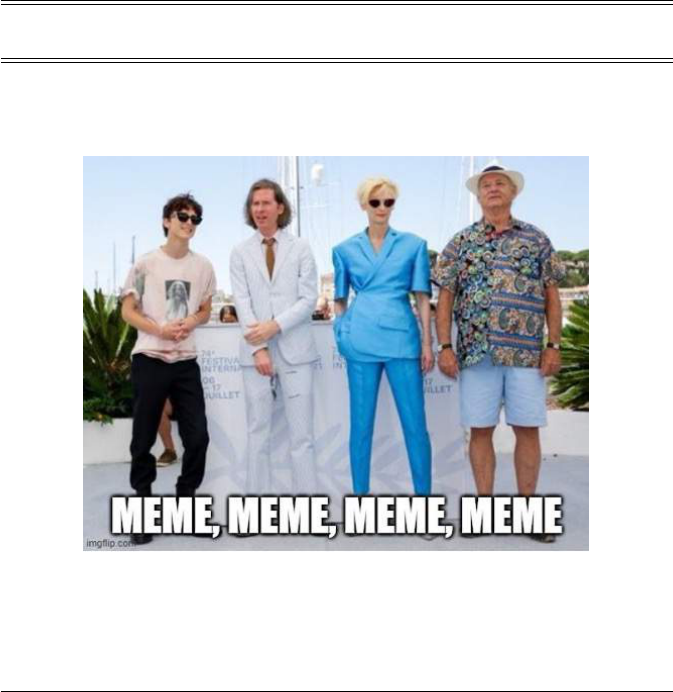
44159-nyu_97-2 Sheet No. 3 Side A 05/17/2022 12:35:30
44159-nyu_97-2 Sheet No. 3 Side A 05/17/2022 12:35:30
\\jciprod01\productn\N\NYU\97-2\NYU201.txt unknown Seq: 1 16-MAY-22 16:37
NEW YORK UNIVERSITY
LAW REVIEW
V
OLUME
97 M
AY
2022 N
UMBER
2
ARTICLES
MEMES ON MEMES AND THE NEW
CREATIVITY*
A
MY
A
DLER
† & J
EANNE
C. F
ROMER
‡
* Timoth´ee Chalamet, Wes Anderson, Tilda Swinton and Bill Murray at Cannes, K
NOW
Y
OUR
M
EME
, https://knowyourmeme.com/memes/timothee-chalamet-wes-anderson-tilda-
swinton-and-bill-murray-at-cannes [https://perma.cc/PF2D-KC2A].
† Emily Kempin Professor of Law, New York University School of Law.
‡ Professor of Law, New York University School of Law; Faculty Co-Director,
Engelberg Center on Innovation Law & Policy. We thank Cynthia Adler, Arnaud Ajdler,
Audrey C. Ajdler, Eric S. Ajdler, Olivia E. Ajdler, Rachel E. Barkow, Sunneal Bedi,
Barton C. Beebe, John Berton, Mala Chatterjee, James M. Chen, Kevin E. Davis, Charles
Duan, Brian L. Frye, Kristelia A. Garc´ıa, Clayton P. Gillette, Patrick Goold, Laura A.
Heymann, Samuel Issacharoff, Amy L. Landers, Stacey M. Lantagne, Mark A. Lemley,
Florencia Marotta-Wurgler, Michael Meurer, Peter Nicolas, Sean A. Pager, Amanda Reid,
Harry A. Robbins, Elizabeth L. Rosenblatt, Jennifer E. Rothman, Matthew Sag, Pamela
453

44159-nyu_97-2 Sheet No. 3 Side B 05/17/2022 12:35:30
44159-nyu_97-2 Sheet No. 3 Side B 05/17/2022 12:35:30
\\jciprod01\productn\N\NYU\97-2\NYU201.txt unknown Seq: 2 16-MAY-22 16:37
454 NEW YORK UNIVERSITY LAW REVIEW [Vol. 97:453
Memes are the paradigm of a new, flourishing creativity. Not only are these cap-
tioned images one of the most pervasive and important forms of online creativity,
but they also upend many of copyright law’s fundamental assumptions about crea-
tivity, commercialization, and distribution. Chief among these assumptions is that
copying is harmful. Not only does this mismatch threaten meme culture and expose
fundamental problems in copyright law and theory, but the mismatch is even more
significant because memes are far from an exceptional case. Indeed, memes are a
prototype of a new mode of creativity that is emerging in our contemporary digital
era, as can be seen across a range of works. Therefore, the concern with memes
signals a much broader problem in copyright law and theory. This is not to say that
the traditional creativity that copyright has long sought to protect is dead. Far from
it. Both paths of creativity, traditional and new, can be vibrant. Yet we must be
sensitive to the misfit between the new creativity and existing copyright law if we
want the new creativity to continue to thrive.
I
NTRODUCTION
. . . . . . . . . . . . . . . . . . . . . . . . . . . . . . . . . . . . . . . . . . . . . . . . . 456
R
I. C
OPYRIGHT ON
C
REATIVITY
, C
OMMERCIALIZATION
,
AND
D
ISTRIBUTION
. . . . . . . . . . . . . . . . . . . . . . . . . . . . . . . . . . . . . 459
R
A. Creativity Without Copying . . . . . . . . . . . . . . . . . . . . . . . . . 462
R
B. Morality and Economics of Copying . . . . . . . . . . . . . . . . 465
R
C. Profiting from Copyright . . . . . . . . . . . . . . . . . . . . . . . . . . . . 466
R
D. Idea and Expression as Distinct . . . . . . . . . . . . . . . . . . . . . 467
R
E. The Long Duration of Copyright . . . . . . . . . . . . . . . . . . . 469
R
F. Choosing Third Parties as Licensees . . . . . . . . . . . . . . . . 470
R
G. The Author’s Centrality . . . . . . . . . . . . . . . . . . . . . . . . . . . . . 472
R
II. M
EMES
. . . . . . . . . . . . . . . . . . . . . . . . . . . . . . . . . . . . . . . . . . . . . . . . . . 473
R
A. Overview. . . . . . . . . . . . . . . . . . . . . . . . . . . . . . . . . . . . . . . . . . . . 474
R
B. Why Memes Matter . . . . . . . . . . . . . . . . . . . . . . . . . . . . . . . . . 477
R
1. Newness . . . . . . . . . . . . . . . . . . . . . . . . . . . . . . . . . . . . . . . . 479
R
a. New Content . . . . . . . . . . . . . . . . . . . . . . . . . . . . . . . 480
R
b. Recontextualization . . . . . . . . . . . . . . . . . . . . . . . . . 481
R
c. Combinations . . . . . . . . . . . . . . . . . . . . . . . . . . . . . . . 482
R
2. Common Culture, Common Ground . . . . . . . . . . . . 483
R
3. Participatory Culture . . . . . . . . . . . . . . . . . . . . . . . . . . . . 484
R
4. The Attention Economy . . . . . . . . . . . . . . . . . . . . . . . . . 487
R
5. The Dangers of Memes . . . . . . . . . . . . . . . . . . . . . . . . . 489
R
C. Copyright Claims for Memes . . . . . . . . . . . . . . . . . . . . . . . . 492
R
Samuelson, Paul J. Sauerteig, Dalindyebo Shabalala, Jessica M. Silbey, Cathay Y.N. Smith,
Christopher Jon Sprigman, Madhavi Sunder, Naveen Thomas, Jacob Victor, Jeremy
Waldron, Joseph H.H. Weiler, Christopher Yoo, and participants at workshops at Drexel
University Thomas R. Kline School of Law, Michigan State University College of Law,
New York University School of Law, the Sixth Copyright Scholars Roundtable, the 2021
Intellectual Property Scholars Conference, and the 2020 Works in Progress in Intellectual
Property Colloquium for their attention-getting comments. Thanks to Siddharth
Anandalingam and Atreya Mathur for extraordinary research assistance. The authors
gratefully acknowledge support from the Filomen D’Agostino and Max E. Greenberg
Research Fund. Copyright
2022 by Amy Adler & Jeanne C. Fromer.
44159-nyu_97-2 Sheet No. 4 Side A 05/17/2022 12:35:30
44159-nyu_97-2 Sheet No. 4 Side A 05/17/2022 12:35:30
\\jciprod01\productn\N\NYU\97-2\NYU201.txt unknown Seq: 3 16-MAY-22 16:37
May 2022] MEMES ON MEMES AND THE NEW CREATIVITY 455
1. Litigation . . . . . . . . . . . . . . . . . . . . . . . . . . . . . . . . . . . . . . . 492
R
2. Credit . . . . . . . . . . . . . . . . . . . . . . . . . . . . . . . . . . . . . . . . . . . 500
R
3. Licensing . . . . . . . . . . . . . . . . . . . . . . . . . . . . . . . . . . . . . . . 502
R
III. H
OW
M
EMES
U
PEND
C
OPYRIGHT
’
S
N
OTIONS OF
C
REATIVITY
, C
OMMERCIALIZATION
,
AND
D
ISTRIBUTION
. . . . . . . . . . . . . . . . . . . . . . . . . . . . . . . . . . . . . . . . . . . 504
R
A. The Norms of Copying and Transformation . . . . . . . . 505
R
1. Copying. . . . . . . . . . . . . . . . . . . . . . . . . . . . . . . . . . . . . . . . . 506
R
2. Transformation . . . . . . . . . . . . . . . . . . . . . . . . . . . . . . . . . 509
R
B. The Creation of Value for Underlying Works
Through Copying . . . . . . . . . . . . . . . . . . . . . . . . . . . . . . . . . . . 510
R
C. Indirect Monetization of Works . . . . . . . . . . . . . . . . . . . . . 511
R
D. Line Between Commercial and Non-Commercial
Activity . . . . . . . . . . . . . . . . . . . . . . . . . . . . . . . . . . . . . . . . . . . . . 513
R
E. Breakdown of Idea-Expression Distinction . . . . . . . . . . 515
R
F. Scale and Pace of Copying . . . . . . . . . . . . . . . . . . . . . . . . . . 516
R
G. Staleness of Memes . . . . . . . . . . . . . . . . . . . . . . . . . . . . . . . . . 517
R
H. Selective Enforcement . . . . . . . . . . . . . . . . . . . . . . . . . . . . . . . 518
R
I. The Centrality of the Meme, Not the Author . . . . . . . . 519
R
IV. H
OW
S
HOULD
C
OPYRIGHT
L
AW
T
HINK
A
BOUT
M
EMES
? . . . . . . . . . . . . . . . . . . . . . . . . . . . . . . . . . . . . . . . . . . . . . . . . 524
R
A. Keep Copyright Law Away from Memes? . . . . . . . . . . 525
R
B. An Attribution Regime? . . . . . . . . . . . . . . . . . . . . . . . . . . . . . 529
R
C. A Shortened Duration? . . . . . . . . . . . . . . . . . . . . . . . . . . . . . 532
R
D. A Narrowed Copyright Scope? . . . . . . . . . . . . . . . . . . . . . . 534
R
E. Addressing Selective Enforcement . . . . . . . . . . . . . . . . . . . 536
R
1. The Worry of Forcing Creators to Allow
Universal Use . . . . . . . . . . . . . . . . . . . . . . . . . . . . . . . . . . . 539
R
2. The Worry of Selective Silencing . . . . . . . . . . . . . . . . 540
R
a. Nearly Everyone Gets to Use a Meme . . . . . 541
R
b. Except a Select Few . . . . . . . . . . . . . . . . . . . . . . . . 542
R
V. B
EYOND
M
EMES
. . . . . . . . . . . . . . . . . . . . . . . . . . . . . . . . . . . . . . . . 545
R
A. Traditional Works Can Be Like Memes . . . . . . . . . . . . . 546
R
B. Memes as a Paradigm of a New Model of
Creativity . . . . . . . . . . . . . . . . . . . . . . . . . . . . . . . . . . . . . . . . . . . 550
R
C. Trying to Make Memes More Like Traditional
Works. . . . . . . . . . . . . . . . . . . . . . . . . . . . . . . . . . . . . . . . . . . . . . . 561
R
C
ONCLUSION
. . . . . . . . . . . . . . . . . . . . . . . . . . . . . . . . . . . . . . . . . . . . . . . . . . . 563
R
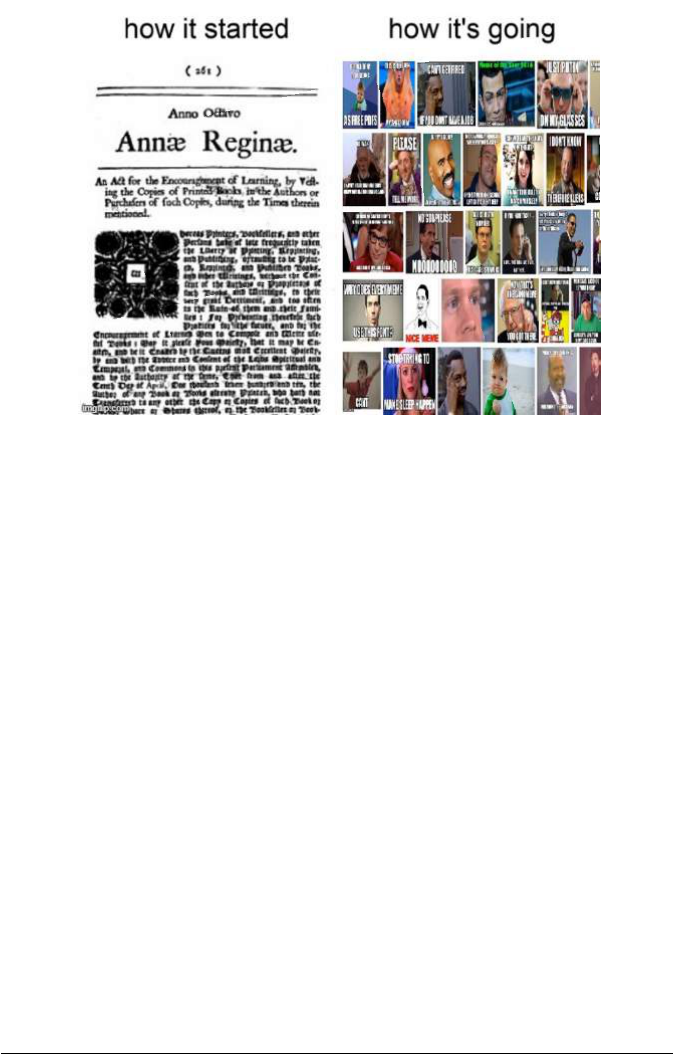
44159-nyu_97-2 Sheet No. 4 Side B 05/17/2022 12:35:30
44159-nyu_97-2 Sheet No. 4 Side B 05/17/2022 12:35:30
\\jciprod01\productn\N\NYU\97-2\NYU201.txt unknown Seq: 4 16-MAY-22 16:37
456 NEW YORK UNIVERSITY LAW REVIEW [Vol. 97:453
I
NTRODUCTION
1
Dating back centuries to its earliest enactments, copyright law
has longstanding, built-in notions about creativity, commercialization,
and distribution of creative works that memes turn on their head in
critical ways. Copyright law is constructed on many assumptions
flowing from its base premise that copyright’s exclusive rights to
authors can encourage them to create and distribute socially valuable
creative works by preventing third-party copying of these works.
2
Central among them are the assumptions that people can generally
create desirable works without much copying, that authors want their
works not to be copied without their permission because otherwise
they will be harmed and disincentivized to create, and that authors
can make money directly off their creative works by exercising their
exclusive rights. Additionally, copyright law dictates that expression
should be protected and ideas should be freely available for reuse,
presuming that idea and expression are distinct. The law also is predi-
cated on the view that authors will have a long period over which to
recoup value for their works, and these works can be valuable for a
very long time. Copyright law also supposes that authors can and
should decide which third parties get to use their works and when and
whether to enforce their rights against third parties who have copied.
Finally, copyright law assumes that authors can easily be identified
1
See How It Started vs. How It’s Going, K
NOW
Y
OUR
M
EME
, https://
knowyourmeme.com/memes/how-it-started-vs-how-its-going [https://perma.cc/LM76-
YV7K] (explaining the format of the “How It Started vs. How It’s Going” type of meme).
2
See infra Part I.

44159-nyu_97-2 Sheet No. 5 Side A 05/17/2022 12:35:30
44159-nyu_97-2 Sheet No. 5 Side A 05/17/2022 12:35:30
\\jciprod01\productn\N\NYU\97-2\NYU201.txt unknown Seq: 5 16-MAY-22 16:37
May 2022] MEMES ON MEMES AND THE NEW CREATIVITY 457
and are central figures who deserve to get the copyright reward for a
work.
Yet in the context of memes spread over the internet, these
assumptions break down in significant ways. For one thing, not only
do meme creators typically want to be copied as much as possible,
they also usually want their works to be transformed by third parties
in untold ways. The copying of memes tends to create significant value
for, rather than detract from, the underlying works on which they are
based. Memes also shatter copyright’s assumption that creative works
are directly monetizable, as memes are usually indirectly monetizable.
The world of memes transcends the line between commercial and
noncommercial activity, while copyright law treats these realms as dis-
tinct. Additionally, memes expose that expression in one context can
become idea in another context, breaking down copyright law’s dis-
tinct categories of unprotectable idea and protectable expression.
Also characteristic of memes is an exponential scale and pace of cop-
ying, which concomitantly expedites the staleness of existing works
and the pace of creation of new works. Moreover, the selective
enforcement that copyright law assumes is turned on its head by the
broad scale of permitted or tolerated copying, as almost all can copy a
work and only a very select few are denied permission to use the
underlying work. Finally, whereas copyright law assumes the cen-
trality of the author, in meme culture the work itself takes on a pri-
mary role over the author, who often cannot even be easily identified.
These features of memes reflect a new creativity that has progressed
far beyond the creativity analyzed at the beginning of the twenty-first
century for user-generated content.
Although memes are often designed to be eye-catching and
funny, they are serious and important in today’s world as one of the
most frequently created and shared categories of creative works on
the internet, especially on social media.
3
As such, the fact that they
upend so many of copyright law’s central assumptions of creativity,
commercialization, and distribution is worthy of attention. If meme
culture is worth safeguarding, attempts to enforce copyright law as is
with regard to memes are inappropriate given the substantial discon-
nect between memes and copyright law’s assumptions. Therefore, cop-
3
See infra Part II; see also David Ryan Polgar, Why Understanding Memes Is
Important to Grasping What People Are Really Saying in 2020, F
ORBES
(June 4, 2020),
https://www.forbes.com/sites/davidryanpolgar/2020/06/04/why-understanding-memes-and-
internet-humor-is-important-to-grasping-what-people-are-really-saying-in-2020 [https://
perma.cc/88GK-YEPR] (recognizing memes as a component of “the language people are
speaking on the web”).

44159-nyu_97-2 Sheet No. 5 Side B 05/17/2022 12:35:30
44159-nyu_97-2 Sheet No. 5 Side B 05/17/2022 12:35:30
\\jciprod01\productn\N\NYU\97-2\NYU201.txt unknown Seq: 6 16-MAY-22 16:37
458 NEW YORK UNIVERSITY LAW REVIEW [Vol. 97:453
yright law and theory must either be left to the wayside or refashioned
to account for memes.
But the problem goes well beyond memes. Indeed, memes herald
a much larger shift that is underway in contemporary creativity across
a range of areas, including music, dance, and visual art. As we show,
the problems that memes present are of increasing and widespread
significance to contemporary creators. This emerging creativity shares
multiple characteristics of memes and similarly defies copyright’s core
assumptions. By mapping out the dramatic disconnect between
memes—a paradigm of contemporary creativity—and copyright law
and theory, we can reflect back on the increasing outdatedness of cop-
yright’s core. We conclude by observing that there now seems to be
two paradigms of creativity—the traditional model and what we call
the “new creativity”—that can both remain extant, vibrant, and dis-
tinct, even though they are interconnected and influence one another.
Copyright law better fits with the traditional model but is a misfit to
the new creativity.
This Article explores these issues, organizing itself around a
series of memes we created that themselves reflect on memes.
4
Part I
sets forth the basic tenets of copyright law on creativity, commerciali-
zation, and distribution. Part II offers an overview of memes, presents
an argument for their significance, and outlines their current treat-
ment under copyright law. In Part III, we show how memes pose a
fundamental challenge to copyright law and theory by violating the
central copyright principles of creativity, commercialization, and dis-
tribution. Having established the disconnect between copyright law
and memes, Part IV considers whether and how copyright law could
be modified to account for memes. In Part V, we argue that memes
are far from a sui generis exception to the premises of copyright law.
Instead, memes are a prototype of a new mode of creativity that is
emerging in our contemporary digital era, as can be seen across a
range of works. Therefore, the concern with memes signals a much
broader problem in copyright law and theory.
4
The memes in this Article were made using Meme Generator,
IMGFLIP
, https://
imgflip.com/memegenerator [https://perma.cc/73D4-S4TF]. Each meme in this Article is
captioned with a corresponding section heading and footnoted with a source documenting
the meme’s background.
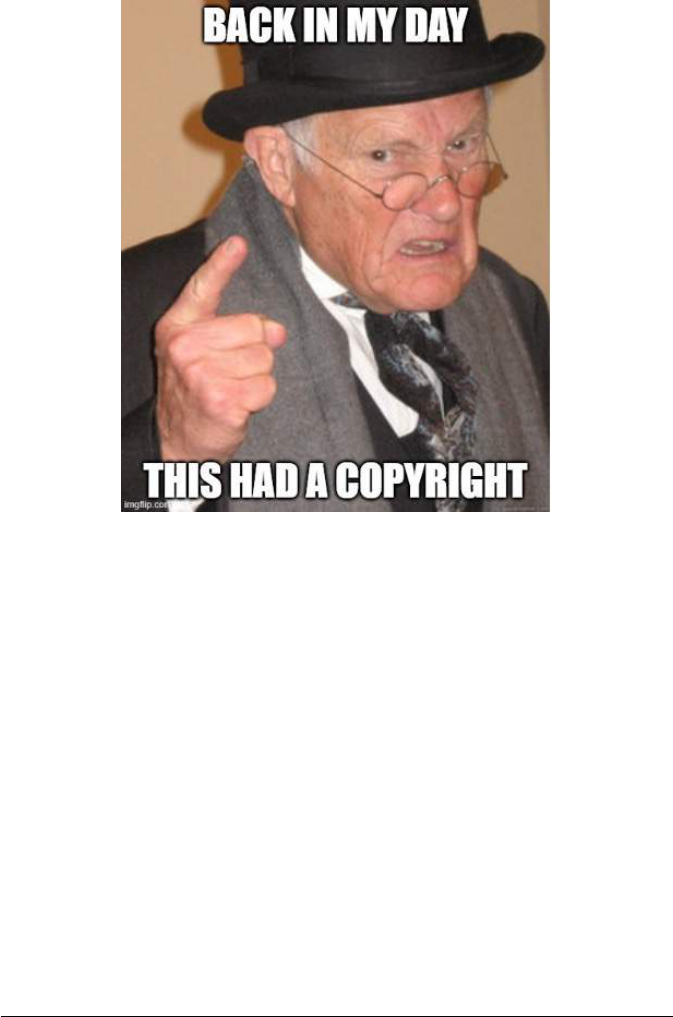
44159-nyu_97-2 Sheet No. 6 Side A 05/17/2022 12:35:30
44159-nyu_97-2 Sheet No. 6 Side A 05/17/2022 12:35:30
\\jciprod01\productn\N\NYU\97-2\NYU201.txt unknown Seq: 7 16-MAY-22 16:37
May 2022] MEMES ON MEMES AND THE NEW CREATIVITY 459
I
C
OPYRIGHT ON
C
REATIVITY
, C
OMMERCIALIZATION
,
AND
D
ISTRIBUTION
5
We launch our exploration of memes with background on copy-
right law’s deep-rooted assumptions of creativity, commercialization,
and distribution. These assumptions stem from copyright law’s over-
arching goal of encouraging the creation and distribution of expressive
works deemed to be socially valuable by providing their authors with
exclusive rights against copying.
In particular, American copyright law protects “original works of
authorship fixed in any tangible medium of expression,” including lit-
erary works, visual works, sound recordings, and movies.
6
A copyright
holder receives, among other things, the exclusive right to reproduce
the work, distribute copies, and prepare derivative works,
7
typically
until seventy years after the author’s death.
8
Copyright protection
extends to the expression of particular ideas rather than to the ideas
5
Grumpy Grandpa, K
NOW
Y
OUR
M
EME
, https://knowyourmeme.com/memes/
grumpy-grandpa [https://perma.cc/Z7EQ-U4S8].
6
17 U.S.C. § 102(a).
7
Id. § 106.
8
Id. § 302(a).

44159-nyu_97-2 Sheet No. 6 Side B 05/17/2022 12:35:30
44159-nyu_97-2 Sheet No. 6 Side B 05/17/2022 12:35:30
\\jciprod01\productn\N\NYU\97-2\NYU201.txt unknown Seq: 8 16-MAY-22 16:37
460 NEW YORK UNIVERSITY LAW REVIEW [Vol. 97:453
themselves.
9
Yet protection reaches well beyond the actual work to
works that are copied and substantially similar,
10
“else a plagiarist
would escape by immaterial variations.”
11
Utilitarianism is the dominant theory underpinning American
copyright law.
12
According to this theory, copyright law provides
authors the incentive of exclusive rights for a limited duration to moti-
vate them to create and distribute culturally valuable works.
13
Without this incentive, the theory goes, authors might not invest the
time, energy, and money necessary to create and distribute these
works because they might be copied cheaply and easily by free-riders,
eliminating the ability of authors to profit from their works.
14
Pursuant to utilitarian thinking, copyright law confers rights that
are designed to be limited in time and scope.
15
If the rights provided
are excessive, social welfare would be diminished.
16
For one thing,
exclusive rights in intellectual property can diminish competition by
allowing a rightsholder to charge a premium for access and ultimately
limit these valuable works’ diffusion to society at large.
17
For another,
given that knowledge is frequently cumulative, society benefits when
creators are permitted to build on previous artistic creations to gen-
erate new works.
18
For these reasons, copyright law ensures both that
the works it protects fall into the public domain in due course and that
third parties are free to use protected works for certain socially valu-
9
Id. § 102(b); see, e.g., Nichols v. Universal Pictures Corp., 45 F.2d 119, 121 (2d Cir.
1930) (explaining that creators do not have a property right in ideas that exist “apart from
their expression”).
10
Corwin v. Walt Disney Co., 475 F.3d 1239, 1253 (11th Cir. 2007).
11
Nichols, 45 F.2d at 121.
12
See Harper & Row, Publishers, Inc. v. Nation Enters., 471 U.S. 539, 557–58 (1985)
(reviewing past precedents characterizing copyright law as the best way to advance public
welfare); Shyamkrishna Balganesh, Foreseeability and Copyright Incentives, 122 H
ARV
. L.
R
EV
. 1569, 1576–77 (2009) (“[C]opyright law in the United States has undeniably come to
be understood almost entirely in utilitarian, incentive-driven terms.”); Jeanne C. Fromer,
Expressive Incentives in Intellectual Property, 98 V
A
. L. R
EV
. 1745, 1750–52 (2012)
[hereinafter Fromer, Expressive Incentives] (“The Supreme Court, Congress, and many
legal scholars consider utilitarianism the dominant purpose of American copyright . . .
law.” (footnote omitted)); William M. Landes & Richard A. Posner, An Economic
Analysis of Copyright Law, 18 J. L
EGAL
S
TUD
. 325, 326 (1989) (noting that intellectual
property is distinguished by its “‘public good’ aspect”).
13
See Stewart E. Sterk, Rhetoric and Reality in Copyright Law, 94 M
ICH
. L. R
EV
. 1197,
1203 (1996).
14
Id. at 1204.
15
Mark A. Lemley, The Economics of Improvement in Intellectual Property Law, 75
T
EX
. L. R
EV
. 989, 997 (1997).
16
See id. at 996–97.
17
Id.
18
Id. at 997–98; see also Campbell v. Acuff-Rose Music, Inc., 510 U.S. 569, 575–76
(1994) (discussing the policy benefits of the fair use doctrine, which limits a copyright
holder’s exclusive rights for certain socially beneficial uses).

44159-nyu_97-2 Sheet No. 7 Side A 05/17/2022 12:35:30
44159-nyu_97-2 Sheet No. 7 Side A 05/17/2022 12:35:30
\\jciprod01\productn\N\NYU\97-2\NYU201.txt unknown Seq: 9 16-MAY-22 16:37
May 2022] MEMES ON MEMES AND THE NEW CREATIVITY 461
able purposes.
19
In this way, a utilitarian theory of copyright law rests
on the premise that the benefit to society of creators crafting valuable
works in exchange for legal incentives offsets the social welfare
costs.
20
In recent years, scholars have questioned whether the copyright
incentive is necessary in the first instance to motivate people to create
expressive works. Some scholars have explored the vibrant expressive
activity occurring outside the realm of copyright, such as in cuisine,
stand-up comedy, and magic.
21
Others argue that in certain markets,
copyright law is unnecessary because the social norm of authenticity
incentivizes creativity.
22
Some scholars hypothesize that people would
create works absent copyright incentives, owing to intrinsic motivation
to do so.
23
Yet others think this skepticism is wrong or incomplete,
arguing that copyright’s incentive does encourage both creation and
distribution of works.
24
Indeed, rightly or wrongly, copyright’s incen-
tive theory remains front and center in copyright as currently
implemented.
With this background, we now explore how traditional copyright
theory and doctrine interrelate with the many assumptions copyright
law makes about creativity, commercialization, and distribution.
19
See Lemley, supra note 15, at 999.
20
Id. at 996–97.
21
See, e.g., Christopher J. Buccafusco, On the Legal Consequences of Sauces: Should
Thomas Keller’s Recipes Be Per Se Copyrightable?, 24 C
ARDOZO
A
RTS
& E
NT
. L.J. 1121
(2007); Emmanuelle Fauchart & Eric von Hippel, Norms-Based Intellectual Property
Systems: The Case of French Chefs, 19 O
RG
. S
CI
. 187 (2008); Dotan Oliar & Christopher
Sprigman, There’s No Free Laugh (Anymore): The Emergence of Intellectual Property
Norms and the Transformation of Stand-Up Comedy, 94 V
A
. L. R
EV
. 1787 (2008); Jacob
Loshin, Secrets Revealed: Protecting Magicians’ Intellectual Property Without Law, in L
AW
AND
M
AGIC
: A C
OLLECTION OF
E
SSAYS
123 (Christine A. Corcos ed., 2010).
22
See Amy Adler, Why Art Does Not Need Copyright, 86 G
EO
. W
ASH
. L. R
EV
. 313,
329–30 (2018) [hereinafter Adler, Why Art Does Not Need Copyright] (arguing that even if
we accept the utilitarian account of creativity, the necessary incentive for the creation of
visual art stems from the art market’s rigid norm of authenticity, and not at all from
copyright law).
23
E.g., Rebecca Tushnet, Economies of Desire: Fair Use and Marketplace Assumptions,
51 W
M
. & M
ARY
L. R
EV
. 513 (2009); Diane Leenheer Zimmerman, Copyrights as
Incentives: Did We Just Imagine That?, 12 T
HEORETICAL
I
NQUIRIES
L. 29 (2011). For a
survey of this literature and some theoretical and empirical skepticism about it, see
Christopher Buccafusco, Zachary C. Burns, Jeanne C. Fromer & Christopher Jon
Sprigman, Experimental Tests of Intellectual Property Laws’ Creativity Thresholds, 92 T
EX
.
L. R
EV
. 1921, 1931–43 (2014).
24
See Buccafusco, Burns, Fromer & Sprigman, supra note 23, at 1976, 1978–79; see also
Julie E. Cohen, Copyright as Property in the Post-Industrial Economy: A Research Agenda,
2011 W
IS
. L. R
EV
. 141, 143 (embracing the idea that creativity is not motivated by
copyright protections, but arguing that copyright is necessary for the efficient exploitation
of creative work by industry).
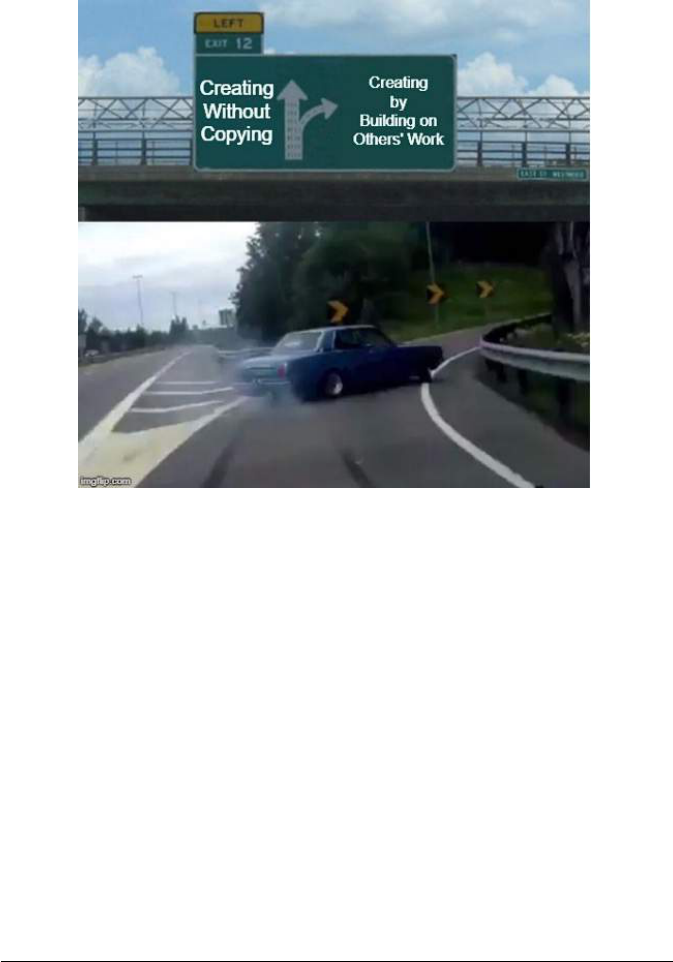
44159-nyu_97-2 Sheet No. 7 Side B 05/17/2022 12:35:30
44159-nyu_97-2 Sheet No. 7 Side B 05/17/2022 12:35:30
\\jciprod01\productn\N\NYU\97-2\NYU201.txt unknown Seq: 10 16-MAY-22 16:37
462 NEW YORK UNIVERSITY LAW REVIEW [Vol. 97:453
A. Creativity Without Copying
25
Copyright law is premised on authors producing creative works
without copying. Even though copyright law sometimes condones cop-
ying, in the main it is antagonistic to copying because of copyright’s
goals.
Two of copyright law’s central requirements underscore the law’s
rejection of creativity through copying. Consider first copyright’s orig-
inality requirement, which is a prerequisite for copyright protection.
26
The Supreme Court has held that work is original so long as it “was
independently created by the author (as opposed to copied from other
works), and that it possesses at least some minimal degree of crea-
tivity.”
27
A work must merely evidence “intellectual production, . . .
thought, and conception.”
28
Originality does not necessarily require
true novelty; a minimally creative work is protectable even if there is a
nearly identical work, so long as the other work was not copied.
29
As
Judge Learned Hand observed, “[I]f by some magic a man who had
25
Left Exit 12 Off Ramp, K
NOW
Y
OUR
M
EME
, https://knowyourmeme.com/memes/
left-exit-12-off-ramp [https://perma.cc/PKW2-4MAK].
26
17 U.S.C. § 102(a) (“Copyright protection subsists . . . in original works of authorship
fixed in any tangible medium of expression.”).
27
Feist Publ’ns, Inc. v. Rural Tel. Serv. Co., 499 U.S. 340, 345 (1991).
28
Id. at 362 (quoting Burrow-Giles Lithographic Co. v. Sarony, 111 U.S. 53, 59–60
(1884)).
29
Id. at 345–46.

44159-nyu_97-2 Sheet No. 8 Side A 05/17/2022 12:35:30
44159-nyu_97-2 Sheet No. 8 Side A 05/17/2022 12:35:30
\\jciprod01\productn\N\NYU\97-2\NYU201.txt unknown Seq: 11 16-MAY-22 16:37
May 2022] MEMES ON MEMES AND THE NEW CREATIVITY 463
never known it were to compose anew Keats’s Ode on a Grecian Urn,
he would be an ‘author,’ and, if he copyrighted it, others might not
copy that poem, though they might of course copy Keats’s.”
30
The
originality requirement as a threshold for copyright protection is thus
premised on an author’s independent creation of a work without
copying.
Now consider copyright law’s rule for infringement. A defen-
dant’s acts can be condemned as infringing only if the defendant actu-
ally copied the plaintiff’s copyrighted work in some capacity.
31
Hence,
a defendant’s independent creation is a full defense to an infringe-
ment claim.
32
That said, not all copying is ultimately forbidden. As the
Ninth Circuit has explained, “To infringe, the defendant must . . . copy
enough of the plaintiff’s expression . . . to render the two works sub-
stantially similar.”
33
Both copyright protection and infringement liability are accord-
ingly grounded in the notion that copying is harmful, something to be
avoided and condemned. One cannot garner copyright protection in
the first place by creating a work that copies from a preexisting work,
and one might be condemned to infringement liability if one has
copied, particularly if one has copied too much.
Both of these crucial aspects of copyright law underpin its
thinking about creativity: Copyright law seeks to and will encourage
creativity, but only that which occurs without much copying, if any.
That is, copyright law assumes that the socially valuable works it seeks
to encourage should occur without copying from others and will not
be considered infringing if they are not copied.
34
One might under-
stand this as a financial matter: It makes little sense to provide copy-
right’s incentives to someone who copies an existing work or to
condemn a third party who has not actually copied from an existing
work.
35
Otherwise, if copiers were granted the privileges of copyright,
the copyright incentive would be blunted by allowing secondcomers to
copy from and undercut the copyright incentive provided to the
firstcomer.
36
This antipathy toward copying can also be understood
30
Sheldon v. Metro-Goldwyn Pictures Corp., 81 F.2d 49, 54 (2d Cir. 1936).
31
See Design Basics, LLC v. Signature Constr., Inc., 994 F.3d 879, 887 (7th Cir. 2021).
32
See Skidmore v. Zeppelin, 952 F.3d 1051, 1064 (9th Cir. 2020).
33
Rentmeester v. Nike, Inc., 883 F.3d 1111, 1117 (9th Cir. 2018) (citing Mattel, Inc. v.
MGA Ent., Inc., 616 F.3d 904, 913–14 (9th Cir. 2010)) (internal marks omitted).
34
See Jeanne C. Fromer, A Psychology of Intellectual Property, 104 N
W
. U. L. R
EV
.
1441, 1443–44 (2010) [hereinafter Fromer, A Psychology of IP] (explaining and analyzing
the creativity that copyright and patent laws seek to promote).
35
See W
ILLIAM
M. L
ANDES
& R
ICHARD
A. P
OSNER
, T
HE
E
CONOMIC
S
TRUCTURE OF
I
NTELLECTUAL
P
ROPERTY
L
AW
85–91 (2003).
36
See id. at 87–91.

44159-nyu_97-2 Sheet No. 8 Side B 05/17/2022 12:35:30
44159-nyu_97-2 Sheet No. 8 Side B 05/17/2022 12:35:30
\\jciprod01\productn\N\NYU\97-2\NYU201.txt unknown Seq: 12 16-MAY-22 16:37
464 NEW YORK UNIVERSITY LAW REVIEW [Vol. 97:453
morally: Copyists are culpable—such as for appropriating someone
else’s creative labor—and ought to be discouraged.
37
Yet copyright’s reality is more complex. Copyright law sometimes
condones copying, most notably with regard to fair uses of a work.
38
The fair use doctrine is thought to stimulate the production of creative
works that do not undercut the value of the original copyrighted work
too much.
39
It does so by enabling third parties to create culturally
valuable works that must copy from the original work in some
capacity in order to succeed, often transforming it.
40
As suggested by
the statutory directive on fair use
41
and elaborated in case law, some
prototypical cases include news reporting, critical reviews, and paro-
dies.
42
Wendy Gordon has theorized that “fair use [has been used] to
permit uncompensated transfers that are socially desirable but not
capable of effectuation through the market.”
43
Examples include par-
odies that might cast an unfavorable light on an original work or uses
for which high transaction costs would discourage licensing arrange-
ments with the copyright owner.
44
This particularized authorization of some copying coincides with
scholarly recognition that copying can encourage creativity. For one
thing, scholars appreciate that artists may create by building on
others’ work or learn from existing works to create new work.
45
More
directly, scholars and courts recognize how important copying can be
to creating important new works, whether it be contemporary art like
Richard Prince’s, Star Trek fan fiction, or a new software implementa-
37
See Mala Chatterjee, Lockean Copyright Versus Lockean Property, 12 J. L
EGAL
A
NALYSIS
136, 153 (2020) (explaining copyright law through the lens of Lockean theory);
Patrick R. Goold, Moral Reflections on Strict Liability in Copyright, 44 C
OLUM
. J.L. &
A
RTS
123 (2021) (exploring how intuitive moral evaluations about copying are challenged
and subverted by the strict liability rules in copyright doctrine).
38
See 17 U.S.C. § 107 (listing circumstances in which “the fair use of a copyrighted
work . . . is not an infringement of copyright”); supra note 18 and accompanying text.
39
See Campbell v. Acuff-Rose Music, Inc., 510 U.S. 569, 577, 590–94 (1994) (discussing
how courts should consider market harms on the copyrighted work which result from the
copyright infringement in question).
40
See Pierre N. Leval, Commentary, Toward a Fair Use Standard, 103 H
ARV
. L. R
EV
.
1105, 1111–16 (1990) (arguing that whether or not the use of copyrighted material is
justified often depends on the extent to which the use of that material is transformative).
41
See 17 U.S.C. § 107 (listing non-exclusive factors to motivate a determination of fair
use).
42
See Campbell, 510 U.S. at 578–85 (parodies); Harper & Row, Publishers, Inc. v.
Nation Enters., 471 U.S. 539, 561 (1985) (news reporting); Sundeman v. Seajay Soc’y, Inc.,
142 F.3d 194, 206 (4th Cir. 1998) (critical review).
43
Wendy J. Gordon, Fair Use as Market Failure: A Structural and Economic Analysis
of the Betamax Case and Its Predecessors, 82 C
OLUM
. L. R
EV
. 1600, 1601 (1982).
44
Id. at 1633 (giving as one instance “the owner of a play [being] unlikely to license a
hostile review or a parody of his own drama” (footnote omitted)).
45
See, e.g., Fromer, A Psychology of IP, supra note 34, at 1461–62.

44159-nyu_97-2 Sheet No. 9 Side A 05/17/2022 12:35:30
44159-nyu_97-2 Sheet No. 9 Side A 05/17/2022 12:35:30
\\jciprod01\productn\N\NYU\97-2\NYU201.txt unknown Seq: 13 16-MAY-22 16:37
May 2022] MEMES ON MEMES AND THE NEW CREATIVITY 465
tion of the Java application program interface.
46
Moreover, as we have
previously observed, in light of today’s internet age, “as the entire
archive of past creative works becomes more accessible, creators will
have access to more past works to build on and copying will likely play
an even more significant role in creativity.”
47
Despite this scholarly recognition that fair use exists as one
among several important statutory exceptions to copyright infringe-
ment,
48
the “exemption” framework implicitly makes default the
assumption that creativity must be without copying. Copying some-
times can be condoned and important in copyright law, but it is the
exception rather than the norm.
49
B. Morality and Economics of Copying
50
Copyright law’s antipathy toward copying raises the question of
why copying is not condoned as a general matter. Copyright law takes
46
See, e.g., Google LLC v. Oracle Am., Inc., 141 S. Ct. 1183 (2021) (Java); Amy Adler,
Fair Use and the Future of Art, 91 N.Y.U. L. R
EV
. 559, 567–72 (2016) [hereinafter Adler,
Fair Use] (contemporary art); Rebecca Tushnet, Legal Fictions: Copyright, Fan Fiction, and
a New Common Law, 17 L
OY
. L.A. E
NT
. L.J. 651 (1997) (fan fiction).
47
Amy Adler & Jeanne C. Fromer, Taking Intellectual Property into Their Own Hands,
107 C
ALIF
. L. R
EV
. 1455, 1530 (2019) (footnote omitted).
48
See 17 U.S.C. §§ 107–122 (including, among others, reproductions by libraries and
archives (§ 108), ephemeral recordings (§ 112), and noncommercial broadcasting (§ 118)).
49
Cf. Shyamkrishna Balganesh, The Obligatory Structure of Copyright Law:
Unbundling the Wrong of Copying, 125 H
ARV
. L. R
EV
. 1664, 1666–74 (2012) (showing that
“much of copyright’s analytical work is done through its creation and maintenance of a
‘duty not to copy’”).
50
Steven Crowder’s “Change My Mind” Campus Sign, K
NOW
Y
OUR
M
EME
, https://
knowyourmeme.com/memes/steven-crowders-change-my-mind-campus-sign [https://
perma.cc/N6WP-SPT3].
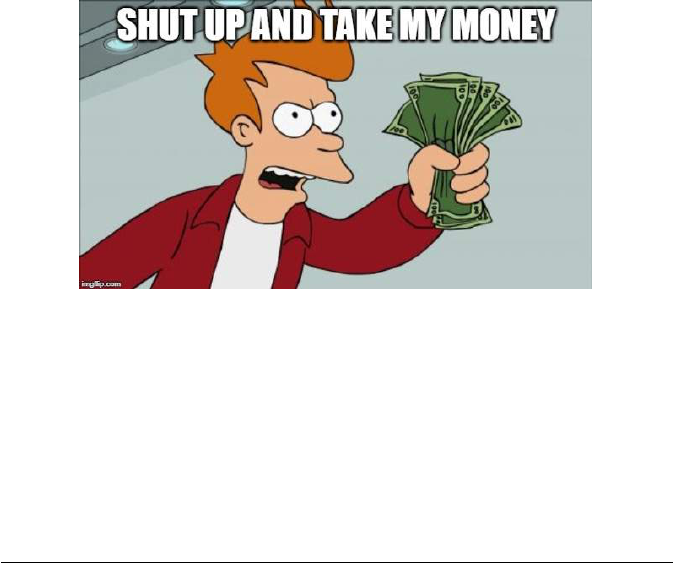
44159-nyu_97-2 Sheet No. 9 Side B 05/17/2022 12:35:30
44159-nyu_97-2 Sheet No. 9 Side B 05/17/2022 12:35:30
\\jciprod01\productn\N\NYU\97-2\NYU201.txt unknown Seq: 14 16-MAY-22 16:37
466 NEW YORK UNIVERSITY LAW REVIEW [Vol. 97:453
the position that copying someone’s creative work is generally
harmful, both economically and morally. For one thing, copying is
thought to be economically harmful in that it undermines the incen-
tive of creators to make valuable works.
51
Under this thinking, third
parties’ unauthorized copying undermines the original author’s exclu-
sive rights by allowing copiers to make the same work at a marginal
cost by avoiding the costs of creation.
52
Moreover, copying others’
work is condemned by some courts as lazy
53
and by some scholars as
immoral.
54
C. Profiting from Copyright
55
If copyright is thought to serve as an incentive to create, it func-
tions by awarding exclusive rights such that authors may directly
profit off their creative works. That is, authors can invoke copyright to
stop others from exercising any of copyright’s exclusive rights,
including reproducing, distributing, and publicly performing a work.
56
Authors can exercise these rights themselves,
57
thereby selling access
to their works in various ways. Because these rights are exclusive,
51
See L
ANDES
& P
OSNER
, supra note 35, at 85–91.
52
Id.
53
See, e.g., Kienitz v. Sconnie Nation LLC, 766 F.3d 756, 759 (7th Cir. 2014) (“The fair-
use privilege . . . is not designed to protect lazy appropriators.”); cf. Campbell v. Acuff-
Rose Music, Inc., 510 U.S. 569, 580 (1994) (observing that a fair use claim is less strong
when “the alleged infringer merely uses [the underlying work] to get attention or to avoid
the drudgery in working up something fresh”).
54
Balganesh, supra note 49, at 1679; Abraham Drassinower, Copyright Infringement as
Compelled Speech, in N
EW
F
RONTIERS IN THE
P
HILOSOPHY OF
I
NTELLECTUAL
P
ROPERTY
203, 205 (Annabelle Lever ed., 2012) (“[U]nauthorized use of another’s speech . . . den[ies
an author] the very autonomy manifested in and through her speech.”).
55
Shut Up and Take My Money!, K
NOW
Y
OUR
M
EME
, https://knowyourmeme.com/
memes/shut-up-and-take-my-money [https://perma.cc/A8B8-XAXG].
56
17 U.S.C. § 106.
57
Id.
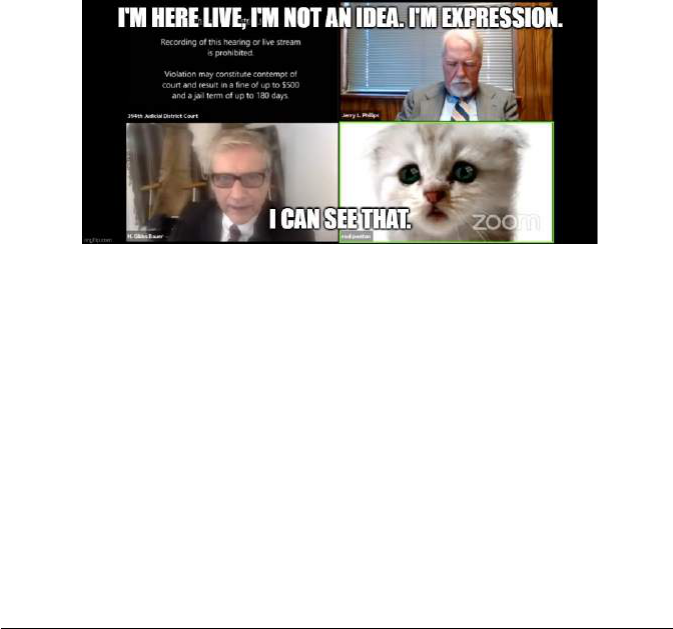
44159-nyu_97-2 Sheet No. 10 Side A 05/17/2022 12:35:30
44159-nyu_97-2 Sheet No. 10 Side A 05/17/2022 12:35:30
\\jciprod01\productn\N\NYU\97-2\NYU201.txt unknown Seq: 15 16-MAY-22 16:37
May 2022] MEMES ON MEMES AND THE NEW CREATIVITY 467
authors can typically sell their works at higher prices than they would
be able to without them.
58
Again, copying may interfere with an
author’s profits from these exclusive rights, thereby inflicting eco-
nomic (and moral) harms. By privatizing what would otherwise be a
freely copyable public good through the operation of law, copyright
makes protectable works monetizable.
D. Idea and Expression as Distinct
59
Beyond creativity and copying, copyright law has further rules
about what material is and is not protectable. In particular, copyright
law extends protection only to the expression of ideas; ideas them-
selves remain in the public domain.
60
For example, the expression in a
play about star-crossed lovers would be copyrightable, but the idea of
star-crossed lovers would not.
61
As the Supreme Court has explained,
ideas are excluded from the scope of copyright protection so that they
can be left free for all to use as building blocks to create further
expression.
62
Courts attribute this principle to protecting First
Amendment values.
63
58
See Pamela Samuelson, Allocating Ownership Rights in Computer-Generated Works,
47 U. P
ITT
. L. R
EV
. 1185, 1224–25 (1986).
59
Zoom Cat Lawyer / I’m Not a Cat, K
NOW
Y
OUR
M
EME
, https://knowyourmeme.com/
memes/zoom-cat-lawyer-im-not-a-cat [https://perma.cc/M6N7-42LA].
60
See supra note 9 and accompanying text.
61
See Nichols v. Universal Pictures Corp., 45 F.2d 119, 121–22 (2d Cir. 1930).
62
See Feist Publ’ns, Inc. v. Rural Tel. Serv. Co., 499 U.S. 340, 349–50 (1991).
63
See Harper & Row, Publishers, Inc. v. Nation Enters., 471 U.S. 539, 556 (1985); cf.
Jeanne C. Fromer, An Information Theory of Copyright Law, 64 E
MORY
L.J. 71, 97–102
(2014) [hereinafter Fromer, Information Theory] (“[T]he basic building blocks of
expression ought to be left freely available . . . . It would be both inefficient and unfair to
grant rights in these basic components . . . just because one person happened to employ
them first. Doing otherwise would ultimately be detrimental to generating a robust body of
authored works.” (footnotes omitted)).

44159-nyu_97-2 Sheet No. 10 Side B 05/17/2022 12:35:30
44159-nyu_97-2 Sheet No. 10 Side B 05/17/2022 12:35:30
\\jciprod01\productn\N\NYU\97-2\NYU201.txt unknown Seq: 16 16-MAY-22 16:37
468 NEW YORK UNIVERSITY LAW REVIEW [Vol. 97:453
Courts and scholars find it hard to distinguish between idea and
expression.
64
As Learned Hand influentially set up the analysis:
Upon any work, . . . a great number of patterns of increasing gener-
ality will fit equally well, as more and more of the incident is left
out. The last may perhaps be no more than the most general state-
ment of what [a work] is about, and at times might consist only of its
title; but there is a point in this series of abstractions where they are
no longer protected, since otherwise the [author] could prevent the
use of his ‘ideas,’ to which, apart from their expression, his property
is never extended.
65
Judge Hand then concludes, “Nobody has ever been able to fix that
boundary, and nobody ever can.”
66
Even so, courts have established a
doctrinal framework of abstraction and filtration to distinguish idea
from expression.
67
Despite the difficulty of distinguishing between the two catego-
ries, copyright law understands the categories to be distinct: one pro-
tectable, the other not.
68
Star-crossed lovers are always an
unprotectable idea, whereas the words in a play about star-crossed
lovers are always expression and thus potentially protectable.
64
See, e.g., Nichols, 45 F.2d at 121 (developing a framework for determining
infringement when no actual expression of the copyrighted work is taken and used in the
allegedly infringing work); see also Neil Weinstock Netanel, Copyright and a Democratic
Civil Society, 106 Y
ALE
L.J. 283, 304 (1996) (“[W]hile the idea/expression dichotomy
makes sense in principle, it is notoriously malleable and indeterminate.”).
65
Nichols, 45 F.2d at 121.
66
Id.
67
See id. at 121–23 (breaking down the structure and different elements of the
defendant’s allegedly infringing work (abstraction) to separate protectable expression from
an unprotectable idea (filtration), and holding, based on only the unfiltered elements that
were expression, that the defendant’s motion picture did not infringe the plaintiff’s play);
see also Comput. Assocs. Int’l, Inc. v. Altai, Inc., 982 F.2d 693, 706–10 (2d Cir. 1992) (using
the abstraction-filtration framework to determine whether the nonliteral elements of two
computer programs were substantially similar).
68
Even while explicitly recognizing the interconnection between expression and idea,
copyright’s merger doctrine nevertheless assumes a distinction. According to this doctrine,
when there are only a very limited number of ways to express an idea, idea and expression
are thought to have merged, rendering the expression just as uncopyrightable as the idea.
See Morrissey v. Procter & Gamble Co., 379 F.2d 675, 678–79 (1st Cir. 1967). The
expression in such cases is not protectable because were it otherwise, copyright law would
effectively be providing protection to the idea. See id.

44159-nyu_97-2 Sheet No. 11 Side A 05/17/2022 12:35:30
44159-nyu_97-2 Sheet No. 11 Side A 05/17/2022 12:35:30
\\jciprod01\productn\N\NYU\97-2\NYU201.txt unknown Seq: 17 16-MAY-22 16:37
May 2022] MEMES ON MEMES AND THE NEW CREATIVITY 469
E. The Long Duration of Copyright
69
If a work meets the various protectability requirements just dis-
cussed, it is typically protected by copyright law for a long time: gener-
ally, an author’s lifetime plus seventy years.
70
As a policy matter,
duration is premised on the period of time over which an author can
recoup value for their work.
71
As one of us has explained, Congress
has repeatedly extended copyright duration, asserting that it was
doing so to “account[] for increased average life expectancies for
authors and for the longer commercial life of works,” among other
reasons.
72
In fact, this duration can be so long that technologies of
dissemination and markets—such as the internet, social media, and
video cassettes—can develop in a way unforeseen to authors a century
or more ago when they first created their work.
73
69
This Meme Is from the Future, K
NOW
Y
OUR
M
EME
, https://knowyourmeme.com/
memes/this-meme-is-from-the-future [perma.cc/ES49-32CU].
70
See supra text accompanying note 8.
71
See Eldred v. Ashcroft, 537 U.S. 186, 205–08 (2003).
72
Fromer, Expressive Incentives, supra note 12, at 1799–1800.
73
See, e.g., Boosey & Hawkes Music Publishers, Ltd. v. Walt Disney Co., 145 F.3d 481
(2d Cir. 1998) (interpreting contract when the composer’s original piece was licensed for a
movie’s use in theaters but was later released on video cassettes); Rey v. Lafferty, 990 F.2d
1379 (1st Cir. 1993) (construing contract terms when a television program based on a series
of book was later released on video cassette). For an argument that copyright law should
not protect unforeseeable markets, see generally Balganesh, supra note 12.

44159-nyu_97-2 Sheet No. 11 Side B 05/17/2022 12:35:30
44159-nyu_97-2 Sheet No. 11 Side B 05/17/2022 12:35:30
\\jciprod01\productn\N\NYU\97-2\NYU201.txt unknown Seq: 18 16-MAY-22 16:37
470 NEW YORK UNIVERSITY LAW REVIEW [Vol. 97:453
Some argue that copyright protection lasts too long in ways that
undermine copyright’s goals, particularly because the commercial
value of works is not long enough to justify the increased costs that
copyright protection imposes on society. For example, Justice Breyer
expresses worry that too-long copyright duration imposes the cost of
“higher prices that will potentially restrict a work’s dissemination” on
society when “after 55 to 75 years, only 2% of all copyrights retain
commercial value.”
74
Similarly, Kristelia Garc´ıa and Justin McCrary
find in an empirical study that “for the average musical work, sales
drop sharply soon after release.”
75
Therefore, “for the average work,
the societal cost of strong copyright protection that goes beyond the
point of commercial viability outweighs the benefit to both creators
and consumers as the marginal return on this protection decreases
sharply.”
76
That said, the trend in copyright law since its earliest years
has been for copyright duration to be extended, never shrunk.
77
F. Choosing Third Parties as Licensees
78
Copyright law enables authors to transfer or license all or parts of
74
Eldred, 537 U.S. at 248, 254 (Breyer, J., dissenting) (citing Brief for Petitioners at 7,
Eldred, 537 U.S. 186 (2003) (No. 01-618); E
DWARD
R
APPAPORT
, C
ONG
. R
SCH
. S
ERV
.,
C
OPYRIGHT
T
ERM
E
XTENSION
: E
STIMATING THE
E
CONOMIC
V
ALUES
, C
ONGRESSIONAL
R
ESEARCH
S
ERVICE
R
EPORT FOR
C
ONGRESS
8, 12, 15, 16 (1998)).
75
Kristelia A. Garc´ıa & Justin McCrary, A Reconsideration of Copyright’s Term, 71
A
LA
. L. R
EV
. 351, 356 (2019).
76
Id.
77
See Fromer, Expressive Incentives, supra note 12, at 1799 (citing statutes); Sonny
Bono Copyright Term Extension Act, Pub. L. No. 105-298, 112 Stat. 2827 (1998) (codified
in scattered sections of 17 U.S.C.).
78
The Simpsons, K
NOW
Y
OUR
M
EME
, https://knowyourmeme.com/memes/subcultures/
the-simpsons [https://perma.cc/NZ4J-P7QN].

44159-nyu_97-2 Sheet No. 12 Side A 05/17/2022 12:35:30
44159-nyu_97-2 Sheet No. 12 Side A 05/17/2022 12:35:30
\\jciprod01\productn\N\NYU\97-2\NYU201.txt unknown Seq: 19 16-MAY-22 16:37
May 2022] MEMES ON MEMES AND THE NEW CREATIVITY 471
their exclusive rights to third parties.
79
The law also permits copyright
owners to enforce their rights by bringing an action for copyright
infringement.
80
These two aspects of copyright law imply that copy-
right owners get to decide which, if any, third parties can use their
works and when and whether to enforce their rights against third par-
ties who have copied their works without permission. Indeed, courts
have espoused the view that this is the copyright holder’s ultimate
choice. For instance, the Second Circuit has stated that copyright law
“must respect [the copyright holder’s] creative and economic choice”
to not exploit an aspect of their exclusive rights.
81
The copyright owner can grant a select few licenses that they
deem to be efficient. For example, an author of an English-language
book may grant a license to a particular translator to create a French-
language version of the book.
82
This is understood to be part and
parcel of the copyright incentive in the first instance, as a way to con-
trol who else, if anyone, can make works that might interfere with or
enhance the copyright holder’s market.
83
Moreover, even without
granting third parties permission to use a work, copyright owners may
tolerate infringing uses.
84
They might do so, as Tim Wu puts it, due to
“laziness or enforcement costs, a desire to create goodwill, or a calcu-
lation that the infringement creates an economic complement to the
copyrighted work.”
85
79
17 U.S.C. § 201(d) (“Any of the exclusive rights comprised in a copyright, including
any subdivision of any of the rights specified by [17 U.S.C. § 106], may be transferred . . .
and owned separately.”).
80
Id. § 501(b).
81
Castle Rock Ent., Inc. v. Carol Publ’g Grp., Inc., 150 F.3d 132, 146 (2d Cir. 1998)
(making this observation in a case in which the copyright holder of the Seinfeld television
series sued the maker of a trivia book about the series).
82
See Paul Goldstein, Derivative Rights and Derivative Works in Copyright, 30 J.
C
OPYRIGHT
S
OC
’
Y
U.S.A. 209, 227 (1983) (“[B]y securing exclusive rights to all derivative
markets, [17 U.S.C. § 106(2)] enables the copyright proprietor to select those towards
which it will direct investment.”).
83
See id.; cf. Jeanne C. Fromer & Mark A. Lemley, The Audience in Intellectual
Property Infringement, 112 M
ICH
. L. R
EV
. 1251, 1255 (2014) (arguing that copyright and
other intellectual property regimes “should require proof of both sufficient technical
similarity and market substitution” to find infringement).
84
See generally Tim Wu, Tolerated Use, 31 C
OLUM
. J.L. & A
RTS
617 (2008).
85
Id. at 619.
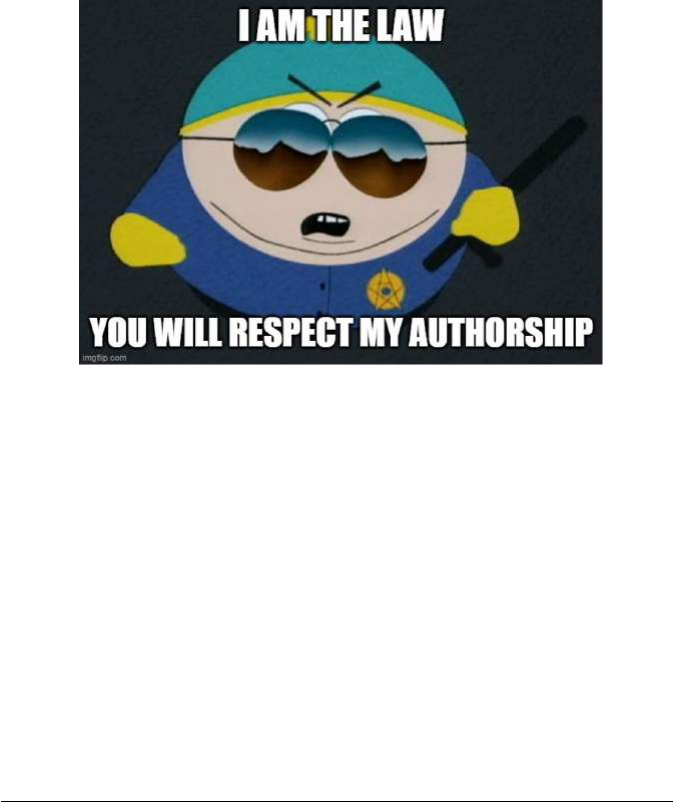
44159-nyu_97-2 Sheet No. 12 Side B 05/17/2022 12:35:30
44159-nyu_97-2 Sheet No. 12 Side B 05/17/2022 12:35:30
\\jciprod01\productn\N\NYU\97-2\NYU201.txt unknown Seq: 20 16-MAY-22 16:37
472 NEW YORK UNIVERSITY LAW REVIEW [Vol. 97:453
G. The Author’s Centrality
86
A final assumption on which copyright law is premised is that the
author is central and can generally readily be identified to get their
copyright reward. Copyright law situates initial protection in a work’s
author, be the work a single-authored work, a joint work, or a work
made for hire.
87
This grant follows from the constitutional grant of
power to Congress to confer copyright protection on authors for their
writings.
88
An abundance of critical scholarship attacks the assumption that
the author ought to be the central figure in copyright law deserving of
the reward, particularly when there are many others, including editors
and audiences, who contribute to a work and its value.
89
Stewart Sterk
goes further to underscore how rhetoric of the author’s centrality to
works has helped create and expand copyright rights, even beyond
what is necessary to achieve copyright’s goals.
90
86
Cartman Respect My Authoritah South Park, Y
OU
T
UBE
, at 0:08 (Oct. 28, 2013),
https://www.youtube.com/watch?v=XBebjUYItKw [https://perma.cc/HMN5-FJ46]; South
Park, K
NOW
Y
OUR
M
EME
, https://knowyourmeme.com/memes/subcultures/south-park
[https://perma.cc/CLW7-52SH].
87
17 U.S.C. §§ 201(a)–(b).
88
U.S. C
ONST
. art. I, § 8, cl. 8 (“Congress shall have Power . . . [t]o promote the
Progress of Science and useful Arts, by securing for limited Times to Authors and
Inventors the exclusive Right to their respective Writings and Discoveries.”).
89
E.g., M
ARK
R
OSE
, A
UTHORS AND
O
WNERS
: T
HE
I
NVENTION OF
C
OPYRIGHT
8 (1993)
(noting that authors “produce texts through complex processes of adaptation and
transformation”); T
HE
C
ONSTRUCTION OF
A
UTHORSHIP
: T
EXTUAL
A
PPROPRIATION IN
L
AW AND
L
ITERATURE
(Martha Woodmansee & Peter Jaszi eds., 1994) (collection of
papers on the issue of the author’s role in copyright law); Oren Bracha, The Ideology of
Authorship Revisited: Authors, Markets, and Liberal Values in Early American Copyright,
118 Y
ALE
L.J. 186 (2008).
90
Sterk, supra note 13, at 1197–98; accord Bracha, supra note 89, at 265–66.

44159-nyu_97-2 Sheet No. 13 Side A 05/17/2022 12:35:30
44159-nyu_97-2 Sheet No. 13 Side A 05/17/2022 12:35:30
\\jciprod01\productn\N\NYU\97-2\NYU201.txt unknown Seq: 21 16-MAY-22 16:37
May 2022] MEMES ON MEMES AND THE NEW CREATIVITY 473
Others accept the author’s centrality and seek to explain what
should qualify someone as an author. For example, Chris Buccafusco
theorizes that “to be an author of a writing, one must intend to pro-
duce some mental effect in an audience,” leading him to conclude that
garden designers, computer programmers, and others might be
authors.
91
Jane Ginsburg and Luke Budiardjo understand authorship
to be the conjunction of devising a creative plan for a work and physi-
cally executing the work.
92
Right or wrong, the author is copyright law’s central figure. With
these assumptions explored, we now turn to discuss memes.
II
M
EMES
93
In this Part, we introduce the surprisingly elastic and imprecise
definition of the term “meme,” laying bare the centrality of copying to
this category. We then consider the importance of memes by briefly
91
Christopher Buccafusco, A Theory of Copyright Authorship, 102 V
A
. L. R
EV
. 1229,
1232–33 (2016).
92
Jane C. Ginsburg & Luke Ali Budiardjo, Authors and Machines, 34 B
ERKELEY
T
ECH
. L.J. 343, 346 (2019) (applying that concept to assess when the human participants
who interact with artificially intelligent machines might be considered authors).
93
Draw 25, K
NOW
Y
OUR
M
EME
, https://knowyourmeme.com/memes/draw-25 [https://
perma.cc/7UHU-FUX8].
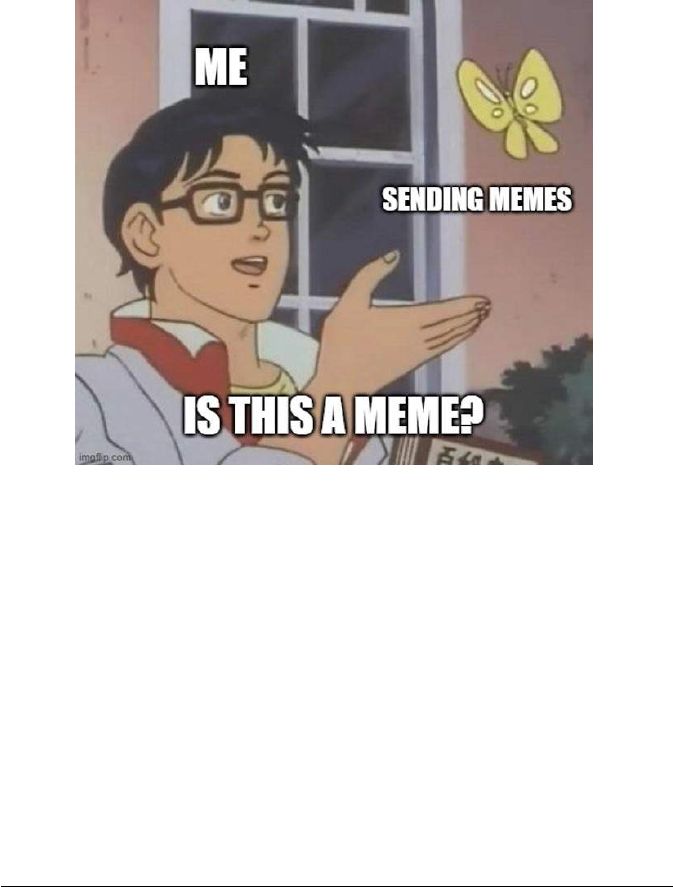
44159-nyu_97-2 Sheet No. 13 Side B 05/17/2022 12:35:30
44159-nyu_97-2 Sheet No. 13 Side B 05/17/2022 12:35:30
\\jciprod01\productn\N\NYU\97-2\NYU201.txt unknown Seq: 22 16-MAY-22 16:37
474 NEW YORK UNIVERSITY LAW REVIEW [Vol. 97:453
exploring their critical role in contemporary creativity, expression,
and political discourse.
A. Overview
94
“Meme” is a remarkably imprecise and elastic term. The scientist
Richard Dawkins coined the word in his influential 1976 book, The
Selfish Gene, to describe a “unit of cultural transmission” that repli-
cates and stays alive by “leaping from brain to brain.”
95
The term’s
origins stem from the conceptual analogy Dawkins drew between cul-
tural and biological evolution; Dawkins chose the word to sound like
“gene.”
96
But Dawkins’s neologism also had a second root that sig-
naled a second conceptual pillar of his theory: the central role of cop-
ying. He chose the term “meme” to reference the Greek word
“mimeme,” meaning “imitation.”
97
Since its invention, the term “meme” has mutated in meaning.
Dawkins used the term broadly to include things that propagate, sur-
vive, and ultimately penetrate cultures, such as “catch-phrases, clothes
94
Is This a Pigeon?, K
NOW
Y
OUR
M
EME
, https://knowyourmeme.com/memes/is-this-a-
pigeon [https://perma.cc/8PBP-424X].
95
R
ICHARD
D
AWKINS
, T
HE
S
ELFISH
G
ENE
249 (Oxford U. Press, Inc. 2016) (1976).
96
Id. Note that there are widespread debates in the field of memetics about this genetic
analogy, including questions it raises about the role of human agency in cultural memes.
See L
IMOR
S
HIFMAN
, M
EMES IN
D
IGITAL
C
ULTURE
10–12 (2013). We return to this debate
below in Section III.H, where we discuss the complexity of authorship in meme culture.
97
D
AWKINS
, supra note 95, at 249.

44159-nyu_97-2 Sheet No. 14 Side A 05/17/2022 12:35:30
44159-nyu_97-2 Sheet No. 14 Side A 05/17/2022 12:35:30
\\jciprod01\productn\N\NYU\97-2\NYU201.txt unknown Seq: 23 16-MAY-22 16:37
May 2022] MEMES ON MEMES AND THE NEW CREATIVITY 475
fashions, ways of making pots or of building arches,” and even the
idea of God.
98
Debates about the definition and nature of memes
have entered multiple disciplines, including psychology, communica-
tions, linguistics, anthropology, and philosophy.
99
Scholars routinely
note the word’s imprecision.
100
The colloquial usage of the term has shifted in the digital era to
become inextricably associated with the internet and digital life.
101
But even in this realm, the word is imprecise. In its broadest contem-
porary usage, “meme” applies to any viral sensation online, such as
trending hashtags or viral videos, or even to viral offline behaviors
that are spread by digital culture. Thus, innocuous (if sometimes non-
sensical) fads, like the plank trend
102
or TikTok dances,
103
have been
called “memes,” as have real-world fashion trends that initially spread
online, such as the alt-right fad of wearing Fred Perry shirts or the
Boogaloo Boys’ wearing of Hawaiian shirts.
104
The term has even pen-
etrated the stock market, where the term “meme stock” refers to
stocks such as GME (Gamestop) that see “sudden and dramatic
surges thanks to social media hype” while at the same time being con-
sidered “merely a joke.”
105
Indeed, some sources use the phrase
“meme culture” as a synonym for internet culture more broadly.
106
98
Id. at 249–50.
99
E.g., S
USAN
B
LACKMORE
, T
HE
M
EME
M
ACHINE
63–66 (1999); D
ANIEL
C. D
ENNETT
,
D
ARWIN
’
S
D
ANGEROUS
I
DEA
: E
VOLUTION AND THE
M
EANINGS OF
L
IFE
339–69 (1995);
K
ATE
D
ISTIN
, T
HE
S
ELFISH
M
EME
: A C
RITICAL
R
EASSESSMENT
(2005). For summaries of
scholarly debates in memetics about the definition and conceptual foundation of memes,
see Thomas F. Cotter, Memes and Copyright, 80 T
UL
. L. R
EV
. 331, 340–47 (2005); David
A. Simon, Culture, Creativity, & Copyright, 29 C
ARDOZO
A
RTS
& E
NT
. L.J. 279, 354–60
(2011).
100
See sources cited supra note 99.
101
See Olivia Solon, Richard Dawkins on the Internet’s Hijacking of the Word ‘Meme,’
W
IRED
UK (June 20, 2013), https://www.wired.co.uk/article/richard-dawkins-memes
[https://perma.cc/64CQ-C5ND]. The term had not yet acquired its present digital valence in
the early days of the internet. Writing in 1998, well before our current meme-driven
culture, Jack Balkin defined memes to include “skills, norms, ideas, beliefs, attitudes,
values, and other forms of information.” J
ACK
M. B
ALKIN
, C
ULTURAL
S
OFTWARE
: A
T
HEORY OF
I
DEOLOGY
43 (1998).
102
See Planking, K
NOW
Y
OUR
M
EME
, https://knowyourmeme.com/memes/planking
[https://perma.cc/77EZ-ZV4V].
103
See infra Section V.B.
104
See So, White Supremacists Ruined Another Shirt, I
N
S
TYLE
(Sept. 30, 2020), https://
www.instyle.com/fashion/clothing/fred-perry-proud-boys-polo [https://perma.cc/KF3S-
C2BY].
105
Brandon Michael, Top Meme Stocks to Buy Right Now? 5 In Focus,N
ASDAQ
(July 7,
2021), https://www.nasdaq.com/articles/top-meme-stocks-to-buy-right-now-5-in-focus-2021-
07-07 [https://perma.cc/6PLK-BH5Q].
106
See, e.g., Helen Lewis, The Joke’s on Us, A
TLANTIC
(Sept. 30, 2020), https://
www.theatlantic.com/international/archive/2020/09/how-memes-lulz-and-ironic-bigotry-
won-internet/616427 [https://perma.cc/F4TX-T3UT].

44159-nyu_97-2 Sheet No. 14 Side B 05/17/2022 12:35:30
44159-nyu_97-2 Sheet No. 14 Side B 05/17/2022 12:35:30
\\jciprod01\productn\N\NYU\97-2\NYU201.txt unknown Seq: 24 16-MAY-22 16:37
476 NEW YORK UNIVERSITY LAW REVIEW [Vol. 97:453
Other sources, however, reserve the word “meme” for a narrower
subset of digital life: digital images that are created and recreated by
continually “pasting captions onto other people’s photos,”
107
by
mixing images together, or by referring, sometimes obliquely, to pre-
vious images.
108
Meme scholar Limor Shifman emphasizes the
intertextual quality of such memes, defining them as “created with
awareness of each other, and . . . circulated, imitated, and/or trans-
formed via the Internet by many users.”
109
Note the visual nature of
memes in this narrower definition. Stacey Lantagne, for example,
describes memes as mutating “visual images that have morphed
beyond their origin to act as their own form of communicative short-
hand.”
110
Typically for digital memes of this sort, the visual image
remains relatively constant, and users change its meaning through new
text or juxtaposition with other images.
111
While we recognize the term’s imprecision, our focus here is on
this narrower subset of memes: viral visual images continually
remixed by multiple users, juxtaposed with text, or mixed with other
images, that ultimately become their own shorthand for meaning.
112
We consider this definition to be the most commonly used meaning of
the term in popular discourse—at least for now. The reader will note
that this Article’s illustrations are all examples of this core meaning of
the term.
Despite the term’s elasticity, one common thread runs through all
the various definitions, including ours: Memes are about copying, on a
large and widespread scale. Dawkins’s reference to “mimeme” or imi-
tation has persisted at the concept’s core. Whatever else a meme is, an
image (or phenomenon) becomes a meme only if it is widely
copied.
113
Thus, as we explore in Part III, the challenge memes pose to
copyright law could not be starker or more fundamental: Copyright
107
See, e.g., Stacey M. Lantagne, Famous on the Internet: The Spectrum of Internet
Memes and the Legal Challenge of Evolving Methods of Communication, 52 U. R
ICH
. L.
R
EV
. 387, 389 (2018); see also David Tan, Digital Memes, Fair Use, and the First
Amendment, J. I
NTERNET
L., May 2021, at 1, 23 (quoting B
RADLEY
E. W
IGGINS
, T
HE
D
ISCURSIVE
P
OWER OF
M
EMES IN
D
IGITAL
C
ULTURE
: I
DEOLOGY
, S
EMIOTICS
,
AND
I
NTERTEXTUALITY
11 (2019)) (noting the “remixed, iterated” nature of digital memes).
108
For example, the Bernie Sanders mittens meme that spread like wildfire after the
2021 presidential inauguration typically involved dropping the image of Sanders into new
settings, frequently without text. See infra notes 152–55 and accompanying text and
images.
109
S
HIFMAN
, supra note 96, at 41.
110
Lantagne, supra note 107, at 391.
111
Ronak Patel, First World Problems: A Fair Use Analysis of Internet Memes, 20
UCLA E
NT
. L. R
EV
. 235, 237 (2013).
112
See S
HIFMAN
, supra note 96, at 2–6.
113
See Terrica Carrington, Grumpy Cat or Copy Cat? Memetic Marketing in the Digital
Age, 7 G
EO
. M
ASON
J. I
NT
’
L
C
OM
. L. 139, 153 (2015).
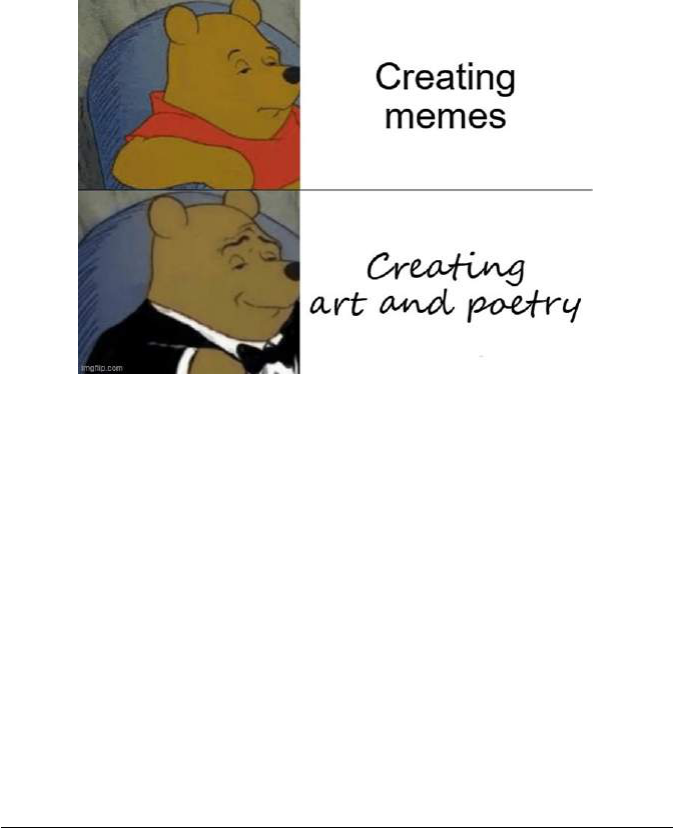
44159-nyu_97-2 Sheet No. 15 Side A 05/17/2022 12:35:30
44159-nyu_97-2 Sheet No. 15 Side A 05/17/2022 12:35:30
\\jciprod01\productn\N\NYU\97-2\NYU201.txt unknown Seq: 25 16-MAY-22 16:37
May 2022] MEMES ON MEMES AND THE NEW CREATIVITY 477
law at its core views unauthorized copying as a threat to creativity. Yet
memes, a paradigm of contemporary creativity,
114
owe their very exis-
tence to limitless, unauthorized, viral copying. These fundamental dif-
ferences lead to numerous disconnects between the use of memes and
traditional copyright law, which we explore in Part III.
B. Why Memes Matter
115
It may be tempting for academics to dismiss meme culture.
116
When you think of the prototypical meme user, you may picture a
Gen-Z teenager in a Reddit chatroom making inconsequential,
puerile jokes about pop culture. And unless you spend your life
online, memes frequently seem impenetrable, their meaning depen-
dent on multiple references to other memes and to (often trivial)
shards of pop culture.
117
Worse, if you invest time trying to puzzle out
a meme’s meaning, by the time you “get it,” it may already be old
news, and so many new ones have sprung up that your time spent
decoding may feel futile.
Despite this, we argue that legal scholars should take memes seri-
ously. Whether viewed from the perspective of copyright law (the
focus here), which values creativity, or First Amendment law, which
prizes a robust marketplace of ideas and political discourse, memes
114
See infra Section II.B.
115
Tuxedo Winnie the Pooh, K
NOW
Y
OUR
M
EME
, https://knowyourmeme.com/memes/
tuxedo-winnie-the-pooh [https://perma.cc/57BP-8939].
116
See S
HIFMAN
, supra note 96, at 2 (noting that the meme concept “has been the
subject of constant academic debate, derision, and even outright dismissal.”).
117
For discussion of the lo-fi aesthetic and the absurdist, ironic tone of meme culture, as
well as its origins on 4chan and later Reddit and Tumblr, see Lewis, supra note 106.

44159-nyu_97-2 Sheet No. 15 Side B 05/17/2022 12:35:30
44159-nyu_97-2 Sheet No. 15 Side B 05/17/2022 12:35:30
\\jciprod01\productn\N\NYU\97-2\NYU201.txt unknown Seq: 26 16-MAY-22 16:37
478 NEW YORK UNIVERSITY LAW REVIEW [Vol. 97:453
matter. We view them as a paradigm of contemporary creativity and a
powerful form of contemporary speech, often with significant political
consequences.
118
We see memes as paradigmatic of contemporary cultural expres-
sion because of the fundamental role copying plays in their production
(going back to the “mimeme” root of the word). As we have previ-
ously argued, while “creativity has always relied to some extent on
copying, the role of copying has taken on much greater urgency in our
contemporary digital culture.”
119
Thus, scholar Limor Shifman writes
that the “the meme concept encapsulates some of the most funda-
mental aspects of contemporary digital culture.”
120
A second aspect of memes also makes them paradigmatic for us:
They are primarily visual in nature. In most memes (but not all), an
image stays constant as the shortcut for meaning, but users continually
swap in new text. This reliance on the visual image also makes memes
emblematic of a larger shift through which “the image has surpassed
the word as the dominant mode of communication,” as one of us has
previously argued.
121
Indeed, Martin Gurri has observed of digital cul-
ture: “What is usually referred to as new media really means the tri-
umph of the image over the printed word.”
122
Moreover, memes matter because they are wildly popular and
one of the most commonly created, shared, and consumed types of
expression. As Fortune put it in 2016, “[f]or the first time ever, memes
are more popular than Jesus,” as “memes” became the most popular
Google search, beating “Jesus”—the most popular search term since
118
See, e.g., Joan Donovan, How Memes Got Weaponized: A Short History, MIT T
ECH
.
R
EV
. (Oct. 24, 2019), https://www.technologyreview.com/2019/10/24/132228/political-war-
memes-disinformation [https://perma.cc/F6DP-5FZ7] (noting the use of memes to create
misinformation both by domestic political activists and foreign operatives); Douglas
Haddow, Meme Warfare: How the Power of Mass Replication Has Poisoned the US
Election,G
UARDIAN
(Nov. 4, 2016), https://www.theguardian.com/us-news/2016/nov/04/
political-memes-2016-election-hillary-clinton-donald-trump [https://perma.cc/7AM6-9637]
(“[M]emes are ruining democracy.”); Kaitlyn Tiffany, The Story of the Internet, as Told by
Know Your Meme, V
ERGE
(Mar. 6, 2018), https://www.theverge.com/2018/3/6/17044344/
know-your-meme-10-year-anniversary-brad-kim-interview [https://perma.cc/TE8H-FMHP]
(quoting a technology journalist who describes Donald Trump as a “meme president” and
discusses the power of memes in “shaping public opinion”).
119
Adler & Fromer, supra note 47, at 1529.
120
S
HIFMAN
, supra note 96, at 4.
121
Amy Adler, The First Amendment and the Second Commandment, 57 N.Y.L. S
CH
. L.
R
EV
. 41, 42 (2013) [hereinafter Adler, First Amendment]; see also id. at 42–45 (discussing
how images have the power, unlike text, to be equated with what they represent, and
comparing the contemporary fascination with visual media to a “bewitching pull of
images” felt in ancient times).
122
M
ARTIN
G
URRI
, T
HE
R
EVOLT OF THE
P
UBLIC AND THE
C
RISIS OF
A
UTHORITY IN
THE
N
EW
M
ILLENNIUM
48 (2018).
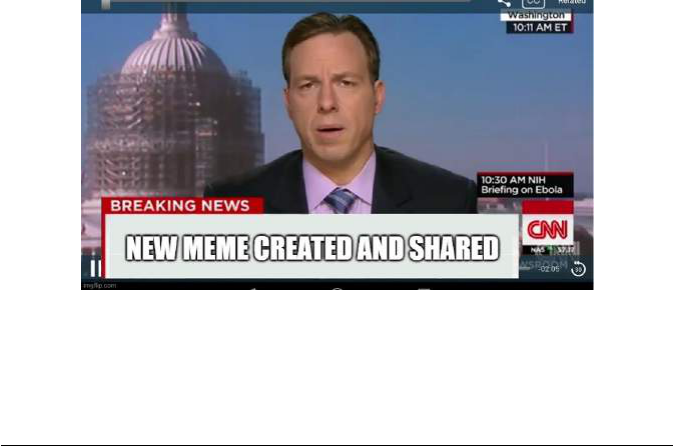
44159-nyu_97-2 Sheet No. 16 Side A 05/17/2022 12:35:30
44159-nyu_97-2 Sheet No. 16 Side A 05/17/2022 12:35:30
\\jciprod01\productn\N\NYU\97-2\NYU201.txt unknown Seq: 27 16-MAY-22 16:37
May 2022] MEMES ON MEMES AND THE NEW CREATIVITY 479
2011.
123
Not only are they searched for, but they are created and
shared constantly: Over one million meme posts were made by
Instagram users daily in 2020.
124
As Kaitlyn Tiffany explains,
“[m]emes and pop culture go hand-in-hand now. They don’t sit in sub-
forums and subreddits; they crop up in group chats and on your local
diner’s Instagram account.”
125
We return to these themes in Part V, but for now we note that
given the rising importance of copying to creativity, the move to an
image culture, and the extraordinary popularity of memes, memes
matter because in many ways they represent a paradigm case of a
more general aspect of contemporary speech and creativity.
In this Section, we explore the numerous ways that memes con-
tribute to society: principally newness, creation of common ground,
participatory culture, and providing ways to attract the scarce com-
modity of attention in our current world. We consider not only the
contributions memes make but also the dangers they pose to society.
1. Newness
126
As observed in Part I, the overarching goal of copyright is to
stimulate new works and to “create and disseminate ideas.”
127
Here
we briefly explore various ways in which memes fulfill this goal.
123
Madeline Farber, The Internet Officially Cares More About Memes than Jesus,
F
ORTUNE
(Oct. 27, 2016), https://fortune.com/2016/10/27/google-trends-memes-jesus
[https://perma.cc/R7FK-LRJD].
124
Instagram Year in Review: How Memes Were the Mood of 2020, I
NSTAGRAM
(Dec.
10, 2020), https://about.instagram.com/blog/announcements/instagram-year-in-review-how-
memes-were-the-mood-of-2020 [https://perma.cc/KAT6-4LX3].
125
Tiffany, supra note 118.
126
CNN Breaking News Template Meme Generator,
IMGFLIP
, https://imgflip.com/
memegenerator/79385373/cnn-breaking-news-template [https://perma.cc/T3CN-D2AT]; see
also Breaking News Parodies, K
NOW
Y
OUR
M
EME
, https://knowyourmeme.com/memes/
breaking-news-parodies [https://perma.cc/VA3Q-YV8Q].
127
Harper & Row, Publishers, Inc. v. Nation Enters., 471 U.S. 539, 558 (1985).
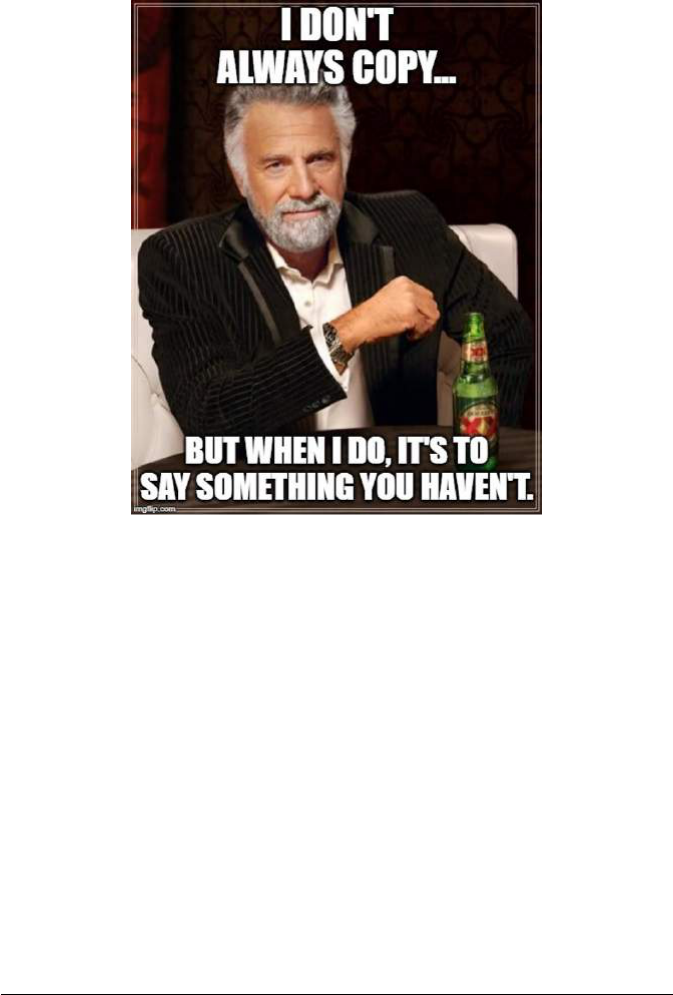
44159-nyu_97-2 Sheet No. 16 Side B 05/17/2022 12:35:30
44159-nyu_97-2 Sheet No. 16 Side B 05/17/2022 12:35:30
\\jciprod01\productn\N\NYU\97-2\NYU201.txt unknown Seq: 28 16-MAY-22 16:37
480 NEW YORK UNIVERSITY LAW REVIEW [Vol. 97:453
a. New Content
128
One thing memes do is contribute new content by copying.
Though that sounds paradoxical, consider the meme above, which
takes its image from a Dos Equis beer commercial featuring the pic-
tured actor as “the most interesting man,” in which he says, “I don’t
always drink beer, but when I do, I prefer Dos Equis.”
129
The image
was copied and memed by combining it with a similarly structured
phrase to convey what the Know Your Meme reference website
describes as a “highly charismatic and well-traveled gentleman with
refined tastes in many things” might say.
130
In less than three years,
one meme webpage collected more than 96,000 distinct submissions of
this meme and one Facebook page garnered 243,000 likes for the
meme.
131
The meme’s copying and spread facilitated new content
itself that was consumed widely.
128
The Most Interesting Man in the World, K
NOW
Y
OUR
M
EME
, https://
knowyourmeme.com/memes/the-most-interesting-man-in-the-world [https://perma.cc/
D7E3-D3N2].
129
Id.
130
Id.
131
Id.
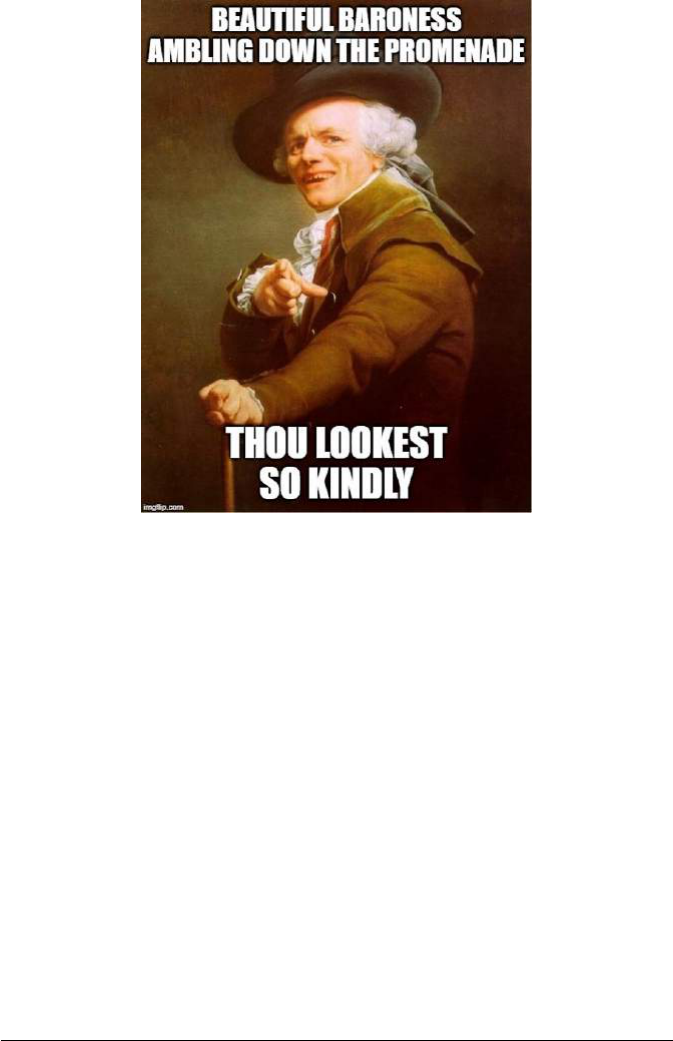
44159-nyu_97-2 Sheet No. 17 Side A 05/17/2022 12:35:30
44159-nyu_97-2 Sheet No. 17 Side A 05/17/2022 12:35:30
\\jciprod01\productn\N\NYU\97-2\NYU201.txt unknown Seq: 29 16-MAY-22 16:37
May 2022] MEMES ON MEMES AND THE NEW CREATIVITY 481
b. Recontextualization
132
Another way memes create new expression and meaning is by
recontextualizing existing works. The meme above is an example. The
painting, owned by the Louvre, is a self-portrait by the eighteenth-
century portraitist Joseph Ducreux. In its life as a meme, the image
has become a template on which users superimpose “archaic reinter-
pretation[s]” of popular rap lyrics.
133
Although there are extensive
variations, we include the image above because it is a version of the
opening line to Roy Orbison’s iconic song Oh, Pretty Woman—
“Pretty woman, walking down the street”—the subject of the
Supreme Court’s seminal copyright decision in Campbell v. Acuff-
Rose Music, Inc.
134
132
Joseph Ducreux / Archaic Rap, K
NOW
Y
OUR
M
EME
, https://knowyourmeme.com/
memes/joseph-ducreux-archaic-rap [https://perma.cc/CD6T-HWJR].
133
Id.
134
510 U.S. 569, 569, 594–97 (1994).

44159-nyu_97-2 Sheet No. 17 Side B 05/17/2022 12:35:30
44159-nyu_97-2 Sheet No. 17 Side B 05/17/2022 12:35:30
\\jciprod01\productn\N\NYU\97-2\NYU201.txt unknown Seq: 30 16-MAY-22 16:37
482 NEW YORK UNIVERSITY LAW REVIEW [Vol. 97:453
c. Combinations
135
Memes sometimes add new meaning to existing images by com-
bining works to make a mashup that then becomes a new meme of its
own with new meaning; the resulting combination might be called a
“supermeme.” For example, the reader may recognize the popular
supermeme pictured above, which is a remix of two preexisting
memes, one a still from a television episode of The Real Housewives
of Beverly Hills, and the other, a “confused cat at dinner” meme.
136
A
Twitter user combined these memes into a new image and shared it
online, remarking “[t]hese photos together [are] making me lose
it.”
137
The combination of these two images became so wildly popular
in 2019 that it became its own meme, Woman Yelling at a Cat, which
has been frequently copied as a template for new expression.
138
The
combined meme was even given a visual (fake) backstory of what hap-
pened to the woman and the cat.
139
135
Woman Yelling at a Cat, K
NOW
Y
OUR
M
EME
, https://knowyourmeme.com/memes/
woman-yelling-at-a-cat [https://perma.cc/P6GY-6FMA].
136
Id.
137
Id.
138
Id.; see also Is This a Pigeon?, supra note 94 (providing another example of a
supermeme).
139
See Giedre Vaiciulaityte, Artist Gives the “Woman Yelling at a Cat” Meme a Deep
Twist, B
ORED
P
ANDA
, https://www.boredpanda.com/woman-yelling-at-cat-comic-unfins
[https://perma.cc/7DTE-8RYW] (featuring a four-part comic series giving backstory to the
characters of the iconic meme).
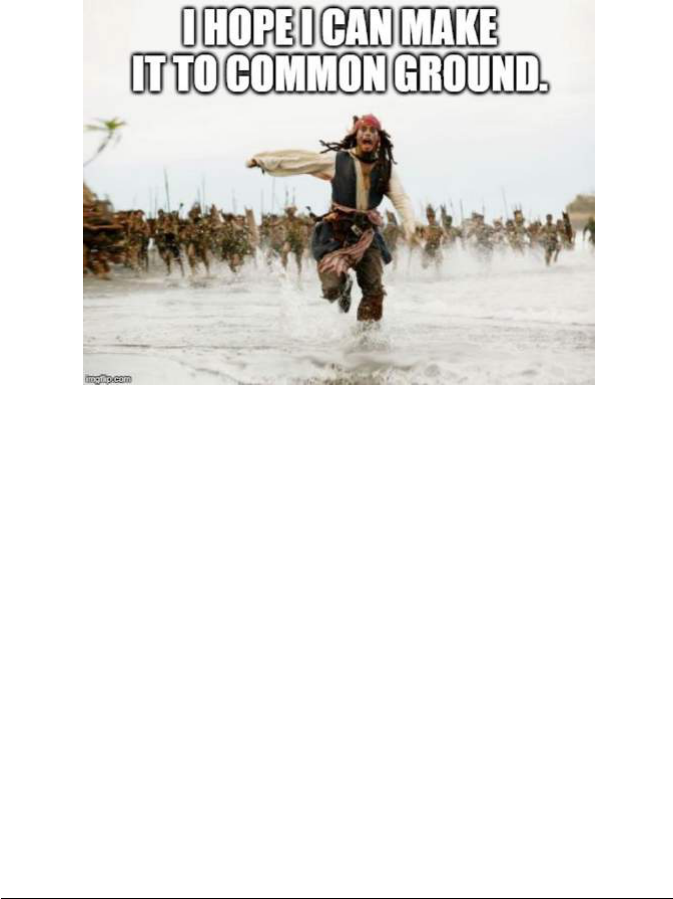
44159-nyu_97-2 Sheet No. 18 Side A 05/17/2022 12:35:30
44159-nyu_97-2 Sheet No. 18 Side A 05/17/2022 12:35:30
\\jciprod01\productn\N\NYU\97-2\NYU201.txt unknown Seq: 31 16-MAY-22 16:37
May 2022] MEMES ON MEMES AND THE NEW CREATIVITY 483
2. Common Culture, Common Ground
140
Memes also help forge a common culture by giving individuals
works through which they can connect with one another. Just as one
might share an aspect of Cinderella to communicate something about
evil stepmothers or princess fantasies, an individual can invoke a
widely shared meme to communicate a certain point, as well as to
signal that the speaker and the listener speak the same language.
141
In
light of this aspect of memes, linguists James Willmore and Darryl
Hocking call memes “fundamentally conversational in nature.”
142
They explain that “the locus of this conversational capacity lies in the
way that Internet memes employ the type of demotic creativity,
including repetition, pattern reformulation, punning, morphological
inventiveness, invented phrase, and figures of speech, that . . . are
common to everyday conversational language.”
143
Not only do memes contribute to common culture, but they also
draw on it. As communications scholar Rebecca Ortiz observes,
“[m]emes are only shareable when there’s something about them that
140
Jack Sparrow Being Chased,
IMGFLIP
, https://imgflip.com/memegenerator/Jack-
Sparrow-Being-Chased [https://perma.cc/6X6D-GNHC].
141
Cf. Cohen, supra note 24, at 147–48 (analyzing how copyright law plays a significant
role in producing as well as enabling access to a common culture, both directly and
indirectly); Rebecca Tushnet, Domain and Forum: Public Space, Public Freedom, 30
C
OLUM
. J.L. & A
RTS
597, 603 (2007) (“Like a shopping mall, Gone with the Wind is part of
our collective experience, even though it is also a private possession used to generate
revenue.”).
142
James Willmore & Darryl Hocking, Internet Meme Creativity as Everyday
Conversation, 2 J. A
SIA
-P
AC
. P
OP
C
ULTURE
140, 163 (2017).
143
Id.

44159-nyu_97-2 Sheet No. 18 Side B 05/17/2022 12:35:30
44159-nyu_97-2 Sheet No. 18 Side B 05/17/2022 12:35:30
\\jciprod01\productn\N\NYU\97-2\NYU201.txt unknown Seq: 32 16-MAY-22 16:37
484 NEW YORK UNIVERSITY LAW REVIEW [Vol. 97:453
. . . a select group of people can understand.”
144
A meme might
include an image from a popular children’s television show or use a
catchphrase uttered by a politician, and to be successful, it helps to
draw on common ground.
By both drawing on and contributing to common culture, memes
create what Ortiz describes as “an in-group connection.”
145
As she
elaborates, it might be “a group of billions” or more niche, but either
way, memes can help people “connect with somebody through these
shared meanings and cultural references” and “feel . . . special for
understanding it.”
146
Wilmore and Hocking further reflect that memes
“facilitate a sense of communal belonging and ideological alignment;
they are fun, spirited, and spontaneous; and they can also provoke
wider sociopolitical dialogue.”
147
3. Participatory Culture
148
Somewhat relatedly, meme culture is not top-down, with society
being fed expressive works and passively consuming them. Anyone
with a digital device and an internet connection can readily participate
in making and sharing memes. Rebecca Ortiz elaborates:
144
Emily Zemler, The Expansive Power of the Internet Meme, S
HONDALAND
(Oct. 15,
2020), https://www.shondaland.com/inspire/a34362565/instagram-10th-anniversary-power-
of-internet-meme [https://perma.cc/9EY4-CPJL] (quoting Ortiz).
145
Id.
146
Id.
147
Willmore & Hocking, supra note 142, at 163.
148
Oprah’s “You Get a Car,” K
NOW
Y
OUR
M
EME
, https://knowyourmeme.com/memes/
oprahs-you-get-a-car [https://perma.cc/5QLZ-ANQM].
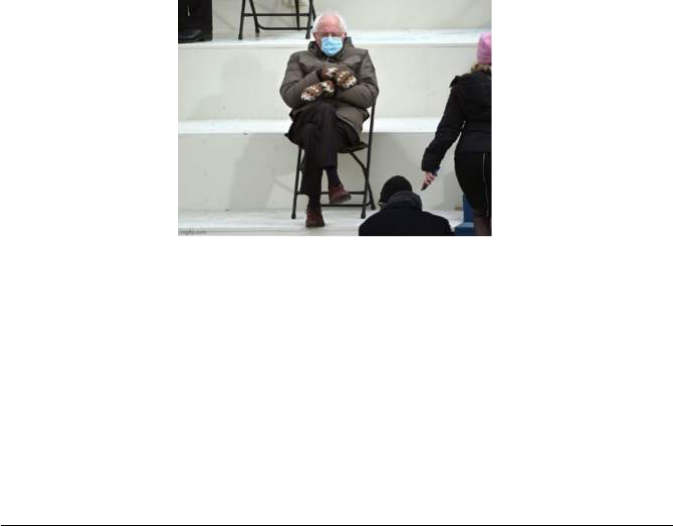
44159-nyu_97-2 Sheet No. 19 Side A 05/17/2022 12:35:30
44159-nyu_97-2 Sheet No. 19 Side A 05/17/2022 12:35:30
\\jciprod01\productn\N\NYU\97-2\NYU201.txt unknown Seq: 33 16-MAY-22 16:37
May 2022] MEMES ON MEMES AND THE NEW CREATIVITY 485
Anybody can be a producer, and that’s one key piece to this.
Because they’re not meant to be high production quality and
because they’re meant to be quickly thrown together in response to
what’s happening in the culture at that moment, it allows people to
become these media producers very quickly and very easily without
needing all the fancy knowledge or the fancy production quality.
149
Free online meme generators help users craft and adapt memes to
share, which they can easily do on a myriad of social media plat-
forms.
150
As one artist writes, memes “are the democratizing medium
of our collective digital present.”
151
Bernie Sanders Wearing Mittens Sitting in a Chair Meme
152
As just one example of the participatory culture fostered by
meme creation and sharing, consider the meme Bernie Sanders
Wearing Mittens Sitting in a Chair (shown above), widely spread and
transformed following the 2021 presidential inauguration of Joe
Biden. The image attracted attention in large part because Sanders’s
dress was less formal than that of others and was taken to convey that
Sanders would rather not have been there.
153
The initial tweets of this
image spread like wildfire
154
and in no time, others were placing
149
Zemler, supra note 144 (quoting Ortiz).
150
See David Nield, 6 Easy Ways to Make Your Own Memes, W
IRED
(May 30, 2021),
https://www.wired.com/story/6-easy-ways-make-memes [https://perma.cc/QR3T-LHU2]
(describing various online platforms which allow users to generate memes).
151
Alice Bucknell, What Memes Owe to Art History, A
RTSY
(May 30, 2017), https://
www.artsy.net/article/artsy-editorial-memes-owe-art-history [https://perma.cc/NW7X-
M5L6] (arguing that memes, similar to 1960s performance art, “offer a highly accessible
and interactive platform of production that is ripe for challenge and dissent, with
disagreements and controversy only fueling the fire of a successful meme truly going
viral”).
152
Bernie Sanders Wearing Mittens Sitting in a Chair, K
NOW
Y
OUR
M
EME
, https://
knowyourmeme.com/memes/bernie-sanders-wearing-mittens-sitting-in-a-chair [https://
perma.cc/9E2L-XTR5].
153
See id.
154
Id. (explaining that, for example, one reporter’s post about the photo was retweeted
46,000 times within twenty-four hours).

44159-nyu_97-2 Sheet No. 19 Side B 05/17/2022 12:35:30
44159-nyu_97-2 Sheet No. 19 Side B 05/17/2022 12:35:30
\\jciprod01\productn\N\NYU\97-2\NYU201.txt unknown Seq: 34 16-MAY-22 16:37
486 NEW YORK UNIVERSITY LAW REVIEW [Vol. 97:453
Sanders in all sorts of other settings—be they historic periods, paint-
ings, or other memes (some of which are sampled below).
Subsequent Variations of Bernie Sanders Wearing Mittens Sitting in a Chair Meme
155
155
Bernie Sanders Wearing Mittens Sitting in a Chair – Chairman Bernie’s on the Moon,
K
NOW
Y
OUR
M
EME
, https://knowyourmeme.com/photos/1998652-bernie-sanders-wearing-
mittens-sitting-in-a-chair [https://perma.cc/UUJ5-2QGW]; Chicago Claims Dibs on Best
Sanders Memes, WTTW (Jan. 21, 2021), https://news.wttw.com/2021/01/21/chicago-claims-
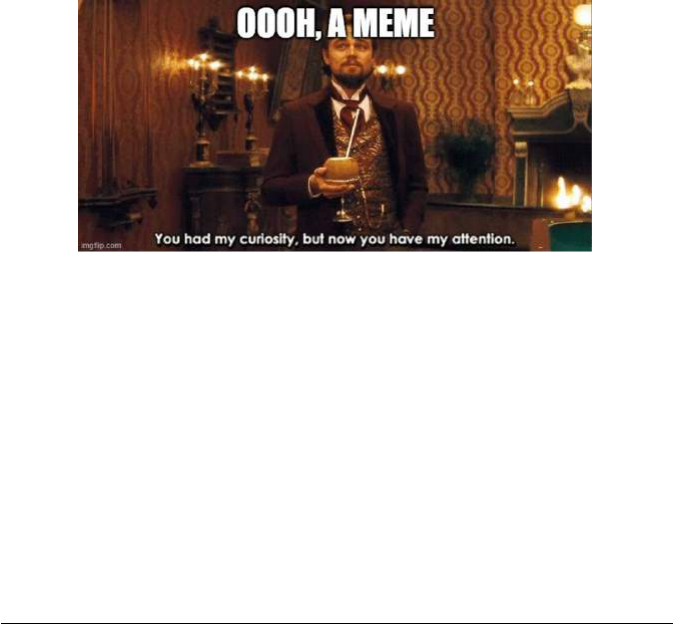
44159-nyu_97-2 Sheet No. 20 Side A 05/17/2022 12:35:30
44159-nyu_97-2 Sheet No. 20 Side A 05/17/2022 12:35:30
\\jciprod01\productn\N\NYU\97-2\NYU201.txt unknown Seq: 35 16-MAY-22 16:37
May 2022] MEMES ON MEMES AND THE NEW CREATIVITY 487
4. The Attention Economy
156
Memes are also particularly valuable in contemporary culture
because they allow creators to draw attention to their ideas in a world
in which attention is scarce and speech is cheap. As the internet has
dramatically reduced the costs of producing and disseminating
works,
157
we are now drowning in information.
158
The real barrier for
creators is no longer what it costs to create and distribute work, but
instead the problem of how to gain anyone’s attention in a world of
information overload. We posit that memes are perfect modes of
expression for speakers in our attention-scarce world.
159
Immediately
recognizable, funny, and attention-grabbing, memes can be consumed
almost instantaneously by viewers suffering from shorter and shorter
dibs-best-sanders-memes [https://perma.cc/QWF5-YPHT]; Bernie Sanders Wearing Mittens
Sitting in a Chair – Skyscraper Lunch, K
NOW
Y
OUR
M
EME
, https://knowyourmeme.com/
photos/1998018-bernie-sanders-wearing-mittens-sitting-in-a-chair [https://perma.cc/Y98U-
BFVW]; Amit Paranjape (@aparanjape), T
WITTER
(Jan. 23, 2021, 2:31 AM), https://
twitter.com/aparanjape/status/1352881716273111041 [https://perma.cc/W8CW-AXDH].
156
Calvin Candie Meme Generator,
IMGFLIP
, https://imgflip.com/memegenerator/
49576512/calvin-candie [https://perma.cc/CM7D-W483]; see also Calvin Candie, K
NOW
Y
OUR
M
EME
, https://knowyourmeme.com/memes/calvin-candie [https://perma.cc/WW4A-
ENYV].
157
See Mark A. Lemley, IP in a World Without Scarcity, 90 N.Y.U. L. R
EV
. 460, 507
(2015) (“Once creation is cheap enough, people may do it without the need for any IP
incentive.”); cf. Jake Linford, Copyright and Attention Scarcity, 42 C
ARDOZO
L. R
EV
. 143
(2020) (considering how preserving copyright protection can lower attention costs).
158
See, e.g., Adler, Fair Use, supra note 46, at 572 (arguing that we are now “drowning”
in a “sea of images”); Julie E. Cohen, The Regulatory State in the Information Age, 17
T
HEORETICAL
I
NQUIRIES
L. 369, 384 (2016) (using the term “infoglut” to describe how
sophisticated speakers can create confusion and undermine certainty by overloading the
public with speech); Tim Wu, Is the First Amendment Obsolete?, 117 M
ICH
. L. R
EV
. 547,
554–56 (2018) (discussing three technological and economic developments which have led
to a flood of information, and positing that “[i]f it was once hard to speak, it is now hard to
be heard”).
159
See Felix Salmon, The Musk Meme Economy, A
XIOS
(Feb. 9, 2021), https://
www.axios.com/meme-economy-tesla-elon-musk-c1e9c225-d8e2-4953-a591-
0a29dacf2d4a.html [https://perma.cc/ELM6-VDEB] (“Attention is a commodity, which
means that memes—a way of focusing and scaling attention—are a way to create value.”).

44159-nyu_97-2 Sheet No. 20 Side B 05/17/2022 12:35:30
44159-nyu_97-2 Sheet No. 20 Side B 05/17/2022 12:35:30
\\jciprod01\productn\N\NYU\97-2\NYU201.txt unknown Seq: 36 16-MAY-22 16:37
488 NEW YORK UNIVERSITY LAW REVIEW [Vol. 97:453
attention spans.
160
The visual nature of memes facilitates this quick-
ness; as the Supreme Court observed long ago, visual images can be “a
short cut from mind to mind.”
161
As the Senior Editor of meme refer-
ence site Know Your Meme states:
The best memes are able to get a very specific idea across using very
few words and a clear photograph or video. Based on how well
those ideas are communicated, other people share them. There are
other factors involved—who is sharing it, their follower count, who
sees it, what platform it’s on—but if you boil it all down, it’s about
that economy.
162
Indeed, mathematical studies of memes show how they compete,
often effectively, for limited user attention.
163
In the First Amendment context, Tim Wu and others have
famously observed that the digital age has ushered in a new “attention
economy”
164
in which it is no longer speech that is scarce, but rather
listeners’ attention.
165
While Wu focuses on the rise of “attention
merchants”—businesses like Facebook and others that exploit and
resell our limited attention (and privacy)
166
—here we consider the rel-
evance of the attention economy to individual speakers rather than
platforms. Communicating by meme is a hack that gives individual
speakers a fighting chance to be heard in our attention-scarce world.
160
We hope we have grabbed your attention by organizing this Article around memes.
We could have written this Article without them, but would you have read until this point?
161
W. Va. State Bd. of Educ. v. Barnette, 319 U.S. 624, 632 (1943) (discussing this idea
with respect to flags and emblems).
162
Zemler, supra note 144 (quoting Matt Schimkowitz).
163
See generally James P. Gleeson, Kevin P. O’Sullivan, Raquel A. Ba ˜nos & Yamir
Moreno, Effects of Network Structure, Competition and Memory Time on Social Spreading
Phenomena, 6 P
HYS
. R
EV
. X 021019 (2016) (distinguishing the roles of two factors
affecting meme popularity: the memory time of users and the connectivity structure of the
social network).
164
Tim Wu, Blind Spot: The Attention Economy and the Law, 82 A
NTITRUST
L.J. 771
(2019).
165
See Wu, supra note 158, at 548; see also Ellen P. Goodman, Media Policy out of the
Box: Content Abundance, Attention Scarcity, and the Failures of Digital Markets, 19
B
ERKELEY
T
ECH
. L.J. 1389, 1392–93 (2004) (explaining that digital innovations have
“multiplied content and freed audiences from network schedules”); G. Michael Parsons,
Fighting for Attention: Democracy, Free Speech, and the Marketplace of Ideas, 104 M
INN
. L.
R
EV
. 2157, 2160 (2020) (arguing that the “marketplace for ideas” theory in First
Amendment analysis should be built around attention).
166
See generally T
IM
W
U
, T
HE
A
TTENTION
M
ERCHANTS
: T
HE
E
PIC
S
TRUGGLE TO
G
ET
I
NSIDE
O
UR
H
EADS
(2016).

44159-nyu_97-2 Sheet No. 21 Side A 05/17/2022 12:35:30
44159-nyu_97-2 Sheet No. 21 Side A 05/17/2022 12:35:30
\\jciprod01\productn\N\NYU\97-2\NYU201.txt unknown Seq: 37 16-MAY-22 16:37
May 2022] MEMES ON MEMES AND THE NEW CREATIVITY 489
5. The Dangers of Memes
167
Memes, as a medium of communication, are not inherently good
or bad. But it is inescapable that in recent years, in addition to
spreading fun jokes and pictures of cats, memes have also been lever-
aged by extremist groups to spread propaganda, hate, and disinforma-
tion.
168
One prominent example comes from the fringe alt-right’s use
of sites like 4chan to weaponize hateful, racist, and antisemitic memes
and to spread them into mainstream politics.
169
For example, the neo-
Nazi site The Daily Stormer holds a weekly “Memetic Monday” in
which they post image macros for memes designed to be shared on
Facebook and Twitter.
170
One scholar argues that the fringe alt-right is
so masterful at using memes to spread its views that it actually
“memed Donald Trump into office.”
171
The alt-right’s mastery of the
167
Marked Safe, S
LANG
L
ANG
, https://www.slanglang.net/memes/marked-safe [https://
perma.cc/7HK2-KJX6].
168
A high-profile example comes from the Pepe the Frog meme, discussed below in
Section II.C.1. Even if the alt-right has been adept at leveraging memes, they can be
marshalled in any political direction. That does not erase, however, their ability to coarsen
and polarize our discourse, to spread disinformation, and, in doing so, to create threats to
our national security. See generally Donovan, supra note 118.
169
See A
LICE
M
ARWICK
& R
EBECCA
L
EWIS
, D
ATA
& S
OC
’
Y
R
SCH
. I
NST
., M
EDIA
M
ANIPULATION AND
D
ISINFORMATION
O
NLINE
36 (2017), https://datasociety.net/pubs/oh/
DataAndSociety_MediaManipulationAndDisinformationOnline.pdf [https://perma.cc/
R8GV-FQZN] (discussing the alt-right’s use of memes as propaganda); see also Emiliano
De Cristofaro, Memes Are Taking the Alt-Right’s Message of Hate Mainstream,
C
ONVERSATION
(Dec. 12, 2018), https://theconversation.com/memes-are-taking-the-alt-
rights-message-of-hate-mainstream-108196 [https://perma.cc/8FNC-9XHA] (describing a
study finding that the alt-right web communities, such as 4chan’s “Politically Incorrect”
board (/pol/), generated “a wide variety of racist, hateful, and politically charged memes”
and spread them to other parts of the internet). See generally A
NGELA
N
AGLE
, K
ILL
A
LL
N
ORMIES
: O
NLINE
C
ULTURE
W
ARS FROM
4
CHAN AND
T
UMBLR TO
T
RUMP AND THE
A
LT
-
R
IGHT
(2017) (exploring the alt-right’s culture in 4chan and other communities).
170
M
ARWICK
& L
EWIS
, supra note 169, at 36.
171
D
ALE
B
ERAN
, I
T
C
AME FROM
S
OMETHING
A
WFUL
: H
OW A
T
OXIC
T
ROLL
A
RMY
A
CCIDENTALLY
M
EMED
D
ONALD
T
RUMP INTO
O
FFICE
(2019); see also Dale Beran, 4chan:
The Skeleton Key to the Rise of Trump,M
EDIUM
(Feb. 14, 2017), https://medium.com/
@DaleBeran/4chan-the-skeleton-key-to-the-rise-of-trump-624e7cb798cb [https://perma.cc/

44159-nyu_97-2 Sheet No. 21 Side B 05/17/2022 12:35:30
44159-nyu_97-2 Sheet No. 21 Side B 05/17/2022 12:35:30
\\jciprod01\productn\N\NYU\97-2\NYU201.txt unknown Seq: 38 16-MAY-22 16:37
490 NEW YORK UNIVERSITY LAW REVIEW [Vol. 97:453
meme genre is captured by a meme itself: the alt-right insult meme
called “The Left Can’t Meme.”
172
Perhaps this should come as no surprise. The power of memes, as
described above, is also their danger: their ability to virally spread
quickly consumed, potently distilled messages that can grab attention
in our attention-scarce world. That memes foster in-group sense of
belonging and are often funny only adds to their power. It is no
wonder that memes can be forceful tools of radicalization and polari-
zation.
173
Yet even if the alt-right or other political groups have been
adept at leveraging memes, they have also been marshalled in other
political directions, and of course in non-political ones, as most of the
memes we share in this Article illustrate.
What can we make of this dangerous capacity of memes from the
perspective of copyright law, the primary focus of this Article? Copy-
right law is famously value-neutral about the creative works it pro-
motes.
174
And to the extent copyright law is thought to embody First
Amendment values,
175
First Amendment law is also famously content-
neutral about speech (while of course shot-through with exceptions)
94N9-2ZDH] (discussing the Pepe the Frog meme as a symbol for why young men voted
for Trump).
172
See The Left Can’t Meme, K
NOW
Y
OUR
M
EME
, https://knowyourmeme.com/memes/
the-left-cant-meme [https://perma.cc/W8RC-DRZV] (documenting this alt-right insult for
the perceived failure of the left to use memes effectively).
173
E.g., Joshua Citarella, Marxist Memes for TikTok Teens: Can the Internet Radicalize
Teenagers for the Left?, G
UARDIAN
(Sept. 12, 2020), https://www.theguardian.com/
commentisfree/2020/sep/12/marxist-memes-tiktok-teens-radical-left [https://perma.cc/
8ULJ-MQSF] (suggesting that social media can, in addition to radicalizing the far-right, be
a tool for progressive politicization); K
AREN
K
ORNBLUH
& E
LLEN
P. G
OODMAN
, R
EPORT
,
S
AFEGUARDING
D
IGITAL
D
EMOCRACY
: D
IGITAL
I
NNOVATION AND
D
EMOCRACY
I
NITIATIVE
R
OADMAP
8 (2020) (discussing how internet platforms “became hosts for third-
party, politically motivated influence campaigns”); Andrew Moshirnia, Countering
Pernicious Images: Memetic Visual Propaganda and the 2018 Elections, 50 S
ETON
H
ALL
L.
R
EV
. 79 (2019).
174
See Bleistein v. Donaldson Lithographing Co., 188 U.S. 239, 251 (1903) (“It would be
a dangerous undertaking for persons trained only to the law to constitute themselves final
judges of the worth of pictorial illustrations.”). See generally Barton Beebe, Bleistein, The
Problem of Aesthetic Progress, and the Making of American Copyright Law, 117 C
OLUM
.
L. R
EV
. 319 (2017) (analyzing copyright law’s struggle with the notion of aesthetic
progress).
175
E.g., Golan v. Holder, 565 U.S. 302, 327–35 (2012) (“[T]he Framers . . . saw copyright
as an ‘engine of free expression.’” (quoting Eldred v. Ashcroft, 537 U.S. 186, 219 (2003))).
But see, e.g., Neil Weinstock Netanel, Locating Copyright Within the First Amendment
Skein, 54 S
TAN
. L. R
EV
. 1, 4 (2001) (exploring how copyright law has “imposed an
increasingly onerous burden on speech”).

44159-nyu_97-2 Sheet No. 22 Side A 05/17/2022 12:35:30
44159-nyu_97-2 Sheet No. 22 Side A 05/17/2022 12:35:30
\\jciprod01\productn\N\NYU\97-2\NYU201.txt unknown Seq: 39 16-MAY-22 16:37
May 2022] MEMES ON MEMES AND THE NEW CREATIVITY 491
and generally urges “more speech” as the solution to dangerous
speech unleashed in our free-for-all marketplace of ideas.
176
While memes are not inherently left- or right-leaning and while
they can be marshalled for good or for ill, they do exemplify a change
in the nature of online discourse itself. In an earlier digital era, pop-
ular and legal discourse tended to view the explosion of online speech
as a tool of liberation and democratization.
177
Yet we are now in the
midst of a reckoning about the threats that our online information
ecosystem poses to democracy, public debate, and other urgent social
issues.
178
As an emerging wave of First Amendment scholars grapples
with the dangers of online communication (primarily focused on plat-
forms),
179
we think memes deserve close scrutiny in this
conversation.
180
176
See, e.g., Whitney v. California, 274 U.S. 357, 377 (1927) (Brandeis, J., concurring)
(stating that in all but the most severe of emergencies, “more speech,” and not “enforced
silence,” is the remedy).
177
In 1998, Kathleen Sullivan called the internet “First Amendment manna from
heaven.” Kathleen M. Sullivan, First Amendment Intermediaries in the Age of
Cyberspace, 45 UCLA L. R
EV
. 1653, 1669 (1998). A year earlier, the Supreme Court
marveled at the internet’s utopian potential, observing that it enabled “tens of millions of
people to communicate with one another and to access vast amounts of information from
around the world.” Reno v. ACLU, 521 U.S. 844, 850 (1997); accord Packingham v. North
Carolina, 137 S. Ct. 1730, 1735 (2017) (describing the “vast democratic forums of the
Internet” (quoting Reno, 521 U.S. at 868)).
178
E.g., H
EATHER
S
UZANNE
W
OODS
& L
ESLIE
A. H
AHNER
, M
AKE
A
MERICA
M
EME
A
GAIN
: T
HE
R
HETORIC OF THE
A
LT
-R
IGHT
2 (2019) (arguing that alt-right meme
discourse “became a regressive force on public culture, ultimately stultifying exchange”);
Donovan, supra note 118 (recognizing the serious threat that emerges when “hoaxes and
psychological operations” are globally propagated via memes).
179
E.g., W
U
, supra note 166.
180
Cf. James Grimmelmann, The Platform Is the Message, 2 G
EO
. L. T
ECH
. R
EV
. 217
(2018) (analyzing the difficulties of platform content moderation in our algorithmic,
demand-driven media ecosystem by exploring the persistence of the Tide Pod meme).
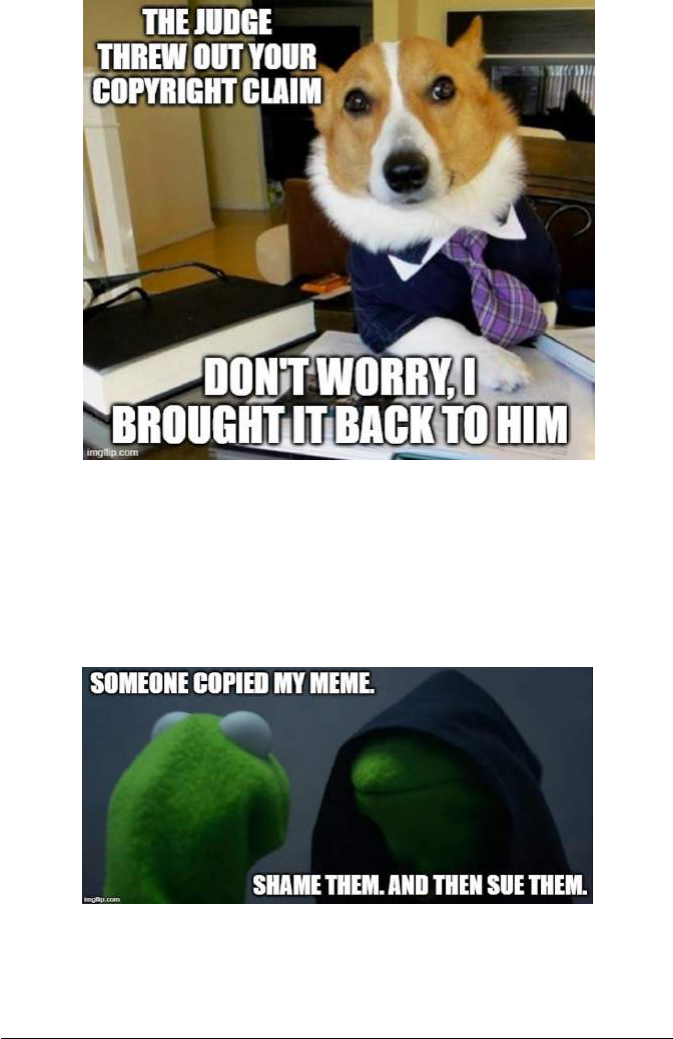
44159-nyu_97-2 Sheet No. 22 Side B 05/17/2022 12:35:30
44159-nyu_97-2 Sheet No. 22 Side B 05/17/2022 12:35:30
\\jciprod01\productn\N\NYU\97-2\NYU201.txt unknown Seq: 40 16-MAY-22 16:37
492 NEW YORK UNIVERSITY LAW REVIEW [Vol. 97:453
C. Copyright Claims for Memes
181
Though it has not been the norm, there have been some copyright
claims made as to memes. Some have sued for copyright infringement,
some have asked for credit, and some have licensed memes. This
Section describes and contextualizes some of the more prominent
claims.
1. Litigation
182
A mere handful of the countless number of creators of memes
and their underlying images have asserted copyright claims against
181
Lawyer Dog, K
NOW
Y
OUR
M
EME
, https://knowyourmeme.com/memes/lawyer-dog
[https://perma.cc/B8XU-8WBS].
182
Evil Kermit, K
NOW
Y
OUR
M
EME
, https://knowyourmeme.com/memes/evil-kermit
[https://perma.cc/G7KQ-Y9VJ].

44159-nyu_97-2 Sheet No. 23 Side A 05/17/2022 12:35:30
44159-nyu_97-2 Sheet No. 23 Side A 05/17/2022 12:35:30
\\jciprod01\productn\N\NYU\97-2\NYU201.txt unknown Seq: 41 16-MAY-22 16:37
May 2022] MEMES ON MEMES AND THE NEW CREATIVITY 493
meme copyists to control the spread of their memes.
183
This low pro-
portion indicates that most of the copying and creation happening
with memes is currently happening outside of copyright’s sphere. The
claims that are brought tend to be brought by a meme creator (or
creator of a meme’s underlying image) against a commercial entity
seeking to profit directly off the work, or against a copyist with a polit-
ical or other message the creator deems to be undesirable. That said,
as a final example in this Section shows, the threat of copyright
infringement claims brought against everyday meme users who do not
fit these paradigms lingers.
184
Some of the most successful, widely-copied memes have been the
subject of copyright infringement lawsuits. These claims have not been
brought one-by-one against each copyist but against a limited number
of copyists, often for commercially using the meme. Take the
Keyboard Cat and Nyan Cat memes. Keyboard Cat involves video
footage of a cat dressed in human clothing and appearing to play a
piano, a still of which is shown below.
185
Nyan Cat, also shown below,
is described as “an 8-bit animation depicting a cat with the body of a
cherry Pop-Tart flying through outer space.”
186
These memes’ creators
sued Warner Bros. and 5th Cell Media for copyright and trademark
infringement for using these characters in their Scribblenauts vide-
183
Someone pictured in a meme might also assert a claim for violation of their rights of
publicity or privacy, which involve different bodies of law than copyright. Lantagne, supra
note 107, at 420–23. See generally J
ENNIFER
E. R
OTHMAN
, T
HE
R
IGHT OF
P
UBLICITY
:
P
RIVACY
R
EIMAGINED FOR A
P
UBLIC
W
ORLD
1–7 (2018) (exploring laws that protect the
right of publicity—defined as the right to prevent the unwanted commercial use and
copying of one’s name, likeness, and identity—and examining intersections with copyright,
property, and privacy laws); Danielle Keats Citron, Mainstreaming Privacy Torts, 98
C
ALIF
. L. R
EV
. 1805 (2010) (proposing a modern approach to privacy torts that accounts
for the longevity of harm stemming from digital-age privacy violations). For a comedic take
on the dignitary and other harms someone depicted in a meme might suffer, see Saturday
Night Live (NBC television broadcast Feb. 29, 2020) (Uncle Meme), https://
www.youtube.com/watch?v=A_mhtXadceM [https://perma.cc/LMQ7-HCDT]. For a more
serious take, see Sirin Kale, Life Beyond the Meme: What Happens After You Go Viral,
BBC (Mar. 7, 2019), https://www.bbc.co.uk/bbcthree/article/e6511d6a-ea8c-4e27-aac3-
728205903635 [https://perma.cc/JZB5-66YG]; Neetzan Zimmerman, ‘Star Wars Kid’
Breaks Silence, Says Online Fame Made Him Suicidal [UPDATE], G
AWKER
(May 10,
2013, 9:41 AM), https://gawker.com/star-wars-kid-breaks-silence-says-online-fame-made-h-
499800192 [https://perma.cc/EF4Q-KRYQ] (relating how the unwitting subject of a
popular meme experienced extreme cyber-bullying, leading to his hospitalization for
severe depression).
184
See infra notes 216–22 and accompanying text.
185
Keyboard Cat, K
NOW
Y
OUR
M
EME
, https://knowyourmeme.com/memes/keyboard-
cat [https://perma.cc/M6X8-WJZA].
186
Nyan Cat, K
NOW
Y
OUR
M
EME
, https://knowyourmeme.com/memes/nyan-cat [https://
perma.cc/24C3-TTNN].
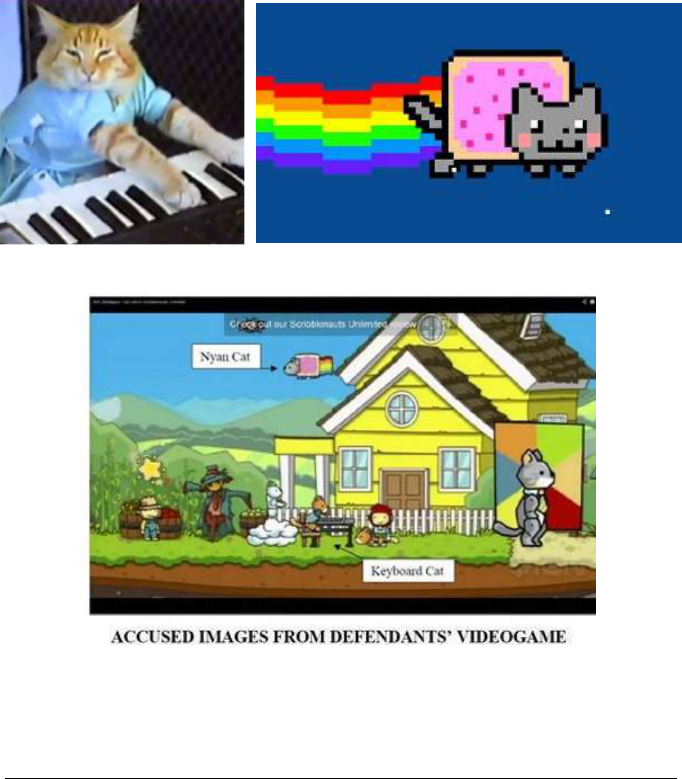
44159-nyu_97-2 Sheet No. 23 Side B 05/17/2022 12:35:30
44159-nyu_97-2 Sheet No. 23 Side B 05/17/2022 12:35:30
\\jciprod01\productn\N\NYU\97-2\NYU201.txt unknown Seq: 42 16-MAY-22 16:37
494 NEW YORK UNIVERSITY LAW REVIEW [Vol. 97:453
ogame, as also shown below.
187
The lawsuit settled a few months later,
with the meme creators receiving payment for the characters’ con-
tinued appearance in the videogame.
188
Keyboard Cat
189
(left) and Nyan Cat
190
(right)
Screenshot from Scribblenauts Videogame
191
Similarly, the owner of Grumpy Cat—a meme which was widely
shared after the owner’s brother posted a photograph of a cat to
187
Complaint, Schmidt v. Warner Bros. Ent., Inc., No. CV13-02824-JFW, 2013 WL
1728009 (C.D. Cal. Apr. 22, 2013); Milord A. Keshishian, Keyboard Cat and Nyan Cat’s
Attorneys Sue Scribblenauts Videogame for Copyright and Trademark Infringement,
M
ILORD
L. G
RP
. (Apr. 30, 2013), https://www.iptrademarkattorney.com/los-angeles-
copyright-trademark-sue-attorney-keyboard-cat-nyan-cat-meme-viral-videos [https://
perma.cc/N6FQ-PX2S].
188
Katie Van Syckle, Keyboard Cat and Nyan Cat Come Out Ahead in Lawsuit Against
Warner Bros., N.Y. M
AG
. (Sept. 26, 2013), https://nymag.com/intelligencer/2013/09/
keyboard-cat-nyan-cat-win-warner-bros-lawsuit.html [https://perma.cc/BC4R-ZCRV].
189
Keyboard Cat, supra note 185.
190
Nyan Cat, supra note 186.
191
This videogame screenshot is displayed in Keshishian, supra note 187.
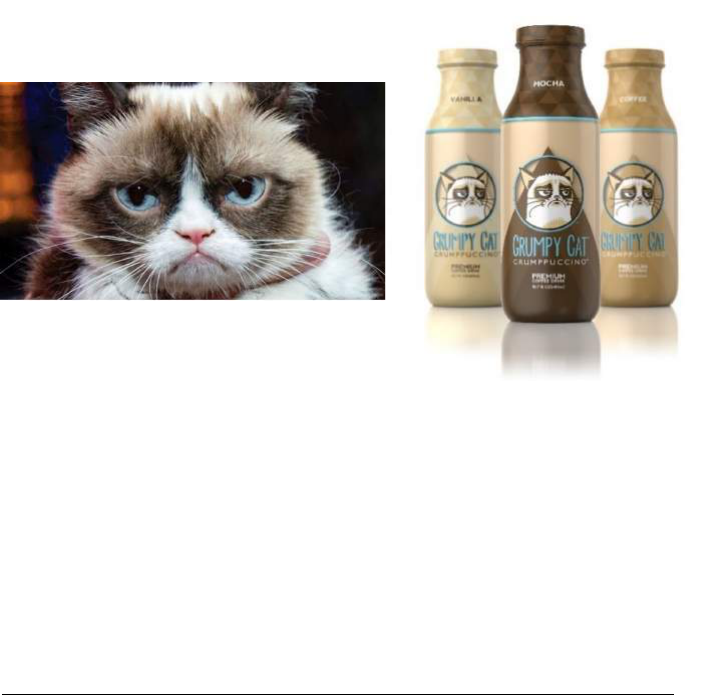
44159-nyu_97-2 Sheet No. 24 Side A 05/17/2022 12:35:30
44159-nyu_97-2 Sheet No. 24 Side A 05/17/2022 12:35:30
\\jciprod01\productn\N\NYU\97-2\NYU201.txt unknown Seq: 43 16-MAY-22 16:37
May 2022] MEMES ON MEMES AND THE NEW CREATIVITY 495
Reddit (shown below)
192
—sued and won $710,000 for copyright
infringement against the makers of Grumpy Cat Grumppuccino iced
coffee drinks for exceeding the scope of a licensing agreement to use
Grumpy Cat imagery.
193
Grumpy Cat
194
(left), and Grumpy Cat Grumppuccino Beverages
195
(right)
In a similar scenario, the mother (and photographer) of Success
Kid (shown below)
196
sued the maker of a fireworks product called
Back Off for copyright infringement after Back Off used her son’s
image on the packaging (also shown below).
197
According to the alle-
gations, “Success Kid has generated substantial value, goodwill, and
licensing revenue from authorized and age-appropriate commercial
uses by companies who wish to associate Success Kid’s goodwill with
their products and services, including Virgin Mobile, Radio Shack,
Bell Canada, Marriott Hotels, Medicare, General Mills, and Coca
192
Grumpy Cat, K
NOW
Y
OUR
M
EME
, https://knowyourmeme.com/memes/grumpy-cat
[https://perma.cc/686U-UPT8].
193
Scott Neuman, Grumpy Cat Awarded $710,000 in Copyright Infringement Suit, NPR
(Jan. 25, 2018), https://www.npr.org/sections/I-way/2018/01/25/580588088/grumpy-cat-
awarded-710-000-in-copyright-infringement-suit [https://perma.cc/ACF5-933W].
194
Grumpy Cat, supra note 192.
195
Eun Kyung Kim, Will Grumpy Cat Coffee Drinks Turn That Frown Upside Down?,
T
ODAY
(July 29, 2013), https://www.today.com/food/will-grumpy-cat-coffee-drinks-turn-
frown-upside-down-6c10788643 [https://perma.cc/6FKD-Z2VT].
196
Success Kid / I Hate Sandcastles, K
NOW
Y
OUR
M
EME
, https://knowyourmeme.com/
memes/success-kid-i-hate-sandcastles [https://perma.cc/R6DS-F668].
197
Complaint at 7–9, Griner v. Jake’s Fireworks, Inc., No. 15-cv-162-Orl-22, 2015 WL
777621 (M.D. Fla. Feb. 3, 2015); John McCarthy, Viral Meme Success Kid’s Mum Sues
Fireworks Firm Using Her Son’s Likeness, D
RUM
(Feb. 25, 2015), https://
www.thedrum.com/news/2015/02/25/viral-meme-success-kids-mum-sues-fireworks-firm-
using-her-sons-likeness [https://perma.cc/2RM7-DQP2].

44159-nyu_97-2 Sheet No. 24 Side B 05/17/2022 12:35:30
44159-nyu_97-2 Sheet No. 24 Side B 05/17/2022 12:35:30
\\jciprod01\productn\N\NYU\97-2\NYU201.txt unknown Seq: 44 16-MAY-22 16:37
496 NEW YORK UNIVERSITY LAW REVIEW [Vol. 97:453
Cola.”
198
The mother’s lawyer noted further that “[w]e’re not ques-
tioning the right of Internet users to use this. This is more about a
company making our client a de facto endorser of an age-
inappropriate product.”
199
The case subsequently settled.
200
Success Kid
201
(left), and Back Off Fireworks
202
(right)
Other creators of memes and their underlying images have pur-
sued copyright infringement claims against those whose messages they
find detestable. As one high-profile example, Matt Furie, the creator
of the Pepe the Frog character (shown below),
203
sued Alex Jones and
Infowars for copyright infringement for making and selling Make
America Great Again posters featuring Pepe the Frog (also shown
below).
204
This came in the wake of members of the alt-right move-
ment and Donald Trump adopting and repeatedly meming Pepe the
Frog.
205
Furie opposed these messages using his character and in an
attempt to disavow and stop these uses, he killed off the character by
publishing a comic book featuring Pepe’s funeral.
206
When Jones
198
Complaint, supra note 197, at 1–2.
199
Todd Wasserman, Boom! Success Kid’s Mom Sues Fireworks Company for Using His
Image, M
ASHABLE
(Feb. 25, 2015), https://mashable.com/archive/success-kid-lawsuit
[https://perma.cc/8HMZ-9UCY].
200
Joint Notice of Settlement, Griner v. Jake’s Fireworks, Inc., No. 15-cv-162-Orl-22
(M.D. Fla. July 6, 2015).
201
Success Kid / I Hate Sandcastles, supra note 196.
202
McCarthy, supra note 197.
203
Pepe the Frog, K
NOW
Y
OUR
M
EME
, https://knowyourmeme.com/memes/pepe-the-
frog [https://perma.cc/29CA-ECC5].
204
Complaint, Furie v. Infowars, LLC, No. CV 18-1830 (C.D. Cal. Mar. 5, 2018).
205
Pepe the Frog, supra note 203 (tracing the alt-right evolution of the Pepe the Frog
meme).
206
Id. (citing W
ORLD
’
S
G
REATEST
C
ARTOONISTS
(2017)).
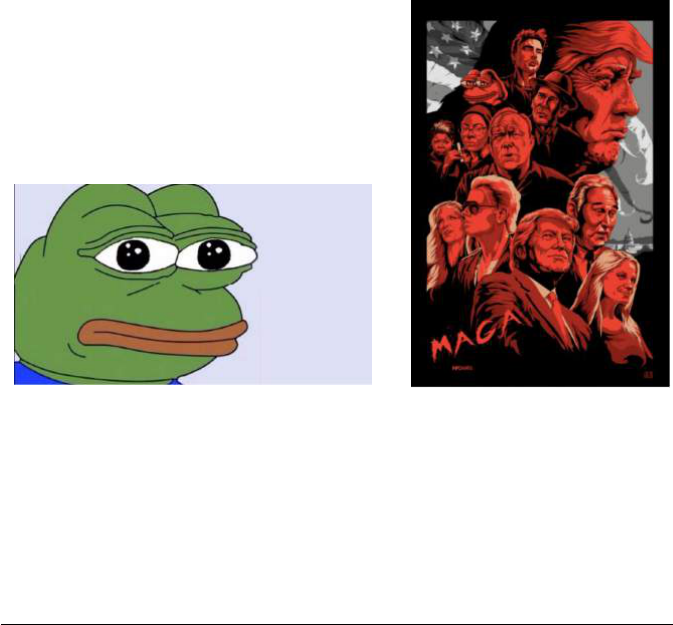
44159-nyu_97-2 Sheet No. 25 Side A 05/17/2022 12:35:30
44159-nyu_97-2 Sheet No. 25 Side A 05/17/2022 12:35:30
\\jciprod01\productn\N\NYU\97-2\NYU201.txt unknown Seq: 45 16-MAY-22 16:37
May 2022] MEMES ON MEMES AND THE NEW CREATIVITY 497
began selling a campaign poster featuring Pepe, Furie sued Jones.
Though Jones and Infowars asserted many defenses to the infringe-
ment claim, including Furie’s abandonment or implied license of his
copyright in the character for letting nearly anyone and everyone else
use it freely online, the district court held that Furie’s infringement
claim withstood the defendants’ motion for summary judgment.
207
A
few months later, the parties settled the lawsuit, and Infowars agreed
to turn over its profits from the poster and cease selling anything fea-
turing Pepe the Frog.
208
Pepe the Frog
209
(left), and Alex Jones Poster Featuring Pepe the Frog
210
(right)
Success Kid, discussed above, had a related experience in which
Success Kid’s mother demanded that then-Congressman Steve King
stop using the Success Kid meme (shown below using the meme for
fundraising purposes), arguing copyright infringement.
211
She stated
that King—whom she thought displayed bigotry and whom she called
“vile”—was antithetical to the Success Kid meme, which “is about
207
Furie v. Infowars, LLC, 401 F. Supp. 3d 952, 969–78 (C.D. Cal. 2019).
208
Martin Macias, Jr., Infowars Settles ‘Pepe the Frog’ Spat for $15,000, C
OURTHOUSE
N
EWS
S
ERV
. (June 10, 2019), https://www.courthousenews.com/infowars-settles-pepe-the-
frog-spat-for-15000 [https://perma.cc/BTS6-YL2S].
209
Pepe the Frog, supra note 203.
210
Benjamin Sutton, Artist Who Created Pepe the Frog Sues InfoWars for Copyright
Infringement, H
YPERALLERGIC
(Mar. 6, 2018), https://hyperallergic.com/430717/pepe-the-
frog-artist-sues-infowars-copyright-infringement [https://perma.cc/WJ2G-59RZ].
211
Paul Brennan, Success Kid’s Latest Success? Shutting Down Steve King, L
ITTLE
V
ILLAGE
(Jan. 30, 2020), https://littlevillagemag.com/success-kids-latest-success-shutting-
down-steve-king [https://perma.cc/6YFX-ALSP].
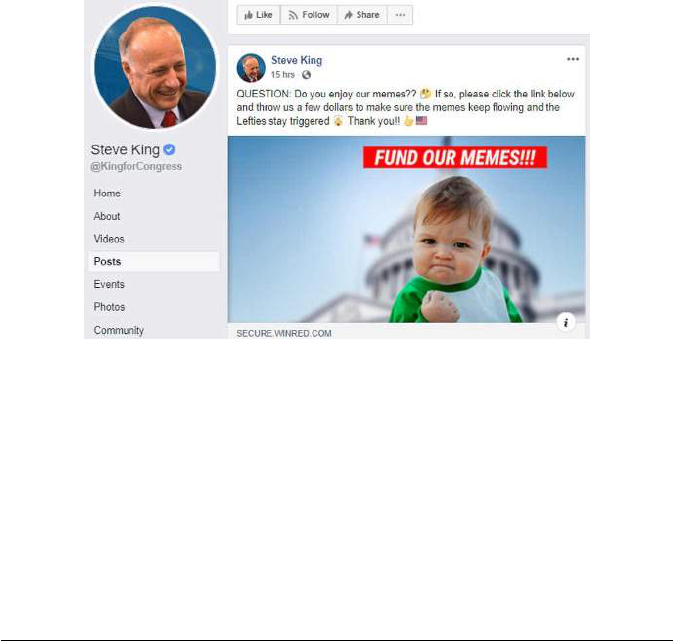
44159-nyu_97-2 Sheet No. 25 Side B 05/17/2022 12:35:30
44159-nyu_97-2 Sheet No. 25 Side B 05/17/2022 12:35:30
\\jciprod01\productn\N\NYU\97-2\NYU201.txt unknown Seq: 46 16-MAY-22 16:37
498 NEW YORK UNIVERSITY LAW REVIEW [Vol. 97:453
positivity and celebrates achievement,”
212
further arguing that “big-
otry is just the antithesis of what we want to be the association with
the meme.”
213
Steve King’s Use of Success Kid
214
Copyright infringement claims over memes are rare and, as these
examples show, have been brought mostly due to commercialization
or undesirable messages. Yet the threat remains of broader assertions
against run-of-the-mill meme users.
215
Consider Getty Images, which
demanded over $800 from a German technology blog for using a pen-
guin photograph at the base of the successful Socially Awkward
Penguin meme (shown below).
216
After the claim received news cov-
erage that was unfavorable to Getty,
217
Getty Images defended its
right to protect its copyright interests.
218
The blog paid up, but even
212
@LaneyMG, T
WITTER
(Jan. 27, 2020, 3:50 PM), https://twitter.com/laneymg/status/
1221898247461056514 [https://perma.cc/BY62-2PPT]; Brennan, supra note 211.
213
Alan Yuhas, Mother of ‘Success Kid’ Demands Steve King Stop Using His Meme,
N.Y. T
IMES
(Jan. 28, 2020), https://www.nytimes.com/2020/01/28/us/politics/steve-king-
success-kid-meme.html [https://perma.cc/LG3S-LLS5].
214
Id.
215
See Neda Ulaby, Will Posting Memes or Pro Wedding Pics Land You in Copyright
Small Claims Court?, NPR (Mar. 12, 2021), https://www.npr.org/2021/03/12/957054009/will-
posting-memes-or-pro-wedding-pics-land-you-in-copyright-small-claims-court [https://
perma.cc/92XB-6LHJ].
216
Socially Awkward Penguin, K
NOW
Y
OUR
M
EME
, https://knowyourmeme.com/
memes/socially-awkward-penguin [https://perma.cc/W4CL-MNPN].
217
See, e.g., Mike Masnick, Getty Images Goes Copyright Trolling After a Meme
Penguin (Sept. 8, 2015), https://www.techdirt.com/articles/20150908/00155432189/getty-
images-goes-copyright-trolling-after-meme-penguin.shtml [https://perma.cc/3GJX-LAQW]
(referring to Getty Images’ behavior as “particularly stupid” and “absolutely ridiculous”).
218
Kevin Collier, Getty Claims Copyright on Socially Awkward Penguin, Forces Site to
Pay $868, D
AILY
D
OT
(May 28, 2021), https://www.dailydot.com/unclick/socially-awkward-
penguin-meme-getty-lawsuit [https://perma.cc/R7UZ-B6L9] (quoting a Getty
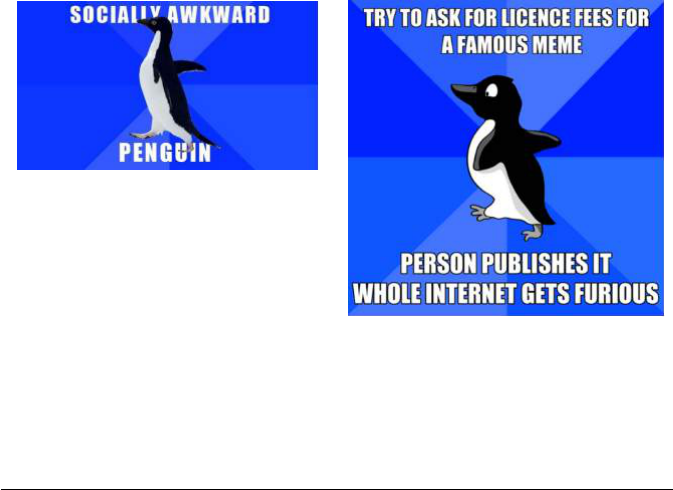
44159-nyu_97-2 Sheet No. 26 Side A 05/17/2022 12:35:30
44159-nyu_97-2 Sheet No. 26 Side A 05/17/2022 12:35:30
\\jciprod01\productn\N\NYU\97-2\NYU201.txt unknown Seq: 47 16-MAY-22 16:37
May 2022] MEMES ON MEMES AND THE NEW CREATIVITY 499
though Getty Images asked that the settlement be kept confidential,
the blog posted about the demand and how unreasonable it thought
the terms were.
219
The blog also created a new version of the penguin
meme (shown below) that does not use the Getty Images penguin and
encouraged others to use it to avoid a claim against them.
220
Techdirt
referred to Getty Images’s behavior as “shaking down a blog” rather
than protecting copyright.
221
Techdirt’s article elaborated:
No one is using this meme because of the photograph itself, and as
can be seen by the alternative version, there’s nothing special about
this penguin that makes it especially necessary for this meme. It’s
just a crazy meme that got popular on the internet, not because of
Getty and not because of [the photographer].
222
Socially Awkward Penguin Meme
223
(left), and Blog’s Substitute Meme
224
(right)
spokesperson, who stated the company “believe[s] in protecting copyright and the
livelihoods of photographers and other artists”).
219
Getty Images Demands License Payment for Awkward Penguin!,
GET
D
IGITAL
.
DE
,
https://www.getdigital.de/blog/getty-images-wants-license-fees-for-the-awkward-penguin-
meme [https://perma.cc/FL5Q-EVUV] (“[T]he Awkward Penguin is not just a random
image we stole from Getty’s database, but one of the most well[-]known internet memes.
Therefore the question arises why obviously no one in the whole internet knows that the
image right of this penguin [is] property of a picture agency.”).
220
Id.
221
Masnick, supra note 217.
222
Id.
223
Socially Awkward Penguin, supra note 216.
224
Getty Images Demands License Payment for Awkward Penguin!, supra note 219.
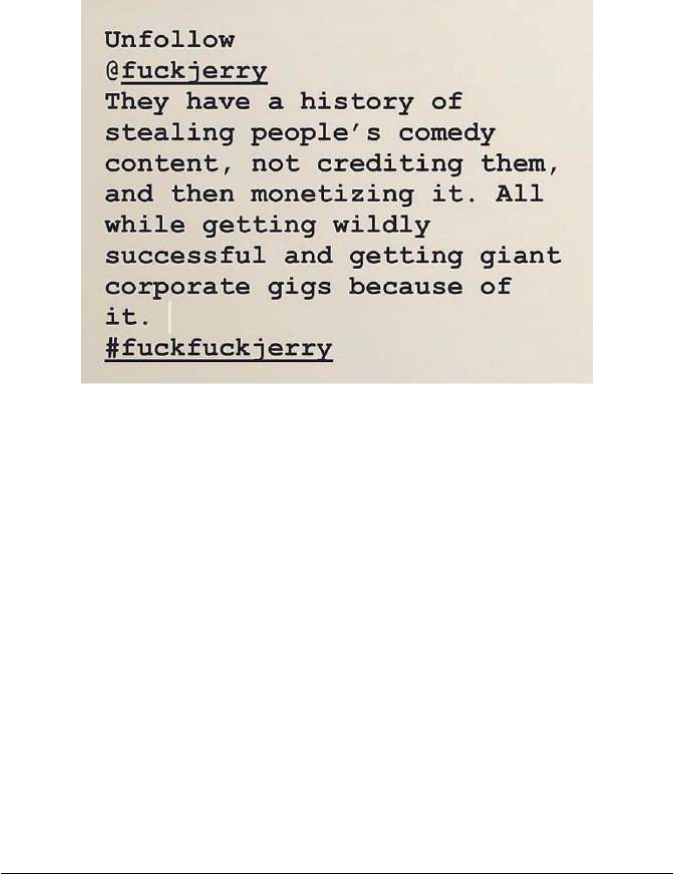
44159-nyu_97-2 Sheet No. 26 Side B 05/17/2022 12:35:30
44159-nyu_97-2 Sheet No. 26 Side B 05/17/2022 12:35:30
\\jciprod01\productn\N\NYU\97-2\NYU201.txt unknown Seq: 48 16-MAY-22 16:37
500 NEW YORK UNIVERSITY LAW REVIEW [Vol. 97:453
2. Credit
225
Some meme creators choose to seek credit from copyists rather
than pursue copyright infringement claims against them. The most
notorious example of this involves the Instagram user FuckJerry, also
known as Elliot Tebele, who has become infamous for his involvement
in promoting the failed Fyre Festival.
226
FuckJerry’s Instagram
account mainly posted jokes and memes to its 14.3 million followers,
but also made money from sponsored posts.
227
Comedians and meme
creators became upset upon realizing that the account would post
their jokes and memes to advertise products without creator credit.
228
Many of them asked for credit or, in the alternative, for deletion of
the copied content. As shown in one example below, FuckJerry simply
responded, “Shut up.”
229
After these requests went nowhere, a number of copied come-
dians and memists banded together to shame FuckJerry and cause the
account to lose its lucrative followers. They initiated the hashtag
225
#fuckfuckjerry Meme, M
E
.M
E
(Feb. 2, 2019), https://me.me/i/unfollow-fuckjerry-
they-have-a-history-of-stealing-peoples-comedy-57837f237c804c25b8fa6705dc10228c
[https://perma.cc/AC6S-3EPV].
226
Meghan O’Keefe, What Is F*ckJerry? Why Hulu and Netflix Are Battling over This
Company’s Role in the Fyre Festival Scam, D
ECIDER
(Jan. 15, 2019), https://decider.com/
2019/01/15/fyre-festival-fuck-jerry [https://perma.cc/VLQ2-4AAF].
227
Ashley Carman, Comedians Are Coming for One of Instagram’s Biggest Joke
Aggregators, V
ERGE
(Feb. 1, 2019), https://www.theverge.com/2019/2/1/18206914/fuckjerry-
jerry-media-comedian-backlash-joke-stealing-vulture [https://perma.cc/B6N4-VPD8].
228
Id.
229
#FuckFuckJerry, K
NOW
Y
OUR
M
EME
, https://knowyourmeme.com/memes/events/
fuckfuckjerry [https://perma.cc/F62F-YPMV].
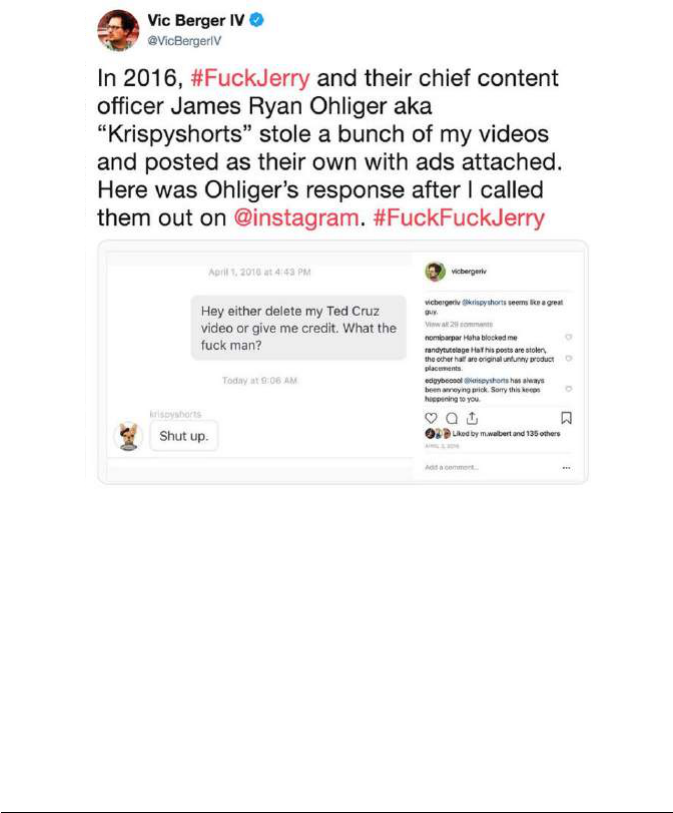
44159-nyu_97-2 Sheet No. 27 Side A 05/17/2022 12:35:30
44159-nyu_97-2 Sheet No. 27 Side A 05/17/2022 12:35:30
\\jciprod01\productn\N\NYU\97-2\NYU201.txt unknown Seq: 49 16-MAY-22 16:37
May 2022] MEMES ON MEMES AND THE NEW CREATIVITY 501
#fuckfuckjerry and asked the public to unfollow the account.
230
After
Comedy Central decided to pull its advertising from FuckJerry in
response to this public response, Tebele apologized and promised to
do better with regard to conferring credit when using others’
content.
231
Example of Request to FuckJerry for Credit
232
230
Id.; Megh Wright, How the #FuckFuckJerry Movement Was Born, V
ULTURE
(Feb. 6,
2019), https://www.vulture.com/2019/02/fuck-jerry-instagram-comedians-unfollow-
campaign-elliot-tebele.html [https://perma.cc/3DR5-9HH4].
231
Nick Statt, Fuckjerry Founder Apologizes for Stealing Jokes and Pledges to Get
Creator Permission, V
ERGE
(Feb. 2, 2019), https://www.theverge.com/2019/2/2/18208446/
fuckjerry-elliot-tebele-meme-joke-aggregator-repost-new-policy-change [https://perma.cc/
7J2J-5LFY].
232
#FuckFuckJerry, supra note 229.

44159-nyu_97-2 Sheet No. 27 Side B 05/17/2022 12:35:30
44159-nyu_97-2 Sheet No. 27 Side B 05/17/2022 12:35:30
\\jciprod01\productn\N\NYU\97-2\NYU201.txt unknown Seq: 50 16-MAY-22 16:37
502 NEW YORK UNIVERSITY LAW REVIEW [Vol. 97:453
3. Licensing
233
As the previous Sections on litigation and credit-seeking imply,
there is also some licensing market for memes, even though most
memes are copied and used entirely freely. Licensing tends to be by
meme creators to established businesses, as Success Kid’s mother sug-
gested.
234
There is enough public expectation that memes will be
licensed by businesses such that when T-Mobile aired an ad during the
Super Bowl riffing on a viral meme (shown below), viewers were out-
raged by this copying, as shown in one example below, until the CEO
tweeted that the meme was licensed.
235
233
I Am Once Again Asking for Your Financial Support, K
NOW
Y
OUR
M
EME
, https://
knowyourmeme.com/memes/i-am-once-again-asking-for-your-financial-support [https://
perma.cc/9S73-S95S].
234
See supra text accompanying note 198.
235
See Jazmin Duribe, T-Mobile’s Super Bowl Ad Was Accused of Ripping Off a Viral
Meme, P
OP
B
UZZ
(Feb. 4, 2019), https://www.popbuzz.com/tv-film/news/t-mobile-super-
bowl-commercial-2019-meme [https://perma.cc/KJ4Y-ZXKL] (compiling examples of
public outrage over the T-Mobile tweet).
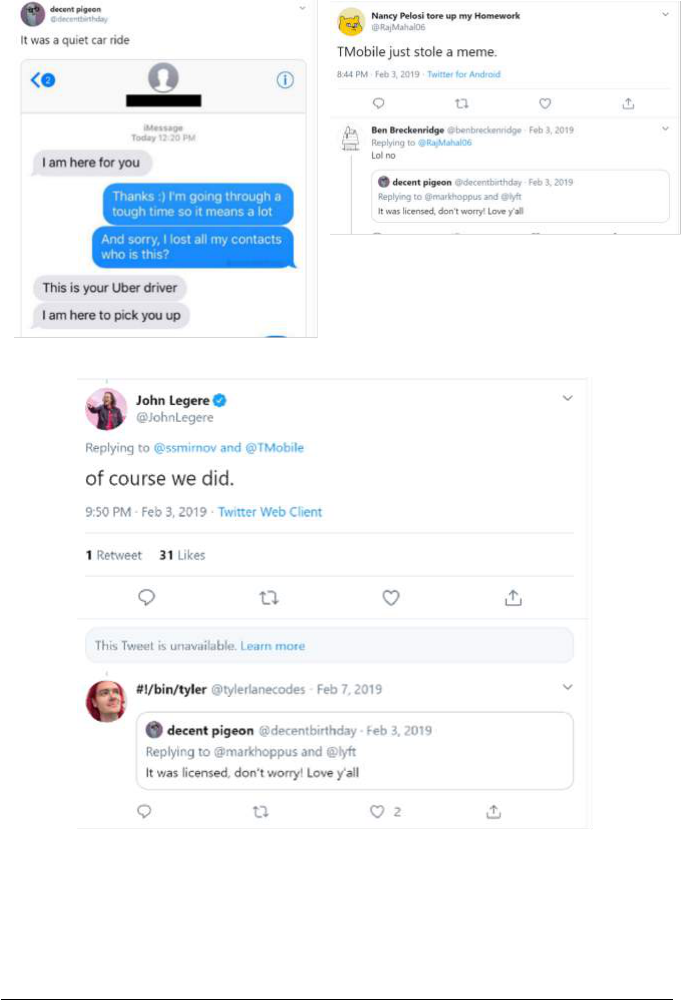
44159-nyu_97-2 Sheet No. 28 Side A 05/17/2022 12:35:30
44159-nyu_97-2 Sheet No. 28 Side A 05/17/2022 12:35:30
\\jciprod01\productn\N\NYU\97-2\NYU201.txt unknown Seq: 51 16-MAY-22 16:37
May 2022] MEMES ON MEMES AND THE NEW CREATIVITY 503
Original Meme
236
(left), and Public Outrage over T-Mobile Ad
237
(right)
T-Mobile CEO Tweet
238
Now that we have explored memes as a matter of definition, their
contribution to society, and how their protection has been asserted
within the existing copyright ecosystem, we turn to analyze how
memes in fact upend copyright’s core assumptions.
236
@DecentBirthday, T
WITTER
(Dec. 14, 2017, 12:25 PM), https://twitter.com/
decentbirthday/status/941358477779329024 [https://perma.cc/NL9L-TU4A].
237
Raj Mahal (@RajMahal06), T
WITTER
(Feb. 3, 2019, 8:44 PM), https://twitter.com/
RajMahal06/status/1092237322974871554 [https://perma.cc/NZJ7-76UE].
238
John Legere (@JohnLegere), T
WITTER
(Feb. 3, 2019, 9:50 PM), https://twitter.com/
JohnLegere/status/1092254115965460480 [https://perma.cc/ULX8-FAE2].
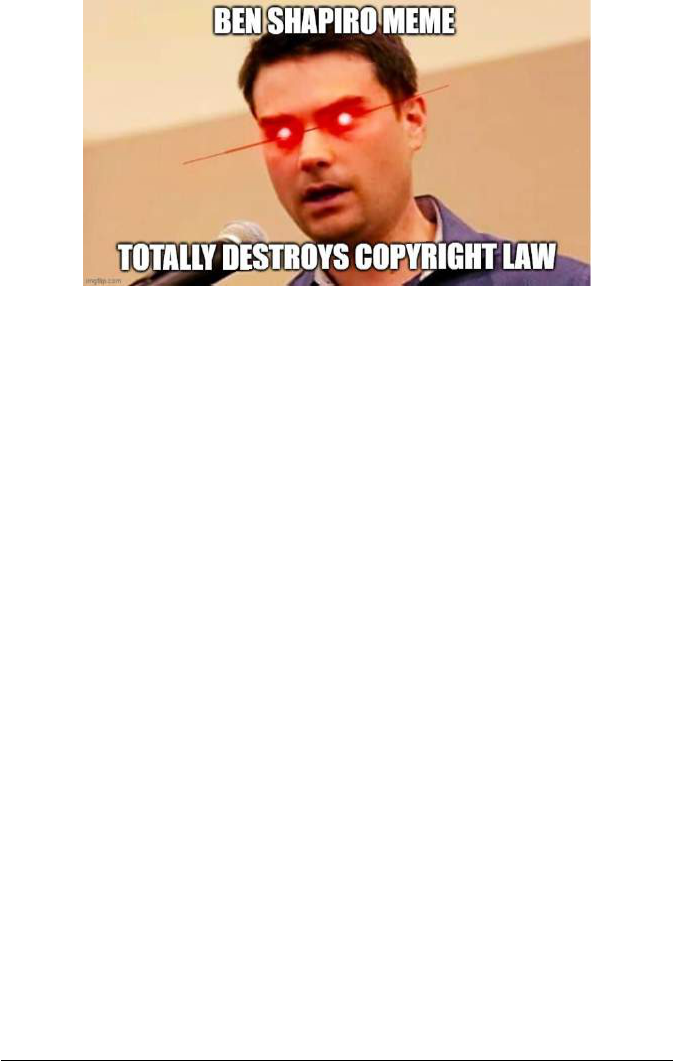
44159-nyu_97-2 Sheet No. 28 Side B 05/17/2022 12:35:30
44159-nyu_97-2 Sheet No. 28 Side B 05/17/2022 12:35:30
\\jciprod01\productn\N\NYU\97-2\NYU201.txt unknown Seq: 52 16-MAY-22 16:37
504 NEW YORK UNIVERSITY LAW REVIEW [Vol. 97:453
III
H
OW
M
EMES
U
PEND
C
OPYRIGHT
’
S
N
OTIONS OF
C
REATIVITY
, C
OMMERCIALIZATION
,
AND
D
ISTRIBUTION
239
Just as Ben Shapiro, the conservative political commentator, is
asserted online to “destroy” every liberal concept and person he
opposes, so too do memes threaten the core principles of copyright.
As we explore below, memes pose a fundamental challenge to copy-
right law by violating copyright’s central tenets of creativity, commer-
cialization, and distribution, which we explored in Part I. Whereas
copyright law at its core views unauthorized copying as a threat to
creativity, memes, a paradigm of contemporary creativity,
240
owe their
very existence to limitless, unauthorized, viral copying.
239
Ben Shapiro DESTROYS Liberals
,
K
NOW
Y
OUR
M
EME
, https://
knowyourmeme.com/memes/ben-shapiro-destroys-liberals [https://perma.cc/KJZ9-5WR2].
240
See supra Section II.B.
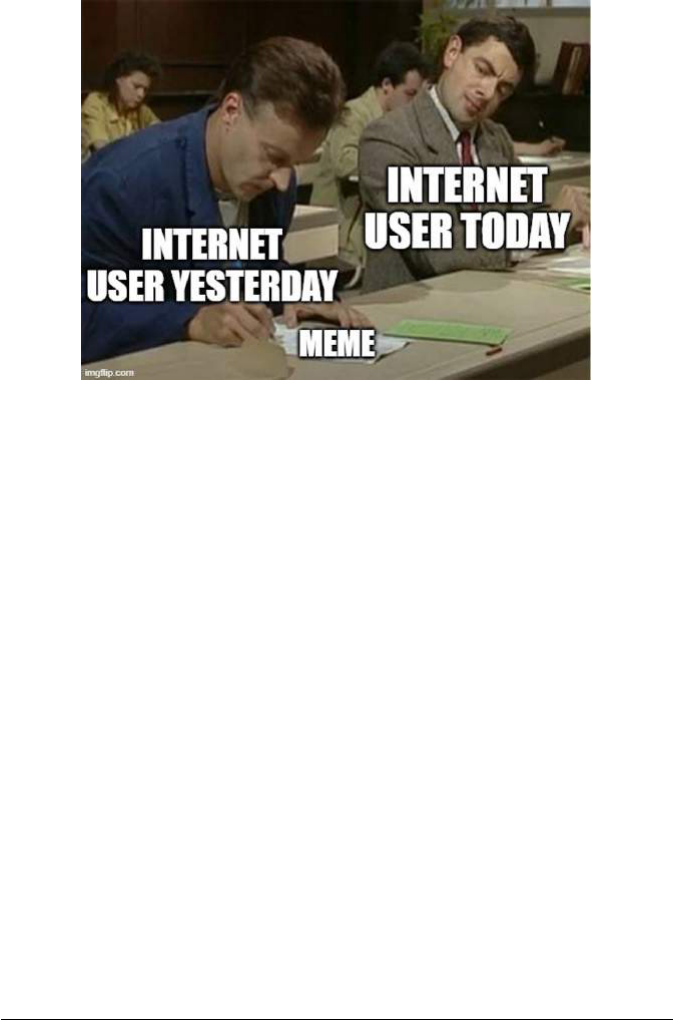
44159-nyu_97-2 Sheet No. 29 Side A 05/17/2022 12:35:30
44159-nyu_97-2 Sheet No. 29 Side A 05/17/2022 12:35:30
\\jciprod01\productn\N\NYU\97-2\NYU201.txt unknown Seq: 53 16-MAY-22 16:37
May 2022] MEMES ON MEMES AND THE NEW CREATIVITY 505
A. The Norms of Copying and Transformation
241
Whereas copyright law envisions an author who wants to fend off
unauthorized copying,
242
meme creators want just the opposite: They
want their work to go viral, to be copied and remixed as much as
possible.
243
They want to lose control of their work.
244
241
Mr. Bean, K
NOW
Y
OUR
M
EME
, https://knowyourmeme.com/memes/subcultures/mr-
bean [https://perma.cc/PKB4-9NRR].
242
See supra Part I.
243
See supra Sections II.A–B.
244
But see infra notes 420–23 and accompanying text.
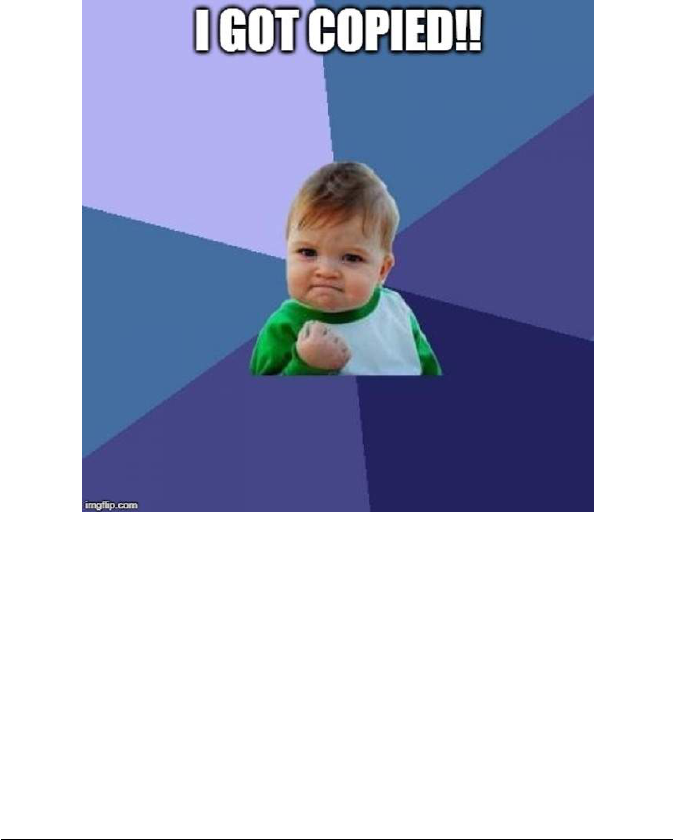
44159-nyu_97-2 Sheet No. 29 Side B 05/17/2022 12:35:30
44159-nyu_97-2 Sheet No. 29 Side B 05/17/2022 12:35:30
\\jciprod01\productn\N\NYU\97-2\NYU201.txt unknown Seq: 54 16-MAY-22 16:37
506 NEW YORK UNIVERSITY LAW REVIEW [Vol. 97:453
1. Copying
245
Memes turn a central pillar of copyright theory on its head. In
previous work, we explored ways in which unauthorized copying can
surprisingly stimulate the market for an underlying work rather than
undercut it, thereby enriching the infringed-upon party.
246
This phe-
nomenon is surprising because it directly defies a fundamental pre-
mise of copyright law, that unauthorized copying harms the market
for original works and must be prohibited in order to incentivize crea-
tion.
247
Memes exemplify this phenomenon in which unauthorized
copying helps rather than harms the original creator.
245
Success Kid / I Hate Sandcastles, supra note 196.
246
Adler, Fair Use, supra note 46 (exploring examples where unauthorized copying in
art does not harm, and may even bring market benefits to, an original artist); Adler, Why
Art Does Not Need Copyright, supra note 22, at 318–20 (exploring how unauthorized
copying in art can bring economic benefits to original creators); see Adler & Fromer, supra
note 47, at 1508–10 (providing an example of how copying might stimulate rather than
undercut the market for the original work); Jeanne C. Fromer, Market Effects Bearing on
Fair Use, 90 W
ASH
. L. R
EV
. 615, 616 (2015) (arguing for the assessment of market benefits
as well as harms in fair use law); accord Kristelia Garc´ıa, Monetizing Infringement, 54 U.C.
D
AVIS
L. R
EV
. 265 (2020) (exploring how rightsholders can monetize being infringed
upon).
247
See supra Sections I.A–C. But cf. Google LLC v. Oracle Am., Inc., 141 S. Ct. 1183,
1206–08 (2021) (analyzing the effect of Google’s use on Oracle’s market by pointing not
just to harms, but also to benefits).

44159-nyu_97-2 Sheet No. 30 Side A 05/17/2022 12:35:30
44159-nyu_97-2 Sheet No. 30 Side A 05/17/2022 12:35:30
\\jciprod01\productn\N\NYU\97-2\NYU201.txt unknown Seq: 55 16-MAY-22 16:37
May 2022] MEMES ON MEMES AND THE NEW CREATIVITY 507
In fact, memes depend for their very existence on unauthorized
copying. Quite simply, a meme does not even come into being until it
has been repeatedly copied.
248
Copyright law instructs us that unau-
thorized copying threatens to usurp the market for an original, but in
memes, copying is what creates the value of the original in the first
place.
249
In this new environment, creators therefore create works
with an eye to inviting copying rather than warding it off. Virality is
the goal; the prospect of being copied is the incentive.
250
This is true
not only of meme creators, but many creators in the digital environ-
ment, who understand that if images or clips of their works become
memes, this will ultimately add value to the original work or to
whatever else the creator may be marketing.
251
Nothing in copyright
theory can describe this or even fathom it.
Consider Drake. His megahit music video for his song “Hotline
Bling” (a still of which is pictured below) spawned endless memes,
252
to the point where the proliferation of memes it inspired became a
story in its own right. The “Hotline Bling” story was more than a
social media phenomenon. Traditional media outlets like USA Today
and Time wrote articles about the best “Hotline Bling” memes.
253
The
memes bled into real life: A football player for the Baltimore Ravens
248
See supra Section II.A.
249
Cf. infra Section V.C (discussing this phenomenon in the context of non-fungible
tokens (NFTs)).
250
Pamela Vaughan, How to Make a Meme That Will Make People Cry (with Laughter),
H
UBSPOT
(June 12, 2018), https://blog.hubspot.com/blog/tabid/6307/bid/33363/
memejacking-the-complete-guide-to-creating-memes-for-marketing.aspx [https://perma.cc/
ZS2T-4R2Q] (discussing the marketing technique of “memejacking” and how to optimize
marketing memes for social sharing to enable as much copying as possible). See generally
Adam Lonnberg, Pengcheng Xiao & Kathryn Wolfinger, The Growth, Spread, and
Mutation of Internet Phenomena: A Study of Memes, R
ESULTS
A
PPLIED
M
ATHEMATICS
,
May 2020 (analyzing different models for tracking and explaining meme virality,
popularity, and behavior).
251
Connor O’Brien, Case Study: How Artists and Songs Go Viral, EDMP
ROD
(Feb. 24,
2021), https://www.edmprod.com/case-study-how-artists-and-songs-go-viral [https://
perma.cc/W4PN-TPWV]. Even creators who do not seek to be copied have benefited
economically from being reproduced. Adler, Why Art Does Not Need Copyright, supra
note 22, at 314–20 (exploring examples of creators such as the Suicide Girls, an alt-porn
collective, whose work gained in value after artist Richard Prince made unauthorized
copies of it in his art series called “New Portraits”).
252
We create one such “Hotline Bling” meme below in Section IV.A.
253
Eliza Berman, Drake’s ‘Hotline Bling’ Video Inspired Some Incredible Dancing
Memes, T
IME
(Oct. 20, 2015), https://time.com/4079654/drake-hotline-bling-dancing-
memes [https://perma.cc/9RGU-K6X9]; Maeve McDermott, The Best ‘Hotline Bling’
Drake Memes, from A to Z, USA T
ODAY
(Oct. 20, 2015), https://www.usatoday.com/story/
life/entertainthis/2015/10/20/best-hotline-bling-memes-drake/74267298 [https://perma.cc/
XX67-DQL8].
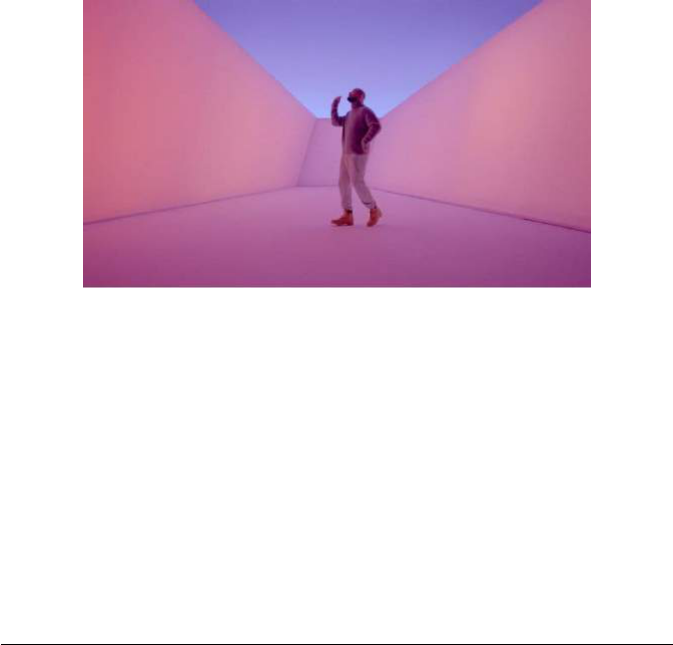
44159-nyu_97-2 Sheet No. 30 Side B 05/17/2022 12:35:30
44159-nyu_97-2 Sheet No. 30 Side B 05/17/2022 12:35:30
\\jciprod01\productn\N\NYU\97-2\NYU201.txt unknown Seq: 56 16-MAY-22 16:37
508 NEW YORK UNIVERSITY LAW REVIEW [Vol. 97:453
copied Drake’s moves in his victory dance after kicking the winning
field goal in a game; players on other teams have done the same.
254
Still from Drake’s “Hotline Bling” Video
255
What is extraordinary is that Drake, seeking a smash hit,
designed the video to have exactly this result. As his partner and cho-
reographer explained, “[A]ll those memes and [mashups], he knew
that was going to happen!”
256
Writing in the New York Times, rock
critic Jon Caramanica explained how the video was designed to be
broken down into GIFs and screenshots to ensure it was copied and
reused.
257
He wrote, “[i]t’s less a video than an open source code that
easily allows Drake’s image and gestures to be rewritten, drawn over,
[and] repurposed.”
258
The relatively empty backgrounds of the video
function almost like a green screen built for remixes. And Drake’s
slightly dorky dance moves were also “more or less blank.”
259
Lacking
254
Jamison Hensley, Justin Tucker’s Celebration Dance Is a Shoutout to Drake, ESPN
B
LOG
(Nov. 1, 2015), https://www.espn.com/blog/baltimore-ravens/post/_/id/23253/justin-
tuckers-celebration-dance-is-a-shoutout-to-drake [https://perma.cc/E6FF-PPYE]; Nick
Schwartz, Mark Ingram Celebrates TD with Drake’s ‘Hotline Bling’ Dance, USA T
ODAY
(Oct. 25, 2015), https://ftw.usatoday.com/2015/10/mark-ingram-drake-dance-hotline-bling
[https://perma.cc/4NQG-BBYF]; Marissa Payne, Antoine Griezmann Sends France to Euro
Final, Dances like Drake, W
ASH
. P
OST
(July 7, 2016), https://www.washingtonpost.com/
news/early-lead/wp/2016/07/07/antoine-griezmann-sends-france-to-euro-final-dances-like-
drake [https://perma.cc/ZR8S-NQZG].
255
Drake, Hotline Bling, Y
OU
T
UBE
, at 01:38 (Oct. 26, 2015), https://www.youtube.com/
watch?v=UXpDa-c-4Mc [https://perma.cc/W4KT-DWGF].
256
Lauren Nostro, Interview: Tanisha Scott Talks Choreographing Drake’s “Hotline
Bling” Video, C
OMPLEX
(Oct. 22, 2015), https://www.complex.com/music/2015/10/tanisha-
scott-interview-on-choreographing-drake-hotline-bling-video [https://perma.cc/EG7G-
AYYK] (quoting Drake’s collaborator Tanisha Scott).
257
Jon Caramanica, Drake: Rapper, Actor, Meme, N.Y. T
IMES
(Oct. 23, 2015), https://
www.nytimes.com/2015/10/24/arts/music/drake-rapper-actor-meme.html [https://perma.cc/
PS8W-9VUC].
258
Id.
259
Id.
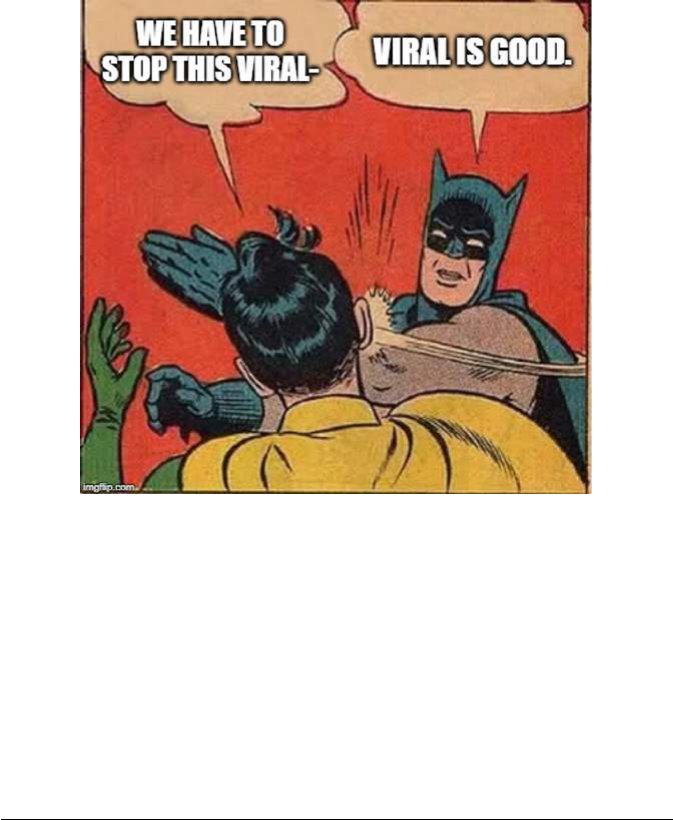
44159-nyu_97-2 Sheet No. 31 Side A 05/17/2022 12:35:30
44159-nyu_97-2 Sheet No. 31 Side A 05/17/2022 12:35:30
\\jciprod01\productn\N\NYU\97-2\NYU201.txt unknown Seq: 57 16-MAY-22 16:37
May 2022] MEMES ON MEMES AND THE NEW CREATIVITY 509
contemporary references and characterized by “small moves that
[Drake] repeats,” the music video presented readymade GIFs of
Drake for his copiers.
260
2. Transformation
261
Creators in meme culture not only hope that their works will be
copied; they also hope their works will be altered and changed in
unforeseen ways. Again, this creative goal violates basic assumptions
that inform copyright law. Whereas copyright law pictures a creator
who wishes to guard their work’s integrity
262
and who will license
derivative uses only if they meet the creator’s criteria, meme culture
envisions a creator who wants to lose control of their work and to
open it up to constant revisions, reuses, and misuses.
263
In this way, we
260
Id.
261
My Parents Are Dead / Batman Slapping Robin, K
NOW
Y
OUR
M
EME
, https://
knowyourmeme.com/memes/my-parents-are-dead-batman-slapping-robin [https://
perma.cc/8AJ2-PHPM].
262
See supra Sections I.A–B; see also 17 U.S.C. § 106A(a) (granting “rights of . . .
integrity” to authors of visual art).
263
Legacy Russell, Amy Adler, B
OMB
M
AG
. (Mar. 12, 2013), https://bombmagazine.org/
articles/amy-adler [https://perma.cc/M2Y3-2RR7] (“[D]igital culture [is] . . . where art is
put out in a way that invites its own re-working.”).
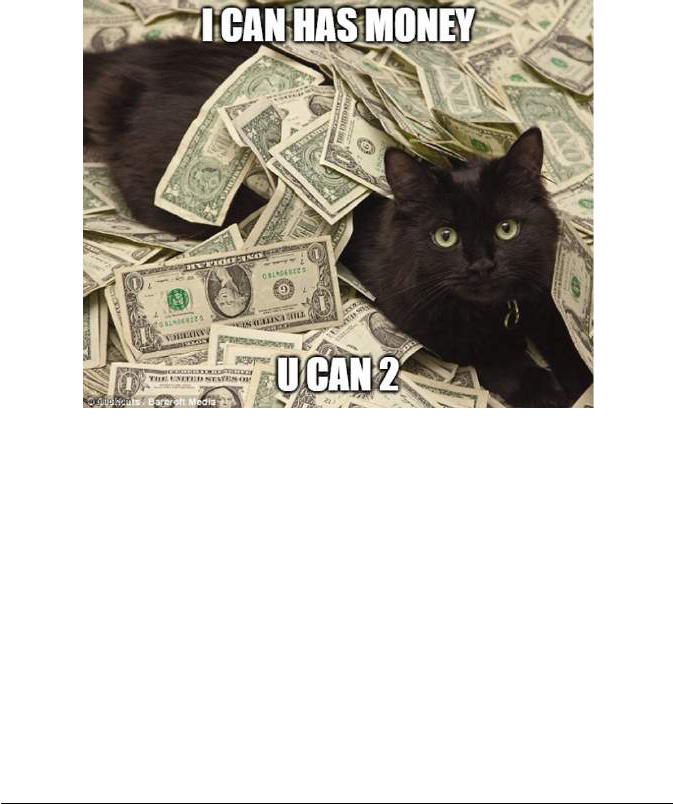
44159-nyu_97-2 Sheet No. 31 Side B 05/17/2022 12:35:30
44159-nyu_97-2 Sheet No. 31 Side B 05/17/2022 12:35:30
\\jciprod01\productn\N\NYU\97-2\NYU201.txt unknown Seq: 58 16-MAY-22 16:37
510 NEW YORK UNIVERSITY LAW REVIEW [Vol. 97:453
might compare memes to certain instances of graffiti art: work that
exists to be written over, transformed, and revised.
264
B. The Creation of Value for Underlying Works Through
Copying
265
As just discussed, copying creates value for the underlying orig-
inal work or expression rather than detracting from it. Sharing memes
based on an underlying copyrighted image “helps ingratiate their
brand into the culture to have their work copied all around the
Internet.”
266
RealityGif, a website that posts images from numerous
reality television shows including The Real Housewives of Beverly
Hills,
267
has never received a request to take down content or pay for
copyrighted material, suggesting the underlying content owners
realize the promotional value that these meme spreaders generate for
the material.
268
In fact, one lawyer advises that if your image has been
turned into a meme, the first thing to consider instead of suing is
264
See infra Section V.A.
265
Money Cat Template,
IMGFLIP
, https://imgflip.com/memetemplate/131896771/Money-
cat [https://perma.cc/KG6Q-HAF3]; see also CashCats, K
NOW
Y
OUR
M
EME
, https://
knowyourmeme.com/memes/cashcats [https://perma.cc/8WKF-9GKL] (explaining the
format of the “CashCats” type of meme).
266
Anna Rabe, Do Memes Violate Copyright Law?, L
AW
T
OG
, https://thelawtog.com/
memes-violate-copyright-law [https://perma.cc/GY38-64WN] (citation omitted).
267
Id.; see also supra Section II.B (discussing memes, including one based on a scene
from The Real Housewives of Beverly Hills).
268
Rabe, supra note 266 (commenting on how the decision not to send a takedown
request and request for payment for the use of copyrighted materials suggests that the
copyright owners benefit from the promotion).

44159-nyu_97-2 Sheet No. 32 Side A 05/17/2022 12:35:30
44159-nyu_97-2 Sheet No. 32 Side A 05/17/2022 12:35:30
\\jciprod01\productn\N\NYU\97-2\NYU201.txt unknown Seq: 59 16-MAY-22 16:37
May 2022] MEMES ON MEMES AND THE NEW CREATIVITY 511
“whether you might be able to turn the meme into a form of adver-
tising for your own business.”
269
C. Indirect Monetization of Works
270
Copyright law is also built on the premise that providing creators
with exclusive rights will encourage people to create expressive works
from which they can directly profit.
271
The meme economy subverts
that assumption because most meme creators do not directly earn
money by exercising copyright’s exclusive rights. Instead, they typi-
cally receive no monetary compensation for their creations or, if they
do, they profit only indirectly off a meme’s success.
Most people who create and share memes do so not to earn
money, but merely to engage with others on social media.
272
The main
reasons young people share memes is to make others laugh, to react to
something in conversation, to communicate how they are feeling espe-
cially when they feel words will not do, and to convey code to some-
body who will “get it.”
273
As one journalist explains, “[m]ost users
269
Id.
270
Agnes Harkness Winking, K
NOW
Y
OUR
M
EME
, https://knowyourmeme.com/memes/
agnes-harkness-winking [https://perma.cc/E6G8-BSKM].
271
See supra Section I.C.
272
See 3 Stats That Show What Memes Mean to Gen Z & Millennials, YP
ULSE
(Mar. 5,
2019), https://www.ypulse.com/article/2019/03/05/3-stats-that-show-what-memes-mean-to-
gen-z-millennials [https://perma.cc/UHH6-W6E8] (highlighting statistics regarding the
frequency and ubiquity of meme sharing across younger demographics, and presenting
survey data to show that the majority of meme sharers do so to elicit smiles, laughs, or
reactions (citing Q1 2018 YPulse Trend Report: Home Sweet Home, Talk the Talk, Ain’t
Nobody Got Time for That, YP
ULSE
(Mar. 30, 2018), https://www.ypulse.com/report/2018/
03/30/q1-2018-ypulse-quarterly-talk-the-talk-home-sweet-home-aint-nobody-got-time
[https://perma.cc/L87S-XFYA])).
273
Id.

44159-nyu_97-2 Sheet No. 32 Side B 05/17/2022 12:35:30
44159-nyu_97-2 Sheet No. 32 Side B 05/17/2022 12:35:30
\\jciprod01\productn\N\NYU\97-2\NYU201.txt unknown Seq: 60 16-MAY-22 16:37
512 NEW YORK UNIVERSITY LAW REVIEW [Vol. 97:453
likely don’t have big plans to copyright their tweets or TikToks for any
reason, and many find a thrill in going viral.”
274
The many free meme
generators online help these users craft and adapt memes to share,
which they can easily do on a myriad of social media platforms.
275
The
prevalence of this sort of creativity thus challenges copyright’s core
assumption that copyright law is necessary to incentivize the creation
and distribution of expressive content.
A smaller but important group of meme creators and sharers
profit from memes, but almost never directly.
276
Even though they do
not charge others for access to or use of their memes, creators can
make significant money indirectly due to their success in creating and
sharing memes. In particular, meme creators and sharers can attract
loyal and significant numbers of followers based on their meme niche,
be it about parents, cats, science, law, or politics.
277
That in turn can
generate profit opportunities for these meme creators and sharers. For
example, in 2016, the FuckJerry Instagam account discussed earlier
278
was on track to make $1.5–3 million based on sponsored posts they
shared to their more than ten million followers by charging a fixed
cost plus a cost per follower.
279
These followers came for the freely
shared memes and also viewed the sponsored content, allowing
FuckJerry to profit indirectly. Similarly, well-known meme creators
have been hired by established businesses, such as Gucci, to create
memes to be copied and shared with the objective of capturing
consumers.
280
274
Jane C. Hu, The Legal Netherworld of Meme Accounts, S
LATE
(Aug. 8, 2019), https://
slate.com/technology/2019/08/copyright-law-meme-accounts-instagram-reposts.html
[https://perma.cc/CFS7-QBAJ].
275
See supra note 150 and accompanying text.
276
See, e.g., supra Section II.B (exploring the culture surrounding memes and situating
memes within the market of attention rather than a monetary market); cf. Vaughan, supra
note 250 (presenting a user guide for creating valuable memes, with objectives focused on
traffic, visibility, and virality, rather than profiteering). But see supra Section II.C.1
(discussing a few meme lawsuits focusing on copier profit-extraction); supra Section II.C.3
(commenting on how some—albeit a very select few—memes are licensed by larger
companies).
277
See, e.g., Jane, How to Make Money with Memes in 2021, T
HIS
M
AMA
B
LOGS
(Aug.
16, 2021), https://thismamablogs.com/make-money-with-memes [https://perma.cc/CPV4-
F7LA] (encouraging making memes that resonate with the maker’s audience by picking a
niche such as parenting or cat ownership).
278
See supra Section II.C.2.
279
Madeline Berg, How FuckJerry Wants to Go from Instagram to Empire, F
ORBES
(Apr. 8, 2016), https://www.forbes.com/sites/maddieberg/2016/04/08/how-fuckjerry-wants-
to-go-from-instagram-to-empire [https://perma.cc/5UDH-LU3B].
280
Kam Dhillon, Here’s How Much Money You Can Make with Memes,
H
IGH
S
NOBIETY
, https://www.highsnobiety.com/p/how-to-make-money-with-memes
[https://perma.cc/WV22-746G] (“While many devotees heralded the [Gucci] campaign as
the grizzly death of meme culture, for marketing teams everywhere the campaign proved
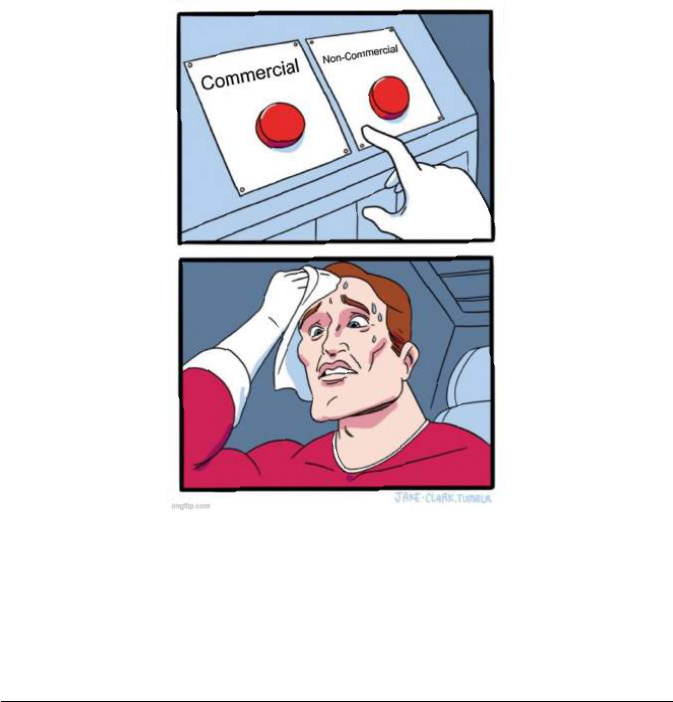
44159-nyu_97-2 Sheet No. 33 Side A 05/17/2022 12:35:30
44159-nyu_97-2 Sheet No. 33 Side A 05/17/2022 12:35:30
\\jciprod01\productn\N\NYU\97-2\NYU201.txt unknown Seq: 61 16-MAY-22 16:37
May 2022] MEMES ON MEMES AND THE NEW CREATIVITY 513
As previously discussed, a select few creators—such as the cre-
ators of the Success Kid and Grumpy Cat—monetize their memes
through copyright licenses to traditional companies.
281
Yet this rar-
efied group operates in contrast to the rest of meme culture and
against the practices of even the most successful meme creators and
sharers. But even meme superstars who pursue lucrative licensing
opportunities generate these opportunities principally by allowing
their memes to be widely and freely shared, thereby defying the pro-
totypical copyright story.
D. Line Between Commercial and Non-Commercial Activity
282
Following from the different ways that business happens in the
meme economy is the observation that it is becoming harder to distin-
guish between commercial and non-commercial activity for the pur-
pose of fair use analysis.
283
As per the copyright statute, fair use turns
how the meme remains a largely untapped resource to cannibalize within our attention
economy.”); Jane, supra note 277.
281
See supra Section II.C.
282
Daily Struggle, K
NOW
Y
OUR
M
EME
, https://knowyourmeme.com/memes/daily-
struggle [https://perma.cc/T3AF-XK9B].
283
The law also sometimes distinguishes between commercial and non-commercial
activity with regard to infringement, but in limited ways. Specifically, with regard to
copyright’s exclusive rights of public performance and public display, copyright law

44159-nyu_97-2 Sheet No. 33 Side B 05/17/2022 12:35:30
44159-nyu_97-2 Sheet No. 33 Side B 05/17/2022 12:35:30
\\jciprod01\productn\N\NYU\97-2\NYU201.txt unknown Seq: 62 16-MAY-22 16:37
514 NEW YORK UNIVERSITY LAW REVIEW [Vol. 97:453
in part on “the purpose and character of the use, including whether
such use is of a commercial nature or is for nonprofit educational pur-
poses.”
284
Courts have struggled mightily with whether a defendant’s
use is commercial. The Supreme Court has explained, “The crux of
the profit/nonprofit distinction is not whether the sole motive of the
use is monetary gain but whether the user stands to profit from
exploitation of the copyrighted material without paying the customary
price.”
285
That so-called explanation has mystified courts and scholars,
particularly because “profit from exploitation” seems inextricably tied
to using copyrighted work without paying.
286
This already difficult-to-draw line between commercial and non-
commercial use becomes even less precise in a meme economy in
which successful creators and sharers tend to profit only indirectly, if
at all, from their memes. It is very hard to determine, even notwith-
standing the already-confusing copyright doctrine on commerciality,
whether creators are engaging in commercial or non-commercial
exempts certain activities best described as nonprofit. See 17 U.S.C. § 110 (outlining
permitted displays or performances, providing they are of a non-commercial nature).
Moreover, the Audio Home Recording Act prohibits an infringement action “based on the
noncommercial use by a consumer of [an audio recording] device or medium for making
digital musical recordings or analog musical recordings.” Id. § 1008. This exception is fairly
limited, as Congress chose not to include home computers as such devices. Id. § 1001(3)
(specifying that a “digital audio recording device” means a device that is designed or
marketed “for the primary purpose of” making an audio recording); Recording Indus.
Ass’n of Am. v. Diamond Multimedia Sys. Inc., 180 F.3d 1072, 1078 (9th Cir. 1999) (finding
that computers are not digital audio recording devices given the legislative history of the
Audio Home Recording Act).
284
17 U.S.C. § 107(1).
285
Harper & Row, Publishers, Inc. v. Nation Enters., 471 U.S. 539, 562 (1985).
286
See e.g., Maxtone-Graham v. Burtchaell, 803 F.2d 1253, 1262 (2d Cir. 1986)
(rejecting the holding in Sony Corp. of Am. v. Universal City Studios, Inc., 464 U.S. 417
(1984), that any income-producing use presumptively falls outside of the fair use defense);
Thomas M. Byron, Past Hits Remixed: Fair Use as Based on Misappropriation of Creative
Value, 82 M
ISS
. L.J. 525, 567–68 (2013) (discussing how the focus on commercial nature
was once—but is no longer—“effectively dispositive” in the fair use inquiry); Igor Slabykh,
Ambiguous Commercial Nature of Use in Fair Use Analysis, 46 AIPLA Q.J. 293, 317–19
(2018) (arguing that the “customary price” approach endorsed by Harper & Row is the
most fair definition of commerciality). This unresolved tension may explain why courts
tend to discount the importance of commerciality to fair use (though when courts conclude
a defendant’s use is non-commercial, they are apt to find fair use). Barton Beebe, An
Empirical Study of U.S. Copyright Fair Use Opinions, 1978–2005, 156 U. P
A
. L. R
EV
. 549,
600–03 (2008) (tracking the courts’ attention to the commerciality inquiry when ruling on
fair use, and noting that while not consistent, the commerciality inquiry of Sony persists).

44159-nyu_97-2 Sheet No. 34 Side A 05/17/2022 12:35:30
44159-nyu_97-2 Sheet No. 34 Side A 05/17/2022 12:35:30
\\jciprod01\productn\N\NYU\97-2\NYU201.txt unknown Seq: 63 16-MAY-22 16:37
May 2022] MEMES ON MEMES AND THE NEW CREATIVITY 515
activity.
287
This haziness might make fair use determinations in this
context yet less predictable.
288
E. Breakdown of Idea-Expression Distinction
289
Memes break down copyright law’s assumptions further by laying
bare the lack of distinction between idea and expression, that distinc-
tion being a central tenet of copyright law.
290
Consider the Mocking
SpongeBob meme shown above. Under traditional copyright analysis,
the image itself (not to mention the text superimposed on it) is classic
protectable expression. Yet meming an image can transform that
expression into an idea. In the context of the Mocking SpongeBob
meme, the image represents “a mocking tone towards an opinion or
point of view.”
291
The presence of that image now indicates that idea,
either with or without accompanying text, perhaps even more than it
conveys the image as expression.
292
To the extent that this SpongeBob
287
Compare Sony, 464 U.S. at 448–49 (ruling that “time-shifting [by recording
broadcast television programs on a video cassette recorder] for private home use must be
characterized as a noncommercial, nonprofit activity”), with Harper & Row, 471 U.S. at
562 (holding that a nonprofit news publication engages in commercial behavior in its news
reporting); cf. Lantagne, supra note 107, at 416–17 (“[C]ommercial use on the internet—
especially on social media—can be a complicated question.”).
288
Compare Deidr ´e A. Keller, Recognizing the Derivative Works Right as a Moral
Right: A Case Comparison and Proposal, 63 C
ASE
W. R
SRV
. L. R
EV
. 511, 520 (2012)
(finding fair use to be unpredictable), and Jason Mazzone, Administering Fair Use, 51 W
M
.
& M
ARY
L. R
EV
. 395, 401 (2009) (same), with Michael J. Madison, A Pattern-Oriented
Approach to Fair Use, 45 W
M
. & M
ARY
L. R
EV
. 1525, 1530 (2004) (thinking there are
patterns and coherence in fair use), and Pamela Samuelson, Unbundling Fair Uses, 77
F
ORDHAM
L. R
EV
. 2537, 2541 (2009) (same).
289
Mocking SpongeBob, K
NOW
Y
OUR
M
EME
, https://knowyourmeme.com/memes/
mocking-spongebob [https://perma.cc/VG5L-KCWF].
290
See supra Section I.D.
291
Mocking SpongeBob, supra note 289.
292
“Why are there so many Spongebob memes?”, asks Time. Rachel E. Greenspan,
Your Comprehensive Guide to the Best Spongebob Memes Across the Internet’s Sea, T
IME
(Sept. 19, 2019), https://time.com/5647509/best-spongebob-memes [https://perma.cc/PZ2P-
7MV2]. In addition to SpongeBob’s evocation of nostalgia and ease of design, Matt
Schimkowitz—a senior editor at the magazine—argues that emotions reign supreme:
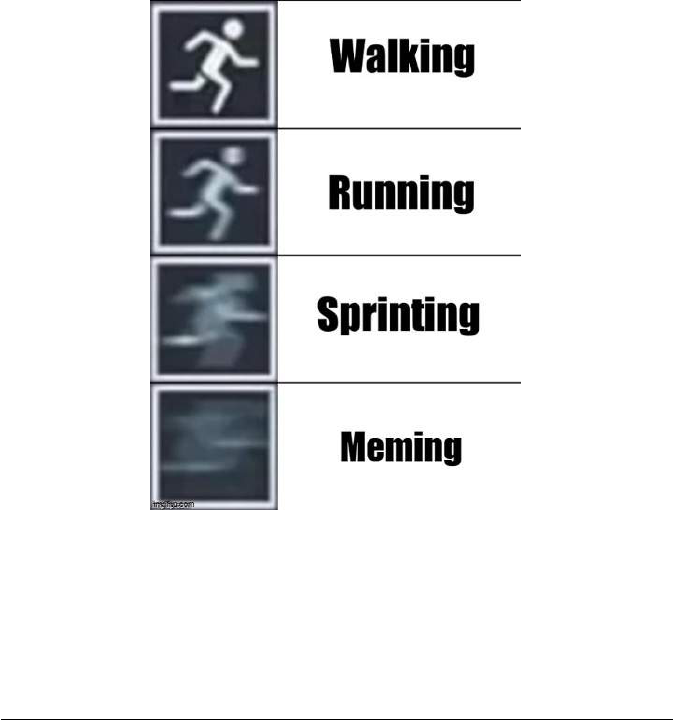
44159-nyu_97-2 Sheet No. 34 Side B 05/17/2022 12:35:30
44159-nyu_97-2 Sheet No. 34 Side B 05/17/2022 12:35:30
\\jciprod01\productn\N\NYU\97-2\NYU201.txt unknown Seq: 64 16-MAY-22 16:37
516 NEW YORK UNIVERSITY LAW REVIEW [Vol. 97:453
image becomes synonymous with mockery, various people can use
this same image to represent “mocking” tones in a multitude of situa-
tions. Therefore, the image is now sometimes expression, sometimes
idea, or perhaps sometimes both simultaneously. This example reveals
a characteristic of memes writ large: memes break down copyright’s
idea-expression distinction, rendering it as nonsensical as SpongeBob
himself sometimes can be.
293
F. Scale and Pace of Copying
294
The ability to launch and spread a meme virally on a mass level
can happen in hours, as social media and other internet platforms are,
as Limor Shifman puts it, “‘express paths’ for meme diffusion.”
295
As
discussed earlier, viral memes are not only copied, but they are also
transformed.
296
A Gen Z-er studying memes writes that viral memes
“[T]he characters on Spongebob . . . are incredibly direct in what emotion they’re trying to
express,” with no real expressive subtlety. Id. SpongeBob is just his emotions, “which
makes it much easier for people online to use them essentially as emojis and share them to
express how they’re feeling about a particular subject.” Id. (quoting Matt Schimkowitz).
293
Cf. Lantagne, supra note 107, at 408 (“[M]emes are no longer pieces of creative
expression so much as they are the basic building blocks of cultural communication.”).
294
Very Fast,
IMGFLIP
, https://imgflip.com/meme/178062637/Very-Fast [https://perma.cc/
62KZ-2UZM].
295
S
HIFMAN
, supra note 96, at 18.
296
See supra Sections III.A–B.
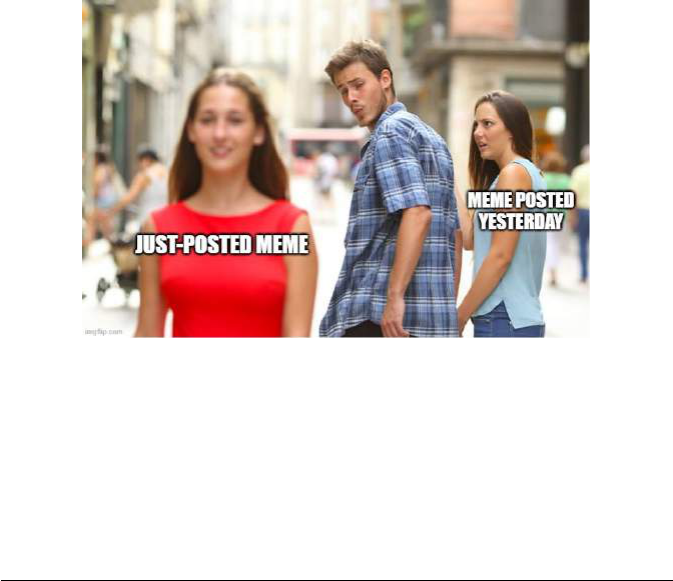
44159-nyu_97-2 Sheet No. 35 Side A 05/17/2022 12:35:30
44159-nyu_97-2 Sheet No. 35 Side A 05/17/2022 12:35:30
\\jciprod01\productn\N\NYU\97-2\NYU201.txt unknown Seq: 65 16-MAY-22 16:37
May 2022] MEMES ON MEMES AND THE NEW CREATIVITY 517
can have “thousands of variations and a huge online presence on
social media. If [a] meme does happen to go viral, this means that it
has diffused through society, or the Internet, and has been widely
recreated. This meme will be visible everywhere, from Facebook to
college professors’ lecture slides.”
297
They are copied and transformed
at an exponential pace, something that is easy through social media’s
facilitation of speedy cooption and virality, not like your grandfather’s
copyright.
298
G. Staleness of Memes
299
What this scale and pace of copying also means is that innovation
in the world of memes is proceeding at a supersonic pace. Copyright’s
duration of an author’s lifetime plus seventy years
300
seems like a
misfit for memes that can hit it big and go stale all in the matter of
weeks.
301
Many memes decay with a quick half-life—on the order of
297
Madison, What Makes a Meme Go Viral?, M
EDIUM
(Jan. 21, 2018), https://
madisonicole.medium.com/meme-ology-studying-patterns-in-viral-media-f1931b3d1c7e
[https://perma.cc/6DV6-YVLX].
298
For a look at what copying looked like in a pre-internet era, see Stephen Breyer, The
Uneasy Case for Copyright: A Study of Copyright in Books, Photocopies, and Computer
Programs, 84 H
ARV
. L. R
EV
. 281 (1970).
299
Distracted Boyfriend, K
NOW
Y
OUR
M
EME
, https://knowyourmeme.com/memes/
distracted-boyfriend [https://perma.cc/9FXC-LY6X].
300
17 U.S.C. § 302(a).
301
In their work regarding the fashion industry, Kal Raustiala and Chris Sprigman note
the quickened pace of copying—often seasonal—which leads to the fast obsolescence of a
trend followed by innovation to replace each dying trend. Kal Raustiala & Christopher
Sprigman, The Piracy Paradox: Innovation and Intellectual Property in Fashion Design, 92
V
A
. L. R
EV
. 1687, 1689–92 (2006). By comparison, the scale and pace of copying and
transformation of memes make the fashion industry look sluggish.
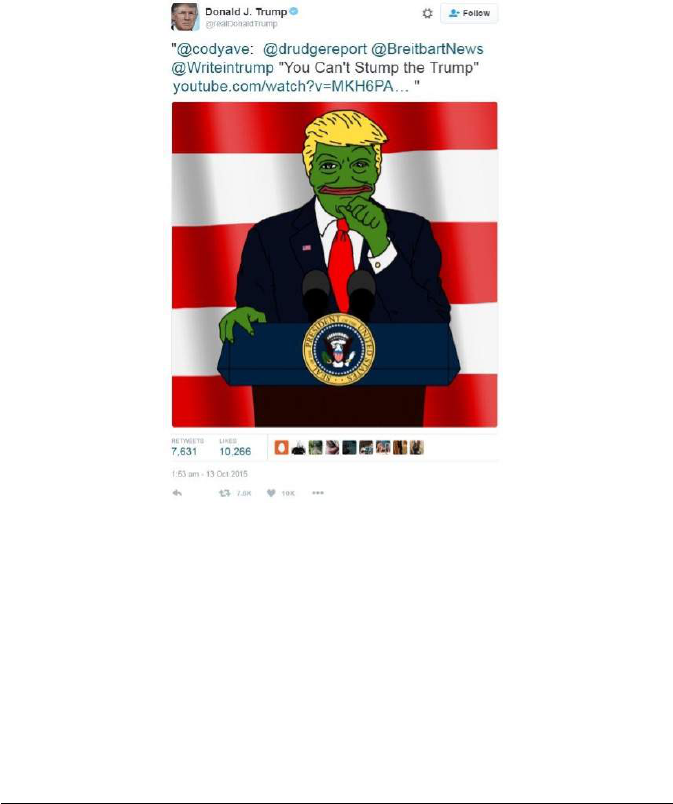
44159-nyu_97-2 Sheet No. 35 Side B 05/17/2022 12:35:30
44159-nyu_97-2 Sheet No. 35 Side B 05/17/2022 12:35:30
\\jciprod01\productn\N\NYU\97-2\NYU201.txt unknown Seq: 66 16-MAY-22 16:37
518 NEW YORK UNIVERSITY LAW REVIEW [Vol. 97:453
days and weeks—leading new memes to rise up and take their
place.
302
H. Selective Enforcement
303
Another way in which memes upend copyright’s assumptions is
with regard to selectivity of enforcement. Recall that copyright law
permits owners to choose whether to license their exclusive rights and
to whom.
304
By default, then, very few people or entities are likely to
have express license to any of the copyright rights. The major excep-
tions are for open-source software, a work licensed by Creative
Commons,
305
or a work with a shrinkwrap license. With such a mass
license, the use of these works is restricted only by the use terms of
302
See Eileen Brown, The Maths Behind the Memes: Why We Share on Social Media,
ZDN
ET
(July 25, 2017), https://www.zdnet.com/article/the-maths-behind-the-memes-why-
we-share-on-social-media [https://perma.cc/7K6Q-2TRR] (studying mathematically the
brief popularity-window of memes); Lonnberg, Xiao & Wolfinger, supra note 250
(modeling how memes “are spread rapidly by internet users, often for a relatively short
period of time”).
303
Pepe the Frog, supra note 203.
304
See supra Section I.F.
305
As explained by the organization itself, “Creative Commons is a nonprofit
organization that helps overcome legal obstacles to the sharing of knowledge and creativity
to address the world’s pressing challenges.” What We Do,C
REATIVE
C
OMMONS
, https://
creativecommons.org/about [https://perma.cc/RDS4-5WBY].
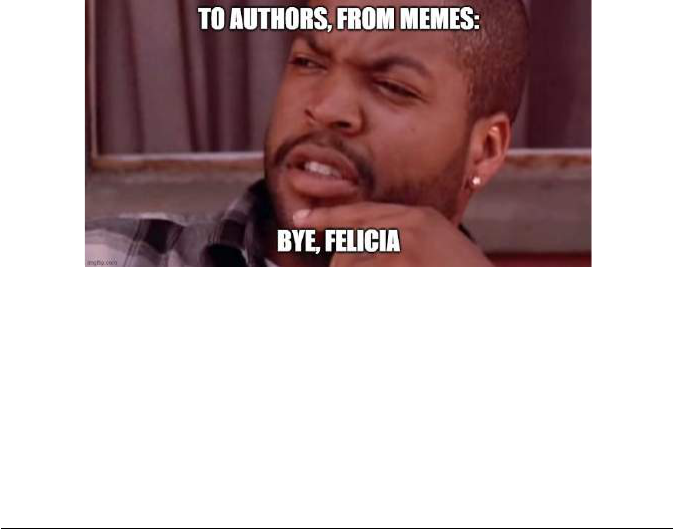
44159-nyu_97-2 Sheet No. 36 Side A 05/17/2022 12:35:30
44159-nyu_97-2 Sheet No. 36 Side A 05/17/2022 12:35:30
\\jciprod01\productn\N\NYU\97-2\NYU201.txt unknown Seq: 67 16-MAY-22 16:37
May 2022] MEMES ON MEMES AND THE NEW CREATIVITY 519
the license, rather than the user’s identity. What unifies these excep-
tions is that they are offered on a take-it-or-leave-it basis uniformly to
everyone.
306
Meme licensing differs from these scenarios in terms of the selec-
tivity of enforcement. Writ large, copying and transforming memes is
tolerated and typically encouraged,
307
an opposite scenario from copy-
right’s assumed default.
308
Yet at the same time, some meme creators
employ almost surgical exclusion to prevent a handful of people or
groups whose messages they do not like from using their memes.
Recall Pepe the Frog’s creator deploying copyright to stop Alex Jones,
and Success Kid’s mother doing the same to stop Steve King.
309
In
these situations, only very few have no permission to use the copy-
righted work because of their views or message while all others can
use, copy, and transform the same meme freely, making this different
both from copyright’s assumed default and take-it-or-leave-it licenses.
I. The Centrality of the Meme, Not the Author
310
Another way in which memes undermine copyright’s core tenets
is that they decentralize the author
311
and instead center the meme
itself. Compare this situation with more traditional works like songs,
books, paintings, or movies. While not everyone can identify the
singer who recorded Hotline Bling, the author who wrote The Catcher
in the Rye, the painter who created Starry Night, and the director,
writer, and actors of Nomadland, many can and will associate such
306
For an exploration of these types of licenses side by side, see J
EANNE
C. F
ROMER
&
C
HRISTOPHER
J
ON
S
PRIGMAN
, C
OPYRIGHT
L
AW
: C
ASES AND
M
ATERIALS V
.3.0, at 654–65
(2021).
307
See supra Sections III.A–B.
308
See supra Section I.F.
309
See supra Section II.C.
310
Bye Felicia, K
NOW
Y
OUR
M
EME
, https://knowyourmeme.com/memes/bye-felicia
[https://perma.cc/PTY8-T3JG].
311
See supra Section I.G.

44159-nyu_97-2 Sheet No. 36 Side B 05/17/2022 12:35:30
44159-nyu_97-2 Sheet No. 36 Side B 05/17/2022 12:35:30
\\jciprod01\productn\N\NYU\97-2\NYU201.txt unknown Seq: 68 16-MAY-22 16:37
520 NEW YORK UNIVERSITY LAW REVIEW [Vol. 97:453
works importantly with their respective authors. People understand
these works as shaped by the authors’ particular circumstances and
viewpoints.
312
Such author-centricity is even characteristic of many
works made for hire, such as software.
Many people are involved in a meme’s creation and spread:
Someone creates an underlying image used to make a meme, someone
turns it into a meme, and then others copy and transform that meme.
Indeed, copyright law might label many of these actors as authors.
313
But despite the possibility of legal authorship recognition, even the
most well-known memes, like Distracted Boyfriend,
314
are identifiable
not by any of these creators but rather are known as the meme and its
variations. This is true even when one can trace a meme’s spread to
particular individuals and identify the author of the underlying image,
as the Know Your Meme reference site sometimes does. Moreover,
authorship lacks centrality even though the multiple layers of contri-
butions offer potential opportunities for individual identification.
315
Memes are dissociated from their creators; authors rarely—if ever—
receive personal recognition. As literary scholar Marta Figlerowicz
explains:
[A]ny image or quip that becomes an internet meme begins as some
particular user’s act of self-expression. But if it is successful it
evolves into a piece of cultural syntax, cycling through many
people’s perspectives and becoming divorced from its original con-
text. Soon that original context—or any other single iteration of the
meme—matters little to its current or its fullest meaning. At its
most interesting, a meme is a cloud of variants and reuses, coming
alive in each reenactment but meaningful only when one thinks of
the abstraction at its center.
316
312
Cf. Mala Chatterjee, Understanding Intellectual Property: Expression, Function, and
Individuation 4–5 (Aug. 2, 2021) (unpublished manuscript) (on file with the New York
University Law Review) (making the case that works protected by copyright law are
individuated by author, making authorship central to these works).
313
See supra Section I.G.
314
See Distracted Boyfriend, supra note 299.
315
In this way, authorship is more profuse and arguably egalitarian than it once was.
Everyone is now an author, yet authorship matters less. Cf. Chatterjee, supra note 312
(positing that authorship of artistic works is central to copyright law as artistic works are
distinguished by the identity of their authors).
316
Marta Figlerowicz, It Me: The Trouble with Memes, Y
ALE
R
EV
. (May 19, 2021),
https://yalereview.org/article/it-me [https://perma.cc/FK7F-4AV2]; accord Donovan, supra
note 118 (“Importantly, as memes are shared they shed the context of their creation, along
with their authorship. Unmoored from the trappings of an author’s reputation or intention,
they become the collective property of the culture. As such, memes take on a life of their
own.”).

44159-nyu_97-2 Sheet No. 37 Side A 05/17/2022 12:35:30
44159-nyu_97-2 Sheet No. 37 Side A 05/17/2022 12:35:30
\\jciprod01\productn\N\NYU\97-2\NYU201.txt unknown Seq: 69 16-MAY-22 16:37
May 2022] MEMES ON MEMES AND THE NEW CREATIVITY 521
This aspect of memes is true to Richard Dawkins’s original con-
ception in The Selfish Gene.
317
Just as Dawkins theorized that living
creatures exist to transmit and propagate their genes, one might say
that authors exist to create, transmit, and copy memes.
318
That is not
necessarily to strip the agency from the humans involved in the crea-
tion and spread of memes,
319
but to recognize that memes stand and
thrive apart from their human creators and that these creators are less
identifiable than copyright law imagines authors would be.
320
The traditional copyright view is that the work is entirely
indebted to its author. The author is the “mastermind,” as the
Supreme Court said long ago, without whom the work would not
exist.
321
Indeed, the moral rights interpretation of copyright—in
Europe and also enshrined in American copyright law in the Visual
Artists Rights Act
322
—pictures the author’s relationship to the work
as even deeper.
323
The work of art is pictured metaphorically as the
artist’s child. As the Second Circuit explained, the parent/author
317
See supra notes 95–97 and accompanying text.
318
Cf. Figlerowicz, supra note 316 (“[B]oth genetic tendencies and cultural trends gain
their fullest expression on the level of large populations rather than individuals. And so
any particular self serves merely as a temporary means by which a gene, or a meme,
perfects itself and prolongs its survival.”).
319
See Henry Jenkins, A Meme Is a Terrible Thing to Waste: An Interview with Limor
Shifman (Part One), C
ONFESSIONS OF AN
A
CA
-F
AN
(Feb. 17, 2014), https://
henryjenkins.org/blog/2014/02/a-meme-is-a-terrible-thing-to-waste-an-interview-with-
limor-shifman-part-one.html [https://perma.cc/2HGL-DVLN] (emphasizing the meaning
and structures people build around memes).
320
In this regard, Kale Salad, an Instagram meme account, is an anomaly in seeking to
track down the origin of particular memes and credit the original meme creator. See Shelby
Black, Meet Kale Salad, the Meme Account Giving Creative Ownership Back to the Internet,
P
APER
(Feb. 7, 2017), https://www.papermag.com/meet-kale-salad-the-meme-account-
giving-creative-ownership-back-to-the-2245569929.html [https://perma.cc/QP9V-E9PS].
Even so, crediting the original meme creator fails to recognize the multiple people who
played an essential role in creating and contributing to a meme’s meaning and existence.
321
Burrow-Giles Lithographic Co. v. Sarony, 111 U.S. 53, 61 (1884) (stating that
authorship “involves originating, making, producing, as the inventive or master mind, the
thing which is to be protected” (internal marks omitted)); see also Aalmuhammed v. Lee,
202 F.3d 1227, 1233 (9th Cir. 2000) (expanding on the “mastermind” approach in works
involving joint authorship).
322
17 U.S.C. § 106A (granting rights of attribution and integrity to authors of works of
“visual art”); see also Cyrill P. Rigamonti, Deconstructing Moral Rights, 47 H
ARV
. I
NT
’
L
L.J. 353 (2006) (exploring the European origins of moral rights); Martin A. Roeder, The
Doctrine of Moral Right: A Study in the Law of Artists, Authors and Creators, 53 H
ARV
. L.
R
EV
. 554, 556–57 (1940) (analyzing moral rights laws in Europe).
323
See Amy M. Adler, Against Moral Rights, 97 C
ALIF
. L. R
EV
. 263 (2009) [hereinafter
Adler, Against Moral Rights] (exploring and contesting the central assumption in moral
rights law that artists, unlike other authors, have especially profound bonds to their
creations).

44159-nyu_97-2 Sheet No. 37 Side B 05/17/2022 12:35:30
44159-nyu_97-2 Sheet No. 37 Side B 05/17/2022 12:35:30
\\jciprod01\productn\N\NYU\97-2\NYU201.txt unknown Seq: 70 16-MAY-22 16:37
522 NEW YORK UNIVERSITY LAW REVIEW [Vol. 97:453
“injects his spirit into the work.”
324
And the work must be preserved
exactly as the author intended it to be.
325
But in memes, as in so many creative works in digital culture, if
the creative work is the artist’s child, then we see what happens when
the child grows up and leaves home.
326
Now the work takes on a life
of its own; it becomes promiscuous, changing, and mutating, being
reworked by other authors and other memes it meets up with in the
digital landscape. Instead of being preserved just as the author/parent
envisioned, the work mutates, travels, and ultimately becomes parent
in its own right, giving birth to an endless array of works that use the
first work as a template for further creativity.
This view of the meme as a child who has grown up and left home
bears some relationship to the biological origins of the term “meme,”
in which the gene, like the work, retains agency. Indeed, there is
debate in memetics scholarship about how to conceive of human
agency in relation to memes: Does the meme, like a gene, control the
people who reproduce and disseminate it, or do human agents exert
power over the meme?
327
Whatever the answer, we can see that we
are a far cry away from the copyright’s vision of the author: the all-
powerful mastermind or parent, who controls the obedient work.
What memes contribute and how they depart from copyright law
reflects an ongoing progression of creativity in contemporary culture.
At the beginning of the twenty-first century, technologists touted Web
2.0 with its emphasis on user-generated content,
328
while legal scholars
worried that cheap-to-create, often amateur, content—frequently
posted on YouTube—was a poor fit for copyright law.
329
Now that the
324
Carter v. Helmsley-Spear, Inc., 71 F.3d 77, 81 (2d Cir. 1995).
325
E.g., Roberta Rosenthal Kwall, Inspiration and Innovation: The Intrinsic Dimension
of the Artistic Soul, 81 N
OTRE
D
AME
L. R
EV
. 1945, 1972 (2006) (“[T]he right of integrity
guarantees that the author’s work truly represents her creative personality and is free of
distortions that misrepresent her creative expression.”); John Henry Merryman, The
Refrigerator of Bernard Buffet, 27 H
ASTINGS
L.J. 1023, 1041 (1976) (explaining that
viewers maintain an interest in “seeing, or preserving the opportunity to see, [a] work as
the artist intended it, undistorted and ‘unimproved’ by the unilateral actions of others”).
326
See Adler, Against Moral Rights, supra note 323, at 269.
327
S
HIFMAN
, supra note 96, at 12 (“[A] . . . fundamental controversy in memetics . . .
relates to the issue of human agency in the process of meme diffusion.”).
328
As one technology blog explains, “Web 2.0 refers to rich web applications, web-
oriented architecture, and social web.” Lipika, What Is Web 2.0?, ZN
ET
L
IVE
B
LOG
(May
13, 2016), https://www.znetlive.com/blog/web-2-0 [https://perma.cc/C7Y2-DYAQ].
329
See L
AWRENCE
L
ESSIG
, R
EMIX
: M
AKING
A
RT AND
C
OMMERCE
T
HRIVE IN THE
H
YBRID
E
CONOMY
(2008); Olufunmilayo B. Arewa, YouTube, UGC, and Digital Music:
Competing Business and Cultural Models in the Internet Age, 104 N
W
. U. L. R
EV
. 431, 449
(2010). See generally Tom W. Bell, The Specter of Copyism v. Blockheaded Authors: How
User-Generated Content Affects Copyright Policy, 10 V
AND
. J. E
NT
. & T
ECH
. L. 841 (2008);
Daniel Gervais, The Tangled Web of UGC: Making Copyright Sense of User-Generated

44159-nyu_97-2 Sheet No. 38 Side A 05/17/2022 12:35:30
44159-nyu_97-2 Sheet No. 38 Side A 05/17/2022 12:35:30
\\jciprod01\productn\N\NYU\97-2\NYU201.txt unknown Seq: 71 16-MAY-22 16:37
May 2022] MEMES ON MEMES AND THE NEW CREATIVITY 523
internet has advanced many versions to integrate—among other
things—smartphone-generated content and social-media interconnec-
tivity,
330
creativity has morphed as well to fit our dramatically changed
technological landscape. Many of the characteristics of memes we
have explored so far build on the creativity features of Web 2.0, yet
technological changes allow them to progress well beyond them.
Whereas with earlier online creativity, people copied pre-existing
commercial works and posted them on a platform like YouTube for
others to see, memes instead reflect a participatory creative culture, in
which people iterate on each other’s creative works, continuously
transforming them again and again into new versions.
331
Scholars from
over a decade ago who analyzed Web 2.0 explored how user-
generated content, drawn from pre-existing works, would often cause
no harm to the market for the underlying works. But even more than
causing no harm, the copying involved in memes actually creates value
for underlying works.
332
Whereas the amateur creativity of Web 2.0
was principally attributable to each creator, meme creativity has
decentered the author and often rendered attribution unlikely, if not
impossible.
333
Moreover, the scale of copying in memes proceeds at a
pace unknown even in Web 2.0.
334
In short, contemporary creativity
has shifted dramatically in the decade since legal scholars first consid-
ered the effects of digital technology on cultural production. This shift
defies many more of the fundamental expectations on which copyright
law and theory are based.
In all the ways explored in this Part—with regard to creativity,
commercialization, and distribution of works—memes break down
many core assumptions of copyright law. Given this disconnect
between copyright law and meme culture, we now turn to how copy-
right law should think about memes.
Content, 11 V
AND
. J. E
NT
. & T
ECH
. L. 841 (2009); Debora Halbert, Mass Culture and the
Culture of the Masses: A Manifesto for User-Generated Rights, 11 V
AND
. J. E
NT
. & T
ECH
.
L. 921 (2009); Steven D. Jamar, Crafting Copyright Law to Encourage and Protect User-
Generated Content in the Internet Social Networking Context, 19 W
IDENER
L.J. 843 (2010);
Edward Lee, Warming Up to User-Generated Content, 2008 U. I
LL
. L. R
EV
. 1459.
330
See Kris Spisak, Eras of the Web—Web 0.0 Through Web 5.0, B
US
. 2 C
MTY
. (Sept.
13, 2019), https://www.business2community.com/tech-gadgets/eras-of-the-web-web-0-0-
through-web-5-0-02239654 [https://perma.cc/35JF-R8FW] (defining the “Mobile Web” as a
new “Web 4.0”).
331
See supra Section II.B.3.
332
See supra Section III.B.
333
See supra Section III.I.
334
See supra Section III.F.
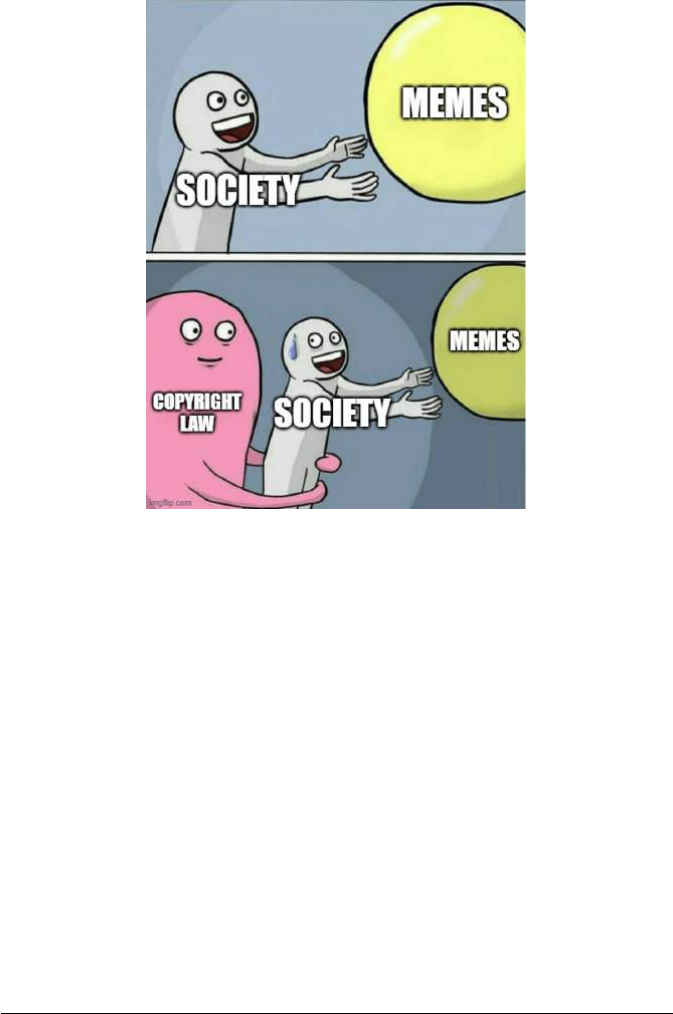
44159-nyu_97-2 Sheet No. 38 Side B 05/17/2022 12:35:30
44159-nyu_97-2 Sheet No. 38 Side B 05/17/2022 12:35:30
\\jciprod01\productn\N\NYU\97-2\NYU201.txt unknown Seq: 72 16-MAY-22 16:37
524 NEW YORK UNIVERSITY LAW REVIEW [Vol. 97:453
IV
H
OW
S
HOULD
C
OPYRIGHT
L
AW
T
HINK
A
BOUT
M
EMES
?
335
As we have shown, memes upend many of copyright law’s central
assumptions. Yet memes are creative works that fall within the scope
of copyright law, as original works of authorship fixed in a tangible
medium of expression.
336
Creators deemed to be authors pursuant to
copyright law can assert their exclusive rights to prevent others from
copying and transforming their works.
337
As such—and as particularly
exemplified by the Socially Awkward Penguin scenario detailed previ-
ously—we think that applying copyright law as is to memes is dan-
gerous if one wants to preserve meme culture.
338
Because copyright
law currently covers memes, it enables the assertion of infringement
claims in ways that can destroy meme culture precisely because of the
multiple mismatches just explored. We think that these mismatches
ought to be taken into account in determining whether and how to
apply existing copyright law to memes, how to modify the applicable
335
Running Away Balloon, K
NOW
Y
OUR
M
EME
, https://knowyourmeme.com/memes/
running-away-balloon [https://perma.cc/XS4S-QFJH].
336
See supra note 6 and accompanying text.
337
See supra Part I.
338
See supra Part II.
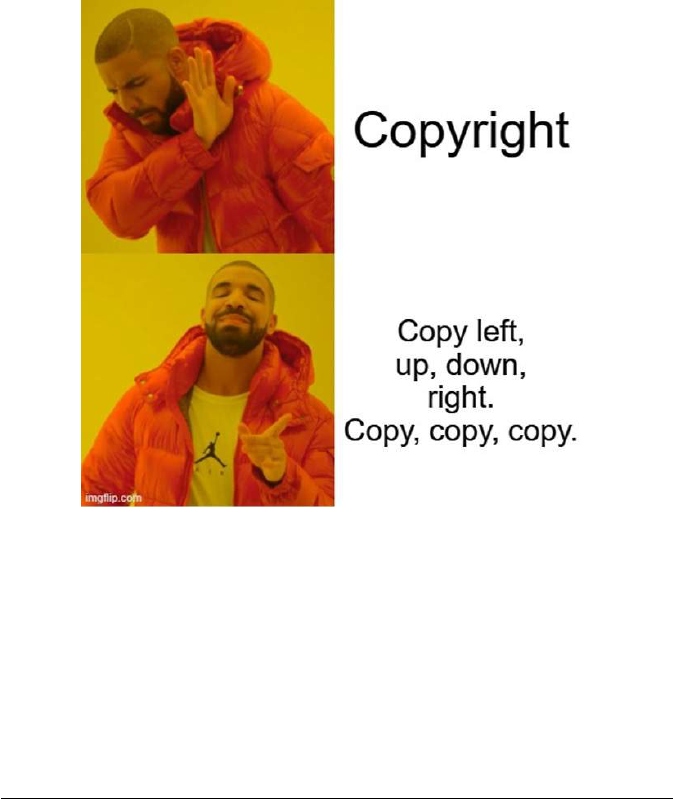
44159-nyu_97-2 Sheet No. 39 Side A 05/17/2022 12:35:30
44159-nyu_97-2 Sheet No. 39 Side A 05/17/2022 12:35:30
\\jciprod01\productn\N\NYU\97-2\NYU201.txt unknown Seq: 73 16-MAY-22 16:37
May 2022] MEMES ON MEMES AND THE NEW CREATIVITY 525
legal regime, or—ultimately—whether any governing legal regime is
ever appropriate.
A. Keep Copyright Law Away from Memes?
339
Over its centuries, copyright law has seen many new media forms
and technologies of distribution develop, including photography,
motion pictures, television, VCRs, search engines, and social media.
In turn, Congress and courts have contended with whether and how to
apply existing copyright rules to these new forms.
340
Many of these
new forms are swept into copyright law, sometimes evaluated under
pre-existing rules and other times under modified rules.
339
Drakeposting
,
K
NOW
Y
OUR
M
EME
, https://knowyourmeme.com/memes/
drakeposting [https://perma.cc/6EFW-PXKD].
340
E.g., Burrow-Giles Lithographic Co. v. Sarony, 111 U.S. 53 (1884) (photography);
Sony Corp. of Am. v. Universal City Studios, Inc., 464 U.S. 417 (1984) (VCR); Cartoon
Network LP v. CSC Holdings, Inc., 536 F.3d 121 (2d Cir. 2008) (DVR); Perfect 10, Inc. v.
Amazon.com, Inc., 508 F.3d 1146 (9th Cir. 2007) (search engine); Goldman v. Breitbart
News Network, LLC, 302 F. Supp. 3d 585 (S.D.N.Y. 2018) (social media); Religious Tech.
Ctr. v. Netcom On-Line Commc’n Servs., Inc., 907 F. Supp. 1361 (N.D. Cal. 1995)
(internet); see also Jeanne C. Fromer & Jessica Silbey, Retelling Copyright: The
Contributions of the Restatement of Copyright Law, 44 C
OLUM
. J.L. & A
RTS
341, 370–71
(2021) (summarizing Congress’s expansions of copyrightable subject matter over time to
include musical compositions and photographs, among other things).

44159-nyu_97-2 Sheet No. 39 Side B 05/17/2022 12:35:30
44159-nyu_97-2 Sheet No. 39 Side B 05/17/2022 12:35:30
\\jciprod01\productn\N\NYU\97-2\NYU201.txt unknown Seq: 74 16-MAY-22 16:37
526 NEW YORK UNIVERSITY LAW REVIEW [Vol. 97:453
At the same time, some expressively creative works—long-
standing forms as well as newer phenomena—sit outside of copyright
law. They do so for one of two reasons: Either these works are
excluded from protection by copyright’s rules or are protectable but
generally not challenged by the relevant creative community. Yet cre-
ativity flourishes in both contexts, yielding a rich set of expressive
works without reliance on copyright protection.
341
Studied categories
of works excluded from copyright protection where creativity pros-
pers include stand-up comedy,
342
cuisine and recipes,
343
and magic.
344
In general, works in these categories often fail copyright’s require-
ments of originality, fixation in a tangible medium of expression, or
not being a method.
345
Creativity also prospers without reliance on copyright law in
some spaces in which it is likely available, such as tattoos
346
and
makeup designs for clowns.
347
Such contexts in which copyright is
available but not asserted tend to be characterized by communal
norms against invoking copyright law. Instead creators rely on alter-
native norms to register or enforce “claims” of ownership.
348
Consider
tattoos: As Aaron Perzanowski explains, even though copyright law
can be invoked to enforce rights in tattoo designs, the tattoo commu-
nity instead relies upon its own norms—sometimes for copying, some-
times against—out of a shared “disdain for authority and a history of
harsh legal regulation that renders them generally hostile to the legal
system,” as well as a “sensitiv[ity] to consumer expectations.”
349
Rights enforcement in meme culture currently is closer to that of
tattoos than stand-up comedy or movies. That is, copyright law is gen-
erally available to protect memes but copyright claims are infre-
quently brought against meme copyists, transformers, and
341
See supra text accompanying note 21.
342
Oliar & Sprigman, supra note 21.
343
Buccafusco, supra note 21; Fauchart & von Hippel, supra note 21.
344
Loshin, supra note 21.
345
See 17 U.S.C. § 102(a) (“Copyright protection subsists . . . in original works of
authorship fixed in any tangible medium of expression.”); id. § 102(b) (“In no case does
copyright protection for an original work of authorship extend to any . . . method of
operation . . . , regardless of the form in which it is described, explained, illustrated, or
embodied in such work.”). With respect to magic in particular, the creative act of “live
performance” cannot be copyrighted. Loshin, supra note 21, at 131.
346
Aaron Perzanowski, Tattoos & IP Norms, 98 M
INN
. L. R
EV
. 511, 513 (2013).
347
David Fagundes & Aaron Perzanowski, Clown Eggs, 94 N
OTRE
D
AME
L. R
EV
. 1313
(2019).
348
See, e.g., Perzanowski, supra note 346, at 513; Fagundes & Perzanowski, supra note
347, at 1318.
349
Perzanowski, supra note 346, at 515.

44159-nyu_97-2 Sheet No. 40 Side A 05/17/2022 12:35:30
44159-nyu_97-2 Sheet No. 40 Side A 05/17/2022 12:35:30
\\jciprod01\productn\N\NYU\97-2\NYU201.txt unknown Seq: 75 16-MAY-22 16:37
May 2022] MEMES ON MEMES AND THE NEW CREATIVITY 527
distributors.
350
As long as this norm continues to hold, meme culture
and the creativity flourishing within it can carry on mostly unimpeded.
Yet norms that tend to tolerate copying and favor nonenforce-
ment of copyright are not always stable. Sometimes norm-shifting
occurs in response to a legal change. For example, although fashion
designs were long understood to be uncopyrightable or minimally
copyrightable due to their functional aspects,
351
the Supreme Court in
2017 established a more protective framework for copyrightability of
fashion designs.
352
Although it is still an open question whether copy-
right claims regarding fashion designs will significantly increase,
353
the
Supreme Court’s decision disrupted an equilibrium in the fashion
industry regarding copyright enforcement.
Norm shifts (and changes in copyright enforcement practices) can
affect the type of works that are created in the first place. Consider
the practice of sampling in hip hop. In decades past, the two most
common types of sampling were use of a single song segment—
whether or not repeatedly or recognizably—and a combination of
many song segments or elements.
354
This latter type of “mash up”
sampling, exemplified by the Beastie Boys’ widely-praised album
Paul’s Boutique,
355
has mostly been abandoned in favor of the former
350
See supra Section II.C.
351
E.g., Raustiala & Sprigman, supra note 301, at 1689.
352
Star Athletica, LLC v. Varsity Brands, Inc., 137 S. Ct. 1002, 1007 (2017) (holding that
“a feature incorporated into the design of a useful article” may be copyrightable if it
“(1) can be perceived as a two- or three-dimensional work of art separate from the useful
article and (2) would qualify as a protectable pictorial, graphic, or sculptural work . . . if it
were imagined separately from the useful article into which it is incorporated”). See
generally Barton Beebe, Star Athletica and the Problem of Panaestheticism, 9 UC I
RVINE
L. R
EV
. 275 (2019); Christopher Buccafusco & Jeanne C. Fromer, Fashion’s Function in
Intellectual Property Law, 93 N
OTRE
D
AME
L. R
EV
. 51 (2017); Christopher Buccafusco &
Jeanne C. Fromer, Essay, Forgetting Functionality, 166 U. P
A
. L. R
EV
. O
NLINE
119 (2017);
Mark P. McKenna, Essay, Knowing Separability When We See It, 166 U. P
A
. L. R
EV
.
O
NLINE
127 (2017); Rebecca Tushnet, Shoveling a Path After Star Athletica, 66 UCLA L.
R
EV
. 1216 (2019).
353
Compare David E. Shipley, All for Copyright Stand Up and Holler! Three Cheers for
Star Athletica and the U.S. Supreme Court’s Perceived and Imagined Separately Test, 36
C
ARDOZO
A
RTS
& E
NT
. L.J. 149, 174–76 (2018) (expecting an increase in claims), with
David Jacoby, ‘Star Athletica’ Three Years On, N.Y. L.J., Aug. 28, 2020 (expressing some
skepticism about such an increase).
354
Ryan Lloyd, Note, Unauthorized Digital Sampling in the Changing Music Landscape,
22 J. I
NTELL
. P
ROP
. L. 143, 153–54 (2014). For a more comprehensive typology of hip hop
sampling, see Amanda Sewell, A Typology of Sampling in Hip-Hop (May 2013) (Ph.D.
dissertation, Indiana University), https://hcommons.org/deposits/objects/hc:18432/
datastreams/CONTENT/content [https://perma.cc/24VD-BEM3].
355
See Nate Patrin, Beastie Boys Paul’s Boutique, P
ITCHFORK
(Feb. 13, 2009), https://
pitchfork.com/reviews/albums/12671-pauls-boutique [https://perma.cc/42VR-UFLZ]; How
the Beastie Boys Made Their Masterpiece, R
OLLING
S
TONE
(Mar. 12, 2013), https://

44159-nyu_97-2 Sheet No. 40 Side B 05/17/2022 12:35:30
44159-nyu_97-2 Sheet No. 40 Side B 05/17/2022 12:35:30
\\jciprod01\productn\N\NYU\97-2\NYU201.txt unknown Seq: 76 16-MAY-22 16:37
528 NEW YORK UNIVERSITY LAW REVIEW [Vol. 97:453
type because of a few copyright rulings against samplers.
356
As Rolling
Stone put it, the Beastie Boys’ album “sampled everyone from the
Ramones to Mountain to the Funky 4+1 and stitched together song
fragments in a way rarely seen before or since.”
357
Even though copy-
right law was even murkier at the time about the need to license their
samples, the band had licensed the 105 songs sampled on the album
for $250,000.
358
After the adverse copyright rulings, sampling licenses
became costlier and were understood to be necessary (at least as a
practical matter for risk-averse record companies); it is estimated that
these licenses today would cost $20 million, a prohibitively expensive
price.
359
In this way, copyright law changed hip hop music, moving it
away from songs comprising interwoven mash-ups to those with a
single or limited number of samples, a more affordable practice.
360
Some have argued this result is good, as those who are sampled get
paid,
361
while some have argued the opposite in that it has stifled valu-
able creativity.
362
But nevertheless, these rulings have undeniably
changed the landscape of hip hop music.
In short, when copyright claims might plausibly be brought, non-
enforcement norms are unstable and can shift in response to even a
single legal ruling, leading to changes in the works created. If a culture
is worth preserving, as meme culture might be, leaving copyright law
to lurk in the background as a potential disruptor leaves the possibility
of significant alterations or curtailments of this culture. Depending on
one’s take on meme culture, perhaps this is a good thing or perhaps
this is a bad thing, but either way it should be contended with.
If one wants to preserve meme culture in the current copyright
regime, one is left with an unstable situation given the inconsistencies
between meme culture and copyright law’s premises. The most signifi-
cant barrier against norm destruction via copyright assertions could be
www.rollingstone.com/music/music-news/how-the-beastie-boys-made-their-masterpiece-
186788 [https://perma.cc/7MCN-DA93].
356
The most notable such ruling is Bridgeport Music, Inc. v. Dimension Films, 410 F.3d
792 (6th Cir. 2005), which held that there is no de minimis exception to infringement
liability for copying sound recordings.
357
R
OLLING
S
TONE
, supra note 355.
358
Casey C. Sullivan, How Litigation Changed Hip Hop Sampling, G
REEDY
A
SSOCIATES
(July 28, 2015), https://blogs.findlaw.com/greedy_associates/2015/07/how-
litigation-changed-hip-hop-sampling.html [https://perma.cc/5USB-BNVV].
359
Id.
360
Cf. Lloyd, supra note 354, at 154 (observing that, due to the imprecise statutory
guidance concerning music sampling, “the act of clearing a sample can be a convoluted and
expensive process for an artist”); Sullivan, supra note 358 (concluding that sample-heavy
music has become more difficult and expensive).
361
E.g., Terry Hart, License to Remix, 23 G
EO
. M
ASON
L. R
EV
. 837 (2016).
362
E.g., Lloyd, supra note 354, at 170 (arguing that increased litigation involving
unauthorized sampling will deter artists from crafting certain creative works).
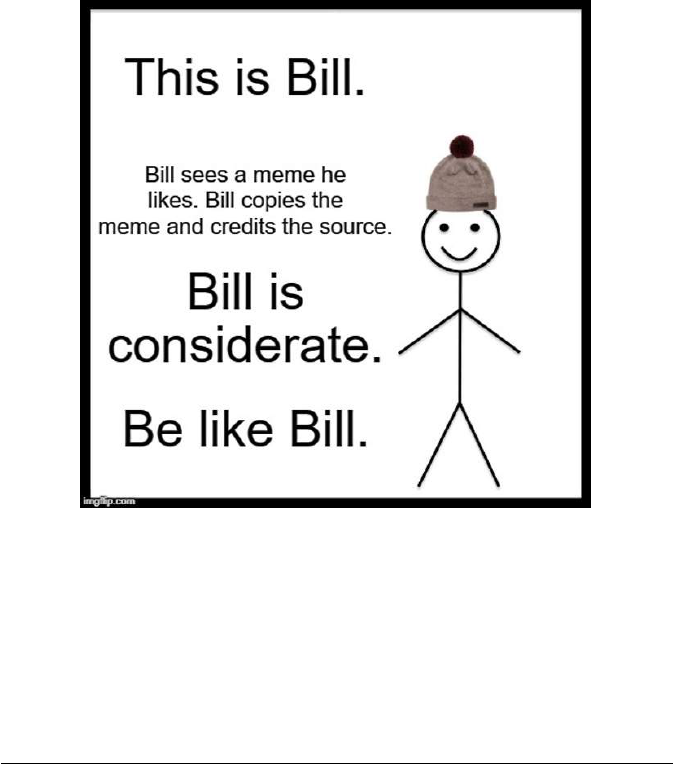
44159-nyu_97-2 Sheet No. 41 Side A 05/17/2022 12:35:30
44159-nyu_97-2 Sheet No. 41 Side A 05/17/2022 12:35:30
\\jciprod01\productn\N\NYU\97-2\NYU201.txt unknown Seq: 77 16-MAY-22 16:37
May 2022] MEMES ON MEMES AND THE NEW CREATIVITY 529
collective shaming upon those who opt to bring legal claims, as
occurred in the Socially Awkward Penguin meme dispute described
above.
363
Such shaming can help keep the copyright nonenforcement
norm relatively intact.
364
Even so, one must accept the deep instability
given the many disconnects between copyright law and meme culture.
As such, promotion of robust affirmative norms or changes to copy-
right law may be preferable to better harmonize the two spaces—
issues to which we now turn.
B. An Attribution Regime?
365
Attribution for meme creation, transformation, and distribution
is one possible norm that meme culture might take on as an alterna-
tive (or supplement) to copyright protection, though it is likely
unworkable. Indeed, as discussed above, attribution has already
reared its head in meme culture.
366
Credit for creative work is gener-
ally something creators consider desirable both for expressive and
363
See supra Section II.C.1.
364
We explore the power of shaming in the opposite direction—to enforce intellectual
property rights—in Adler & Fromer, supra note 47, at 1459.
365
Be Like Bill, K
NOW
Y
OUR
M
EME
, https://knowyourmeme.com/memes/be-like-bill
[https://perma.cc/AX82-9PFX].
366
See supra Section II.C.2.

44159-nyu_97-2 Sheet No. 41 Side B 05/17/2022 12:35:30
44159-nyu_97-2 Sheet No. 41 Side B 05/17/2022 12:35:30
\\jciprod01\productn\N\NYU\97-2\NYU201.txt unknown Seq: 78 16-MAY-22 16:37
530 NEW YORK UNIVERSITY LAW REVIEW [Vol. 97:453
pecuniary reasons.
367
It can bolster a creator’s reputation, thereby
both generating a visible link between creators and their works and
providing more professional opportunities for these creators.
368
As
analyzed above, memes can lead to financial opportunities for their
creators,
369
and for that to happen, memes must be personally attribu-
table in one way or another. The attention-getting campaign against
Instagram user FuckJerry for meme attribution,
370
the Kale Salad
Instagram account that traces memes to their creators and provides
credit,
371
and the Know Your Meme reference site’s encyclopedic
tracking of memes all point to some hunger to credit memes to a
creator.
Attribution is less in tension with meme culture than copyright
law in general is,
372
but it still has some disconnects and impracticali-
ties. In particular, the fast pace of copying and spread of memes
373
might make it hard to attribute memes correctly to their creators.
There is so much creation, copying, and transformation constantly
occurring in meme culture—a culture in which the author is
decentered
374
—that it is hard, and maybe impossible, to know how
many and which creators to whom to attribute a meme. The cumber-
some nature of comprehensive attribution has been noted before with
regard to more traditional expressive works,
375
but the extent of this
concern is exponentially increased with memes because of the scale
and pace of development and creative input. Put another way, the col-
lective nature of authorship with regard to memes makes an attribu-
tion regime seem like a folly.
367
See Fromer, Expressive Incentives, supra note 12, at 1790–92.
368
Id.
369
See supra Section III.C.
370
See supra Section II.C.2.
371
See supra note 320.
372
Cf. Rebecca Tushnet, Payment in Credit: Copyright Law and Subcultural Creativity,
70 L
AW
& C
ONTEMP
. P
ROBS
. 135, 137 (2007) (“[M]oral claims to attribution are widely
recognized in fandom, and attribution rights are far less disruptive to ordinary interpretive
practices than other kinds of moral rights.” (emphasis omitted)).
373
See supra Section III.F.
374
See supra Section III.I.
375
See Jane C. Ginsburg, The Right to Claim Authorship in U.S. Copyright and
Trademarks Law, 41 H
OUS
. L. R
EV
. 263, 304 (2004); Rebecca Tushnet, Naming Rights:
Attribution and Law, 2007 U
TAH
L. R
EV
. 789, 800–16 (2007).
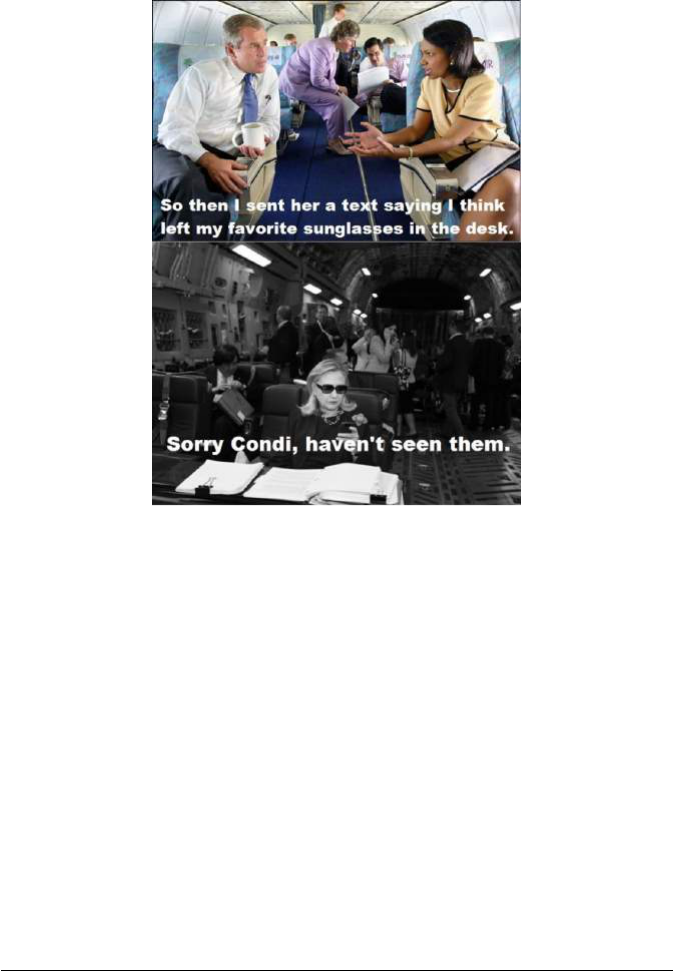
44159-nyu_97-2 Sheet No. 42 Side A 05/17/2022 12:35:30
44159-nyu_97-2 Sheet No. 42 Side A 05/17/2022 12:35:30
\\jciprod01\productn\N\NYU\97-2\NYU201.txt unknown Seq: 79 16-MAY-22 16:37
May 2022] MEMES ON MEMES AND THE NEW CREATIVITY 531
Sample Texts from Hillary Meme
376
Consider the Texts from Hillary meme that was popular in 2012,
in which a photograph of then-Secretary of State Hillary Clinton in an
airplane wearing sunglasses texting on her phone was juxtaposed with
another photograph of someone to hypothesize a text conversation
between them.
377
An example of the meme is shown above. Diane
Walker, upset that her photograph of Clinton was being used in the
meme, asked the initial meme creators to credit her for the photo-
graph on their website, which they did.
378
Yet even conventional
media sources reporting on attribution and other rights in the photo-
graph and meme lamented the difficulties in a broader photograph-
based meme attribution regime. Time noted, “we always aim to credit
photographers, promote their work and link back to the original
source, but today there are no clear rules to follow. (Case in point: we
don’t know where all the photos from Texts from Hillary, used in this
376
Texts from Hillary, K
NOW
Y
OUR
M
EME
, https://knowyourmeme.com/memes/texts-
from-hillary [https://perma.cc/9FFP-R7YU].
377
Id.
378
See Emily Heil, ‘Texts from Hillary’ Photographer Didn’t LOL—at First, W
ASH
.
P
OST
: B
LOG
(Apr. 11, 2012), https://www.washingtonpost.com/blogs/in-the-loop/post/texts-
from-hillary-photographer-didnt-lol-at-first/2012/04/11/gIQApNcZAT_blog.html [https://
perma.cc/WN5S-Q8QE].
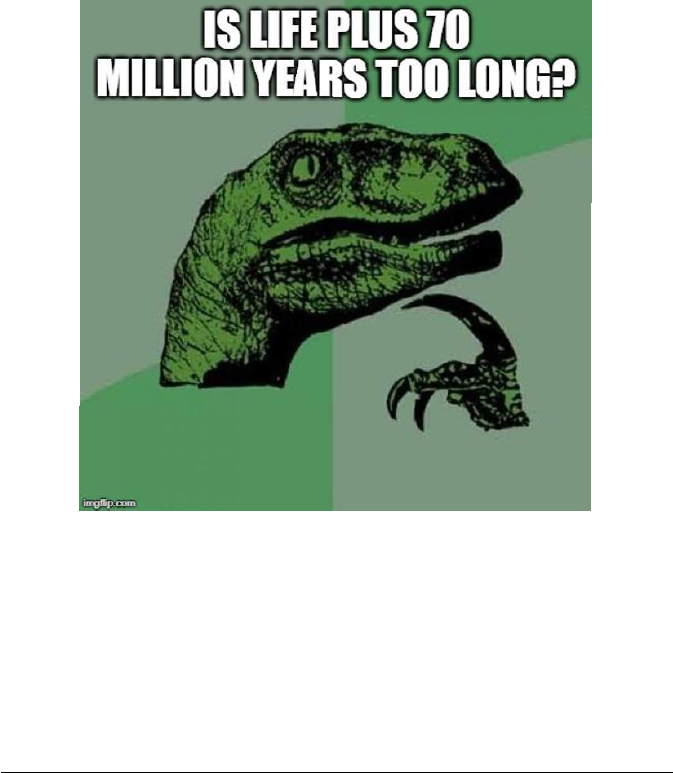
44159-nyu_97-2 Sheet No. 42 Side B 05/17/2022 12:35:30
44159-nyu_97-2 Sheet No. 42 Side B 05/17/2022 12:35:30
\\jciprod01\productn\N\NYU\97-2\NYU201.txt unknown Seq: 80 16-MAY-22 16:37
532 NEW YORK UNIVERSITY LAW REVIEW [Vol. 97:453
gallery, originated.).”
379
As this example shows, as attractive as attri-
bution might be as an alternative regime to copyright law, it might
prove too cumbersome and staid a mismatch for meme culture. The
attribution to a single author, the photographer of the underlying
image, fails to capture the complexity of authorship in the realm of
memes, where a work only becomes a meme if someone takes the
original image and turns it into a meme and others then copy and
transform it.
C. A Shortened Duration?
380
Another possibility to better align copyright law with meme cul-
ture is to create meme-specific copyright rules. One of the most
obvious changes would be to copyright duration, which is now typi-
cally the author’s lifetime plus seventy years.
381
As discussed previ-
ously, some judges and scholars have decried what they see as the
excessively long duration of copyright for traditional works in opposi-
tion to copyright’s aims.
382
Yet given the extraordinarily fast pace by
379
Feifei Sun, The Photograph That Has Everyone Texting Hillary Clinton, T
IME
(Apr.
10, 2012), https://time.com/3787649/texting-hillary-clinton [https://perma.cc/LA8L-LTSR].
380
Philosoraptor
,
K
NOW
Y
OUR
M
EME
, https://knowyourmeme.com/memes/
philosoraptor [https://perma.cc/ERY9-3LMW].
381
See supra Part I.
382
See supra Section I.E.

44159-nyu_97-2 Sheet No. 43 Side A 05/17/2022 12:35:30
44159-nyu_97-2 Sheet No. 43 Side A 05/17/2022 12:35:30
\\jciprod01\productn\N\NYU\97-2\NYU201.txt unknown Seq: 81 16-MAY-22 16:37
May 2022] MEMES ON MEMES AND THE NEW CREATIVITY 533
which memes become stale—on an order of days, weeks, or
months
383
— this critique applies with even greater force to memes. If
there is little to no exploitable value to a meme after this short dura-
tion, it makes no sense to keep copyright’s exclusive rights in effect
and prohibit uses of the meme. Therefore, it could be advisable to
curtail copyright duration to a maximum of a few months for memes,
as a utilitarian theory of copyright aims to key duration to the com-
mercially viable period of a work.
384
This change would correspond
better with what copyright aims to achieve: striking a balance between
providing incentives to creators to make valuable material in the first
instance and allowing society to access and use these materials.
385
Once the incentive to creators becomes near valueless because a work
is no longer economically exploitable, it makes little sense to deny
society access and use of creators’ works. Moreover, by shortening
copyright duration, the mismatch between copyright and meme cul-
ture is minimized to a more manageable time period.
386
Of course,
this assumes that copyright law’s exclusive rights create pecuniary
value during a meme’s productive period, an assumption we think
does not generally hold, as discussed above.
387
383
See supra Sections III.F–G.
384
See supra notes 73–76 and accompanying text. We do not necessarily think this
reasoning applies with the same force to the image underlying a meme and would not
propose curtailed duration for it.
385
See supra Part I.
386
However, shortening the copyright duration flies in the face of current treaty
obligations, which require a minimal duration much longer than that suggested here. See
Berne Convention for the Protection of Literary and Artistic Works art. 7(1), July 14, 1967,
828 U.N.T.S. 221.
387
See supra Sections III.B–C. The limited opportunities for monetization would
suggest that copyright law should not operate during a meme’s productive period either, a
possibility we explore above in Section III.A.

44159-nyu_97-2 Sheet No. 43 Side B 05/17/2022 12:35:30
44159-nyu_97-2 Sheet No. 43 Side B 05/17/2022 12:35:30
\\jciprod01\productn\N\NYU\97-2\NYU201.txt unknown Seq: 82 16-MAY-22 16:37
534 NEW YORK UNIVERSITY LAW REVIEW [Vol. 97:453
D. A Narrowed Copyright Scope?
388
For similar reasons, it might also make sense to construe copy-
right scope more narrowly for memes than for other works. Scope can
be narrowed in several ways that put copyright law in better corre-
spondence with meme culture, thereby allowing more copying, trans-
formation, and distribution of memes to continue unthreatened by a
mismatched copyright law. We raise three of the most salient ways to
narrow scope below.
First, as discussed above, the underlying images used in memes—
which would ordinarily be protectable expression—tend to become
unprotectable ideas when used in memes.
389
Copyright law ought to
take cognizance of this porous boundary between expression and idea
in the context of memes rather than reflexively protecting images used
in memes against meme creators, copyists, and transformers. Once
expression morphs into idea, protecting it can threaten others’ free
expression and creativity. One way to narrow copyright’s scope, then,
is to disallow protection for images that are used in memes, at least
whenever they are used in memes.
Another way in which copyright law might take cognizance of the
characteristics of meme culture is by recognizing that some memes
might lack authorship due to the author’s decentralization.
390
When
that is the case, memes should be denied protection as they are not
the requisite “works of authorship.”
391
While a meme might represent
“original intellectual conceptions” of its creator as doctrinally
388
Community, K
NOW
Y
OUR
M
EME
, https://knowyourmeme.com/memes/subcultures/
community [https://perma.cc/7MUK-EJH7].
389
See supra Section III.E.
390
See supra Section III.I.
391
17 U.S.C. § 102(a).

44159-nyu_97-2 Sheet No. 44 Side A 05/17/2022 12:35:30
44159-nyu_97-2 Sheet No. 44 Side A 05/17/2022 12:35:30
\\jciprod01\productn\N\NYU\97-2\NYU201.txt unknown Seq: 83 16-MAY-22 16:37
May 2022] MEMES ON MEMES AND THE NEW CREATIVITY 535
required for authorship,
392
as a meme spreads, the creator’s concep-
tions can frequently dissipate into nothingness as a meme is absorbed
into culture.
393
Copyright law might therefore understand authorship
in the context of memes not as something static that is either present
or absent, but as something that can be lost as a meme spreads
through society, thereby disqualifying copyright protection.
394
Copyright scope may also be narrowed by expanding the fair use
doctrine. This could be achieved by discounting commercial use as a
rebuttal to fair use for memes, given the fuzzy line between com-
merciality and noncommerciality in meme culture.
395
Additionally, as
Stacey Lantagne, David Tan, Angus Wilson, and others observe,
memes are transformative in their capacity to change the meaning of
or comment on their underlying images and preceding memes.
396
And
a work that is found to be transformative is frequently found to be a
fair use of a copyrighted work.
397
392
Burrow-Giles Lithographic Co. v. Sarony, 111 U.S. 53, 58 (1884).
393
See supra Section III.I. Stacey Lantagne makes a related argument, that memes can
lack the authorship copyright law requires because “a mutating meme scatters authorship
so widely that the resulting creative output is so effectively crowd-sourced as to be a de
facto common good outside of copyright protection.” Stacey M. Lantagne, Mutating
Internet Memes and the Amplification of Copyright’s Authorship Challenges, 17 V
A
.
S
PORTS
& E
NT
. L.J. 221, 222 (2018). She argues this is consistent with courts’ attempts to
avoid outcomes with too many copyright authors. Id. at 229–33 (discussing, for example,
Garcia v. Google, Inc., 786 F.3d 733 (9th Cir. 2015) (en banc), in which the court held that
an actor held no copyright in her short scene in a movie).
394
Cf. J. T
HOMAS
M
C
C
ARTHY
, M
C
C
ARTHY ON
T
RADEMARKS AND
U
NFAIR
C
OMPETITION
§§ 12:25–12:29 (5th ed. 2021) (discussing how trademarks may become
generic as generic use of the mark spreads).
395
See supra Section III.D.
396
See Lantagne, supra note 107, at 414–15; David Tan & Angus Wilson, Copyright Fair
Use and the Digital Carnivalesque: Towards a New Lexicon of Transformative Internet
Memes, 31 F
ORDHAM
I
NTELL
. P
ROP
. M
EDIA
& E
NT
. L.J. 864, 909–14 (2021); Elizabeth
Rocha, Case Note & Comment, Y U No Let Me Share Memes?!—How Meme Culture
Needs a Definitive Test for Noncommercial Speech, 28 D
E
P
AUL
J. A
RT
, T
ECH
. & I
NTELL
.
P
ROP
. L. 37, 42 (2017); cf. Patel, supra note 111, at 252–54 (suggesting that memes support
cultural interchange, which ought to favor fair use).
397
See, e.g., Google LLC v. Oracle Am., Inc., 141 S. Ct. 1183, 1202–04 (2021); Campbell
v. Acuff-Rose Music, Inc., 510 U.S. 569, 578–83 (1994); see Beebe, supra note 286, at
603–06 (finding this effect of transformativeness in a comprehensive empirical study of
courts’ fair use decisions).
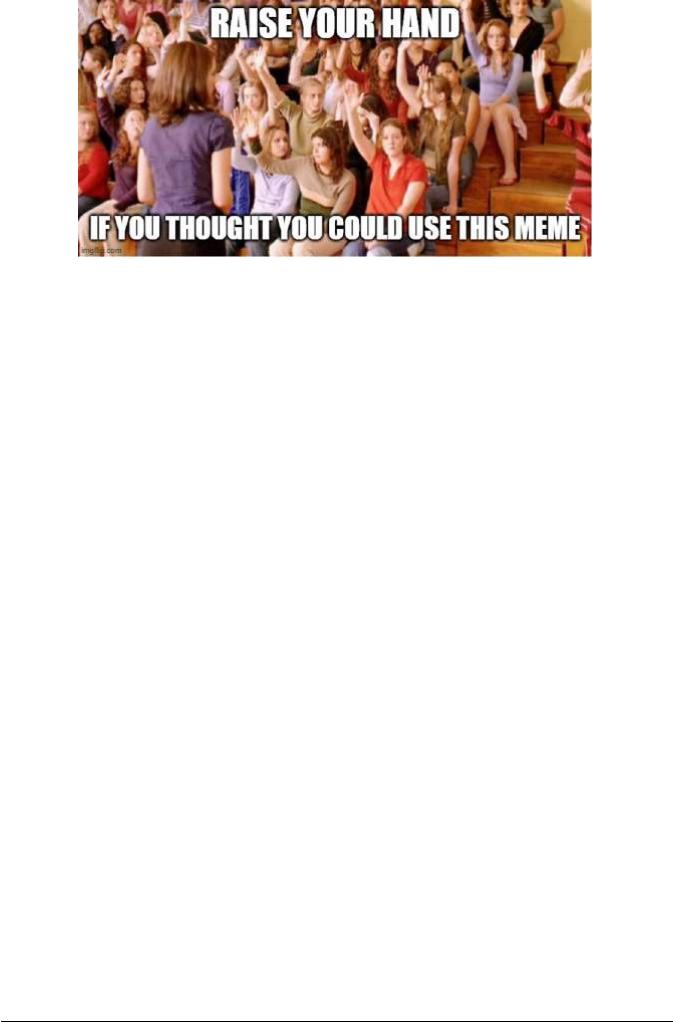
44159-nyu_97-2 Sheet No. 44 Side B 05/17/2022 12:35:30
44159-nyu_97-2 Sheet No. 44 Side B 05/17/2022 12:35:30
\\jciprod01\productn\N\NYU\97-2\NYU201.txt unknown Seq: 84 16-MAY-22 16:37
536 NEW YORK UNIVERSITY LAW REVIEW [Vol. 97:453
E. Addressing Selective Enforcement
398
Whether or not copyright law is curtailed for memes, it is critical
to address the issue of selective enforcement, as well as the related
concern of whether a copyright owner implicitly licenses or abandons
copyright in a work to be memed. As discussed above, memes are
distinctive in that the underlying image creator as well as subsequent
meme creators generally do not assert copyright claims against almost
anyone, though they occasionally seek to stop a selective few from
using their work for certain purposes, principally those that are com-
mercial or those they find politically unpalatable.
399
On the one hand,
this outcome seems to be nothing more than an extension of copy-
right’s grant of control to authors to decide who can and cannot use
their works. On the other hand, when almost everyone except a very
small select few cannot use a work, there are serious concerns for free
speech values.
Before turning to the significant attractions to and worries from
allowing such surgically selective enforcement, we first discuss
whether any plausible copyright owner in the meme chain might be
able to pursue a claim against a subsequent meme creator, distributor,
or transformer. That is, by acquiescing to the memeification of their
image, does a copyright owner implicitly license their work to anyone,
or abandon copyright in the work? Is it reasonable for anyone and
everyone to think they are free to use a meme without copyright
repercussion? If so, selective enforcement is a nonissue because copy-
right cannot be enforced in the first place.
As to implied copyright licenses, courts sometimes infer them
“when the circumstances . . . demonstrate that the parties intended
398
Mean Girls Victimized,
IMGFLIP
, https://imgflip.com/meme/25246414/mean-girls-
victimized [https://perma.cc/VCN6-RGZA]; see also Mean Girls, K
NOW
Y
OUR
M
EME
,
https://knowyourmeme.com/memes/subcultures/mean-girls [https://perma.cc/86XE-
VUHU].
399
See supra Section III.H.

44159-nyu_97-2 Sheet No. 45 Side A 05/17/2022 12:35:30
44159-nyu_97-2 Sheet No. 45 Side A 05/17/2022 12:35:30
\\jciprod01\productn\N\NYU\97-2\NYU201.txt unknown Seq: 85 16-MAY-22 16:37
May 2022] MEMES ON MEMES AND THE NEW CREATIVITY 537
that the work would be used for a specific purpose.”
400
While some
circuits have set out (somewhat circumscribed) multifactor tests to
assess the existence of a nonexclusive implied license, others have
looked to the totality of circumstances.
401
Either way, whether an
implied license exists is expectedly murky.
Abandonment is not much clearer. Unsurprisingly, because copy-
right protects a work of authorship—an abstraction rather than an
actual physical object—copyright abandonment is not a straightfor-
ward inquiry as compared to, say, a couch left on the sidewalk with a
sign indicating it is free to take.
402
Even so, the legal test for copyright
abandonment is the same as for chattel: intent to abandon and an
overt act demonstrating that intent.
403
An abandoned copyright
cannot be owned by someone new; instead, works once protected by
that copyright immediately and irrevocably fall into the public
domain.
404
The difficulty with abandonment, as Dave Fagundes and
Aaron Perzanowski explore, is that the doctrine is hazy, making it
hard to know precisely what constitutes abandonment.
405
Courts are
also unclear whether a copyright can be partially abandoned: For
example, can a copyright owner allow free distribution of derivative
works while nevertheless retaining exclusive rights in the realm of
commercial distribution?
406
As a general matter in copyright law, these doctrines are impre-
cise; with respect to memes, these doctrines are completely unsettled.
To get a sense of how creators might implicitly license their works or
abandon their copyright, consider again the infringement lawsuit
brought by Matt Furie, Pepe the Frog’s creator, against Infowars.
407
In
that case, the defendants claimed that Furie had abandoned his copy-
right based on public statements they characterized as indicating
Furie’s joy “about Pepe the Frog becoming a meme,” his inspiration
“by rampant unauthorized use of the character,” his lack of action
notwithstanding his awareness of third-party profiting, and his
400
W
ILLIAM
F. P
ATRY
, P
ATRY ON
C
OPYRIGHT
§ 5:131 (2021).
401
See 3 M
ELVILLE
B. N
IMMER
& D
AVID
N
IMMER
, N
IMMER ON
C
OPYRIGHT
§ 10.03[a][7] (2021); P
ATRY
, supra note 400, § 5:131.
402
See Dave Fagundes & Aaron Perzanowski, Abandoning Copyright, 62 W
M
. & M
ARY
L. R
EV
. 487, 492–94 (2020) (attempting to make sense of abandonment doctrine in
copyright law).
403
See id. at 493.
404
Cf. Nat’l Comics Publ’ns, Inc. v. Fawcett Publ’ns, Inc., 191 F.2d 594, 599 (2d Cir.
1951) (recognizing that the lack of copyright notice affixation to a published work could
thrust that work into the public domain).
405
Fagundes & Perzanowski, supra note 402, at 540–52.
406
See id. at 549–52 (citing Micro Star v. FormGen, Inc., 154 F.3d 1107, 1114 (9th Cir.
1998)).
407
See supra Section II.C.1.

44159-nyu_97-2 Sheet No. 45 Side B 05/17/2022 12:35:30
44159-nyu_97-2 Sheet No. 45 Side B 05/17/2022 12:35:30
\\jciprod01\productn\N\NYU\97-2\NYU201.txt unknown Seq: 86 16-MAY-22 16:37
538 NEW YORK UNIVERSITY LAW REVIEW [Vol. 97:453
unbothered acknowledgement that “he had lost control over the char-
acter.”
408
For instance, Furie told New York that he “realized that
Pepe is beyond my control . . . He’s like a kid, he grew up and now I
have to set him free to live his life.”
409
And when asked in an Atlantic
interview about how he felt about the alt-right adopting Pepe, Furie
responded:
My feelings are pretty neutral, this isn’t the first time that Pepe has
been used in a negative, weird context. . . . The internet is basically
encompassing some kind of mass consciousness, and . . . I just think
that people reinvent [Pepe] in all these different ways, it’s kind of a
blank slate. It’s just out of my control, what people are doing with it,
and my thoughts on it, are more of amusement.
410
But in response to the defendant’s rebuttal that such statements
amounted to the requisite intent and overt act to abandon any copy-
right interest in Pepe the Frog, Furie pointed to an interview in
Esquire in which he asserted that “Pepe the Frog is copyrighted by
me” and made other statements indicating a desire to enforce his cop-
yright.
411
Based on the statements, the district court ruled that there
was a dispute of material facts and denied summary judgment on
abandonment,
412
after which the case settled.
413
On the implied-
license defense, the court granted summary judgment to Furie, rea-
soning that Furie’s statements did not constitute an offer to contract
and there was no consideration.
414
The court’s reasoning indicates that it will be difficult, though
sometimes possible, to prove abandonment or implied license. It is
also more likely that copyright will be found to have been abandoned
or an implied license created with regard to memes rather than the
underlying images contained in memes. The circumstances of meme
culture lend themselves better to a conclusion that the creator wanted
their work to be copied, transformed, and distributed freely, whereas
no such understanding might sit in the background for creators of the
underlying images used in memes. But with abandonment and implied
license murkily available on the right set of facts, we now consider
how to analyze situations where copyright remains intact and the
owner is engaging in surgical selective enforcement.
408
Furie v. Infowars, LLC, 401 F. Supp. 3d 952, 965 (C.D. Cal. 2019).
409
Id. (alteration in original).
410
Id.
411
Id. at 966.
412
Id.
413
See supra Section II.C.1.
414
Furie, 401 F. Supp. 3d at 968–69.
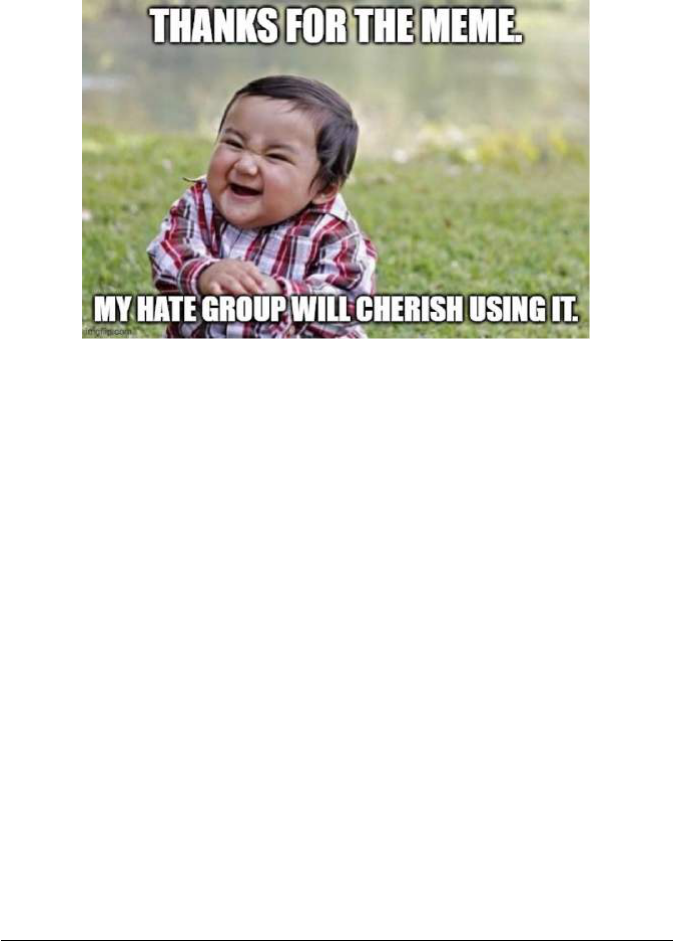
44159-nyu_97-2 Sheet No. 46 Side A 05/17/2022 12:35:30
44159-nyu_97-2 Sheet No. 46 Side A 05/17/2022 12:35:30
\\jciprod01\productn\N\NYU\97-2\NYU201.txt unknown Seq: 87 16-MAY-22 16:37
May 2022] MEMES ON MEMES AND THE NEW CREATIVITY 539
1. The Worry of Forcing Creators to Allow Universal Use
415
One can see the motivation behind granting copyright owners
control to decide who should be allowed to use their work.
416
Just as
parents want to ensure their children are left in good hands with a
caregiver, authors are frequently protective of their works. Economi-
cally, authors want to control who exercises copyright rights to make
sure that third parties will not undercut the market for the author’s
works.
417
Moreover, as a matter of moral rights, authors often want to
make sure that third parties are not using their works in ways that run
contrary to an author’s vision or brand.
418
To the extent that creation
is actually spurred through copyright law’s incentives, authors might
be reluctant to create were they to lose control over who can and
cannot license their works.
419
Telling an author that they must allow
anyone, including an organization they consider to be a hate or
extremist group, to use their work might feel akin to handing over
one’s baby so they can be indoctrinated and turned evil.
Indeed, recent incidents confirm that creators can feel this way.
For example, Matt Furie, in addition to asserting his creative owner-
ship of Pepe,
420
expressed his dismay at the alt-right having adopted
Pepe as a symbol in their memes. That Pepe—a “peaceful frog-
dude”—has been labeled a hate symbol and shared among racists and
415
Evil Toddler, K
NOW
Y
OUR
M
EME
, https://knowyourmeme.com/memes/evil-toddler
[https://perma.cc/H5RN-L9HQ].
416
See supra Section I.F.
417
Cf. Fromer & Lemley, supra note 83 (arguing that copyright law is centrally about
protecting creators from market substitutions).
418
See R
OBERTA
R
OSENTHAL
K
WALL
, T
HE
S
OUL OF
C
REATIVITY
: F
ORGING A
M
ORAL
R
IGHTS
L
AW FOR THE
U
NITED
S
TATES
53–55 (2010).
419
See Fromer, Expressive Incentives, supra note 12.
420
See supra notes 407–14 and accompanying text.

44159-nyu_97-2 Sheet No. 46 Side B 05/17/2022 12:35:30
44159-nyu_97-2 Sheet No. 46 Side B 05/17/2022 12:35:30
\\jciprod01\productn\N\NYU\97-2\NYU201.txt unknown Seq: 88 16-MAY-22 16:37
540 NEW YORK UNIVERSITY LAW REVIEW [Vol. 97:453
anti-Semites was, to Furie, “completely insane” and “a nightmare.”
421
He continued: “[T]he only thing I can do is see this as an opportunity
to speak out against hate. . . . I understand that it’s out of my control,
but in the end, Pepe is whatever you say he is, and I, the creator, say
that Pepe is love.”
422
Even further, Furie forewent economic opportu-
nities by ceasing to sell Pepe merchandise to avoid it being worn by
groups he found hateful.
423
The copyright owner’s interest in controlling who can use their
work, however, is not the full story. There are weighty interests on the
other side, especially when a copyright owner is engaged in surgical
selective enforcement, to which we now turn.
2. The Worry of Selective Silencing
424
When everyone but a handful of people or groups is permitted to
use an image in a meme or copy and transform a meme—something
that seems to be an extension of copyright’s allowance of selectivity—
421
Matt Furie, Pepe the Frog’s Creator: I’m Reclaiming Him. He Was Never About Hate,
T
IME
(Oct. 13, 2016), https://time.com/4530128/pepe-the-frog-creator-hate-symbol [https://
perma.cc/R5E2-GGNU].
422
Id. Not dissimilar is the pain actress Cindy Lee Garcia felt after her lines spoken in a
film—Innocence of Muslims—were redubbed to have her ask, “Is your Mohammed a child
molester?” Unbeknownst to Garcia, this film had an anti-Islam agenda and was not the
adventure story that was initially advertised to her. Garcia sued but lost her claim for
copyright infringement. Garcia v. Google, Inc., 786 F.3d 733 (9th Cir. 2015) (en banc).
423
See Sam Thielman, Matt Furie on Life After Pepe the Frog: ‘You Have to Lead by
Example,’ G
UARDIAN
(Oct. 29, 2020), https://www.theguardian.com/books/2020/oct/29/
matt-furie-on-life-after-pepe-the-frog-lead-by-example-mindviscosity [https://perma.cc/
7S7L-CJ77]. This is not the only meme adopted by the alt-right. Alt-right groups have also
adopted brands, such as Fred Perry (for shirts), that quickly disowned them. Jon Jackson,
Marvel’s Punisher Problem, N
EWSWEEK
(Mar. 10, 2021), https://www.newsweek.com/
marvels-punisher-problem-1574579 [https://perma.cc/UBN2-5EWA].
424
Jon Stewart, K
NOW
Y
OUR
M
EME
, https://knowyourmeme.com/memes/people/jon-
stewart [https://perma.cc/W9MC-7Y7V].
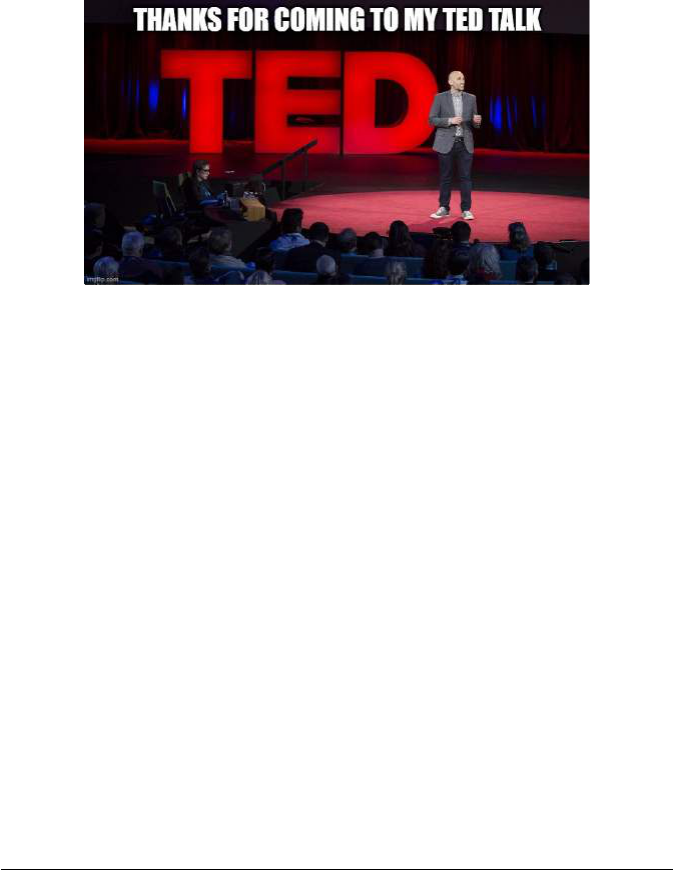
44159-nyu_97-2 Sheet No. 47 Side A 05/17/2022 12:35:30
44159-nyu_97-2 Sheet No. 47 Side A 05/17/2022 12:35:30
\\jciprod01\productn\N\NYU\97-2\NYU201.txt unknown Seq: 89 16-MAY-22 16:37
May 2022] MEMES ON MEMES AND THE NEW CREATIVITY 541
this creates a situation typically unseen in copyright law: Only a select
few are silenced from using a copyrighted work, rather than the his-
torically typical situation in which only a select few are allowed to use
a copyrighted work.
425
This circumstance creates worries heretofore
generally unseen in copyright law, principally to free speech values.
a. Nearly Everyone Gets to Use a Meme
426
Once a meme is created and begins to spread virally, many
people partaking in meme culture will copy, transform, or distribute
the meme. They will use it to participate in digital culture, communi-
cate their take on the meme, seek to fit in with various communities,
and try to get attention.
427
There might in fact be no better way to
accomplish these communicative and other goals online than through
using the meme. Social media platforms, and online culture more
broadly, give individuals a megaphone to accomplish their goals,
wherein each meme is akin to a personal mini-TED talk.
425
See supra Sections I.F, III.H.
426
Thanks for Coming to My TED Talk, K
NOW
Y
OUR
M
EME
, https://
knowyourmeme.com/memes/thanks-for-coming-to-my-ted-talk [https://perma.cc/ZT88-
7NV9].
427
See supra Part II.
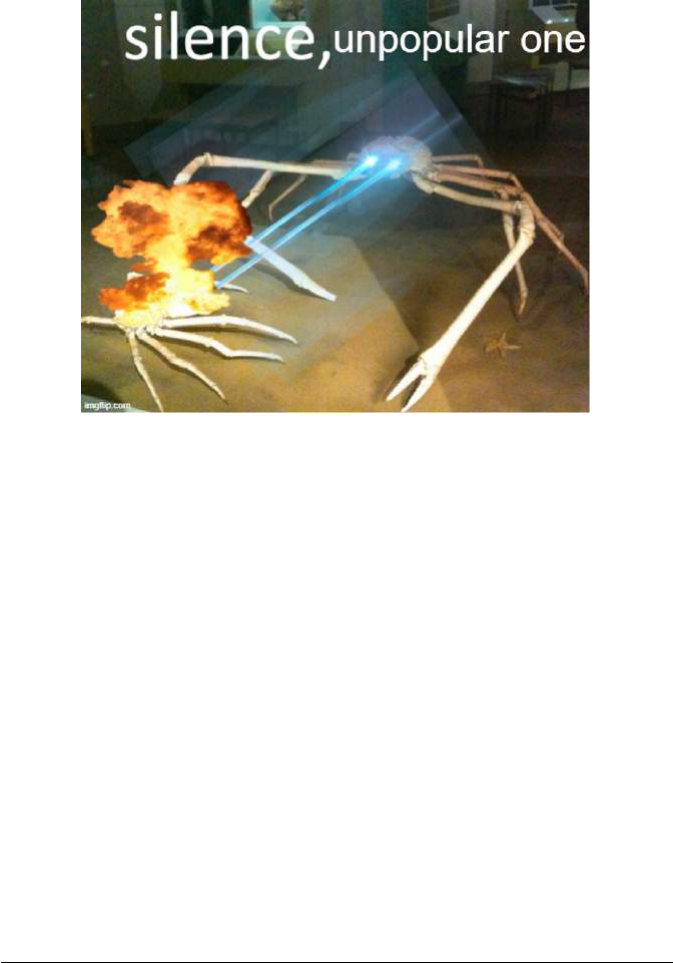
44159-nyu_97-2 Sheet No. 47 Side B 05/17/2022 12:35:30
44159-nyu_97-2 Sheet No. 47 Side B 05/17/2022 12:35:30
\\jciprod01\productn\N\NYU\97-2\NYU201.txt unknown Seq: 90 16-MAY-22 16:37
542 NEW YORK UNIVERSITY LAW REVIEW [Vol. 97:453
b. Except a Select Few
428
Yet at the same time, a very select few might be singled out and
challenged under copyright law not to be able to use a meme. Pepe
the Frog is perhaps the most prominent example, but there have been
other copyright claims brought against figures that are politically
unpopular with certain copyright holders, such as Steve King,
429
Donald Trump, various pro-Trump memists, and alt-right figures.
430
In
addition, as discussed above, copyright holders in memes and images
used in memes have brought suit against a small number of commer-
cial uses of their works.
431
We think that such surgical selective enforcement raises free
speech concerns not usually present in copyright law. By invoking
copyright to silence only the very few found to be politically (or other-
wise) unpalatable from using a meme, copyright law can fall on the
wrong side of the balance between free speech and exclusive rights
preventing another from speaking.
In the past, the Supreme Court has rejected First Amendment
challenges to copyright law’s restriction of speech, holding that copy-
right law already “incorporates its own speech-protective purposes
428
Shut the Fuck Up, Liberal, K
NOW
Y
OUR
M
EME
, https://knowyourmeme.com/memes/
shut-the-fuck-up-liberal [https://perma.cc/TDC3-WKLH].
429
See supra Section II.C.1 (discussing the Success Kid image creator going after Steve
King).
430
E.g., Lawsuit Against Carpe Donktum over Pro-Trump Meme Dismissed, P
OST
M
ILLENNIAL
(July 9, 2021), https://thepostmillennial.com/lawsuit-against-carpe-donktum-
over-pro-trump-meme-dismissed [https://perma.cc/S3CM-74LX].
431
See supra Section II.C.1.

44159-nyu_97-2 Sheet No. 48 Side A 05/17/2022 12:35:30
44159-nyu_97-2 Sheet No. 48 Side A 05/17/2022 12:35:30
\\jciprod01\productn\N\NYU\97-2\NYU201.txt unknown Seq: 91 16-MAY-22 16:37
May 2022] MEMES ON MEMES AND THE NEW CREATIVITY 543
and safeguards.”
432
Copyright not only plays a role in “spurring the
creation and publication of new expression,”
433
but as the Court has
explained, there are also “First Amendment protections already
embodied” in copyright law.
434
In particular, the Court has identified
two built-in features of copyright law that act as First Amendment
checks: the idea-expression distinction and the fair use defense. As the
Court has explained, “copyright’s idea/expression dichotomy ‘strike[s]
a definitional balance between the First Amendment and the
Copyright Act by permitting free communication of facts while still
protecting an author’s expression.’”
435
Furthermore, the fair use
defense “allows the public to use not only facts and ideas contained in
a copyrighted work, but also expression itself in certain
circumstances.”
436
Scholars have reasonably questioned the Court’s decision to
immunize copyright law from First Amendment scrutiny and instead
rely exclusively upon copyright’s internal safeguards, an approach not
taken with regard to other laws.
437
Either way, if courts deem memes
or their underlying images to be protected expression, and find cop-
ying is not excusable as fair use or otherwise,
438
this will allow copy-
right owners to engage in surgically selective enforcement in ways that
silence only a few. If memes are the communicative currency—and
indeed, for many, they currently are
439
—and because they serve as
ideas in critical ways—which ought to be unprotectable by copy-
right
440
—hyper-targeted enforcement against a select few is problem-
atic to free speech values. Of course, the forbidden few can use other
images or memes—assuming those are not held off limits to them
too—but that is beside the point when specific memes are the cultural
432
Eldred v. Ashcroft, 537 U.S. 186, 219 (2003).
433
Id.
434
Harper & Row, Publishers, Inc. v. Nation Enters., 471 U.S. 539, 560 (1985).
435
Id. at 556 (alteration in original) (quoting Harper & Row, Publishers, Inc. v. Nation
Enters., 723 F.2d 195, 203 (2d Cir. 1983)).
436
Eldred, 537 U.S. at 219–20; accord Golan v. Holder, 565 U.S. 302, 327–30 (2012).
437
E.g., Joseph P. Liu, Copyright and Breathing Space, 30 C
OLUM
. J.L. & A
RTS
429
(2007); Netanel, supra note 175 (arguing that while the courts have treated copyright law
anomalously, this stance is wrong and should be subject to First Amendment doctrine);
Alfred C. Yen, A First Amendment Perspective on the Idea/Expression Dichotomy and
Copyright in a Work’s “Total Concept and Feel,” 38 E
MORY
L.J. 393 (1989). But see
Melville B. Nimmer, Does Copyright Abridge the First Amendment Guarantees of Free
Speech and Press?, 17 UCLA L. R
EV
. 1180 (1970) (presaging the Supreme Court’s
approach).
438
See supra Section IV.D.
439
See supra Sections II.A–B.
440
See supra Section III.E.

44159-nyu_97-2 Sheet No. 48 Side B 05/17/2022 12:35:30
44159-nyu_97-2 Sheet No. 48 Side B 05/17/2022 12:35:30
\\jciprod01\productn\N\NYU\97-2\NYU201.txt unknown Seq: 92 16-MAY-22 16:37
544 NEW YORK UNIVERSITY LAW REVIEW [Vol. 97:453
currency.
441
Indeed, in the traditional First Amendment context of
government censorship, the Supreme Court explicitly noted that a
particular mode of expression might sometimes be necessary to
express an idea. As the Court explained in Cohen v. California: “[W]e
cannot indulge the facile assumption that one can forbid particular
words without also running a substantial risk of suppressing ideas in
the process.”
442
All in all, given that copyright law’s fundamental assumptions are
so mismatched with meme culture, if we assume meme culture is
worth preserving, it could prove dangerous to rest on the current
norm of copyright nonenforcement. Instead, it would be worth rejig-
gering copyright law to put it in better accordance with meme culture
and free speech values.
441
Cf. Fromer, Information Theory, supra note 63, at 92–96 (explaining how some
expression needs to be reused by others to extract the value copyright law is designed to
provide). Given that nearly everyone is permitted to use creative works in making and
sharing memes, the individuals later asked to desist might have reasonably relied on these
works being available to them, providing another reason to worry about surgically selective
enforcement.
442
403 U.S. 15, 26 (1971); accord FCC v. Pacifica Found., 438 U.S. 726, 773 (1978)
(Brennan, J., dissenting) (“The idea that the content of a message and its potential impact
. . . can be divorced from the words that are the vehicle for its expression is transparently
fallacious. A given word may have a unique capacity to capsule an idea, evoke an emotion,
or conjure up an image.”).

44159-nyu_97-2 Sheet No. 49 Side A 05/17/2022 12:35:30
44159-nyu_97-2 Sheet No. 49 Side A 05/17/2022 12:35:30
\\jciprod01\productn\N\NYU\97-2\NYU201.txt unknown Seq: 93 16-MAY-22 16:37
May 2022] MEMES ON MEMES AND THE NEW CREATIVITY 545
V
B
EYOND
M
EMES
443
As we have shown, memes depart from several of the most basic
pillars of copyright theory.
444
But how significant an issue is this
departure? If memes are sui generis, a one-off exception to the prem-
ises of copyright law, then the problem is relatively contained. But we
think this is far from the case. Instead, the concern with memes signals
a much broader problem in copyright law and theory.
In our view, memes expose two profound problems in copyright
law and theory. First, before the advent of meme culture, scholars and
courts had already questioned several basic concepts in copyright law,
some of which are the very ones that memes have now pushed to their
limits.
445
In Part III, we argued that memes render nonsensical certain
pillars of copyright law, such as the idea-expression distinction, the
distinction between commercial and noncommercial uses in fair use,
and even the conventional notion of the author.
446
Meme culture has
now pushed these already problematic copyright principles to a
breaking point. Second, rather than a one-off exception to the prem-
ises of copyright law, memes are instead a prototype of a new mode of
creativity that is emerging in our contemporary digital era. Thus, the
443
Disaster Girl, K
NOW
Y
OUR
M
EME
, https://knowyourmeme.com/memes/disaster-girl
[https://perma.cc/RPQ7-XQZ5].
444
See supra Part III.
445
See, e.g., Netanel, supra note 64 (challenging the idea-expression distinction); notes
74–76 and accompanying text (questioning copyright’s duration); notes 89–90 and
accompanying text (attacking the author’s centrality within copyright).
446
See supra Sections III.D–E, III.I.
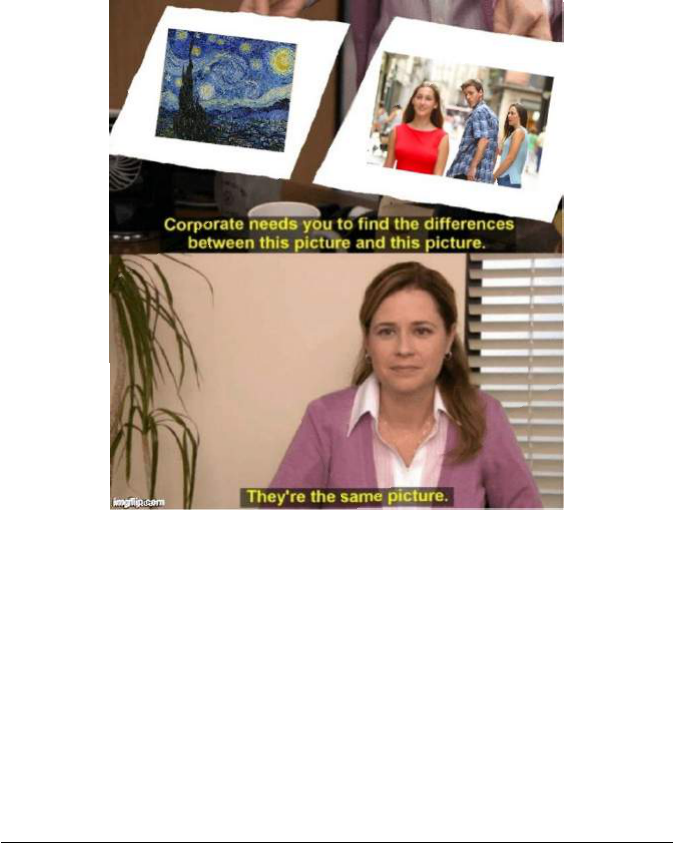
44159-nyu_97-2 Sheet No. 49 Side B 05/17/2022 12:35:30
44159-nyu_97-2 Sheet No. 49 Side B 05/17/2022 12:35:30
\\jciprod01\productn\N\NYU\97-2\NYU201.txt unknown Seq: 94 16-MAY-22 16:37
546 NEW YORK UNIVERSITY LAW REVIEW [Vol. 97:453
problems we have explored with memes go to the core of copyright’s
role in advancing creativity.
We begin by exploring ways in which traditional works already
share certain aspects of meme culture. We then show how memes are
part of a broader shift in creativity in digital culture. Finally, we ana-
lyze the recent craze for non-fungible tokens (NFTs) as a reaction to
memes and to the post-rarity culture that they emblematize.
A. Traditional Works Can Be Like Memes
447
Traditional works fit copyright’s foundational assumptions much
better than memes do.
448
Nonetheless, certain aspects of memes that
we highlight in this Article were already present—to varying
degrees—in some creative works that preceded memes. Here we point
out a few ways in which traditional works could be reconsidered
through the lens of memes.
Most prominently, copying and repetition, so essential to memes,
have always been a part of creativity as evidenced by repeated motifs,
447
They’re the Same Picture, K
NOW
Y
OUR
M
EME
, https://knowyourmeme.com/memes/
theyre-the-same-picture [https://perma.cc/L8TA-RMXW].
448
See supra Part I.

44159-nyu_97-2 Sheet No. 50 Side A 05/17/2022 12:35:30
44159-nyu_97-2 Sheet No. 50 Side A 05/17/2022 12:35:30
\\jciprod01\productn\N\NYU\97-2\NYU201.txt unknown Seq: 95 16-MAY-22 16:37
May 2022] MEMES ON MEMES AND THE NEW CREATIVITY 547
themes, and allusions that characterize the literary tradition,
449
the
history of art,
450
music,
451
and many other creative practices.
452
For
example, we could reimagine the trope of the reclining Venus in art
history as a kind of proto-meme: an image on which artists rely
because it is immediately recognizable as part of a tradition of pre-
vious works, and yet one that artists transform with each individual
repetition. Consider the reclining Venus images below, from contem-
porary to Renaissance: Mickalene Thomas’s A Little Taste Outside of
Love,
453
which reimagined through the lens of race Manet’s
Olympia,
454
whose meaning in turn depended on its reference to
Titian’s Venus of Urbino,
455
which in turn had drawn on Giorgione’s
Sleeping Venus.
456
Whereas the Renaissance works depicted an ideal-
ized erotic goddess, Manet’s pictured a prostitute as Venus, prompting
the novelist Emile Zola to write, “When our artists give us Venuses,
they correct nature, they lie. Edouard Manet asked himself why lie,
why not tell the truth; he introduced us to Olympia, this fille of our
time, whom you meet on the sidewalks.”
457
Mickalene Thomas’s con-
temporary work repeats the trope while changing it again. As the
Brooklyn Museum describes the work, Thomas “turns the historic
nude on its head and ousts the white European woman from the bed
where she often lounges, attended by a black maidservant, in Western
art.”
458
449
As the literary critic Northrop Frye wrote in the mid-twentieth century, “Poetry can
only be made out of other poems; novels out of other novels.” N
ORTHROP
F
RYE
, Ethical
Criticism: Theory of Symbols, in A
NATOMY OF
C
RITICISM
: F
OUR
E
SSAYS
71, 97 (1957).
450
See Adler, Fair Use, supra note 46, at 568–69 (arguing that the history of art depends
on the longstanding tradition of borrowing from others’ works).
451
See Olufunmilayo B. Arewa, From J.C. Bach to Hip Hop: Musical Borrowing,
Copyright and Cultural Context, 84 N.C. L. R
EV
. 547 (2006) (arguing that the history of
music shows the continuity and importance of musical borrowing).
452
See Adler & Fromer, supra note 47, at 1529 (citing arguments that the history of art,
music, literature, and fashion depend on copying, emulating, alluding to, reworking, or
changing pre-existing works to create new ones).
453
Mickalene Thomas, A Little Taste Outside of Love, B
ROOKLYN
M
USEUM
(2007),
https://www.brooklynmuseum.org/opencollection/objects/5044 [https://perma.cc/Q2JK-
EC27].
454
´
Edouard Manet, Olympia, PBS: F
LASHPOINTS
(1865), https://www.pbs.org/wgbh/
cultureshock/flashpoints/visualarts/olympia_a.html [https://perma.cc/9LAJ-VMWW].
455
Titian, Venus of Urbino,L
E
G
ALLERIE
D
EGLI
U
FFIZI
(1538), https://www.uffizi.it/en/
artworks/venus-urbino-titian [https://perma.cc/5ZWW-KVLW].
456
Giorgione, The Sleeping Venus, W
IKI
A
RT
(1508–1510), https://www.wikiart.org/en/
giorgione/the-sleeping-venus-1510 [https://perma.cc/U86J-B3L8].
457
Frits Andersen, Corpus Delicti: Zola’s Nana, Breton’s Nadja—Siamese Twins in the
Body of the Novel, in R
EINVENTIONS OF THE
N
OVEL
: H
ISTORIES AND
A
ESTHETICS OF A
P
ROTEAN
G
ENRE
79 (Karen-Margrethe Simonsen, Marianne Ping Huang & Mads
Rosendahl Thomsen, eds., 2004).
458
Thomas, supra note 453.
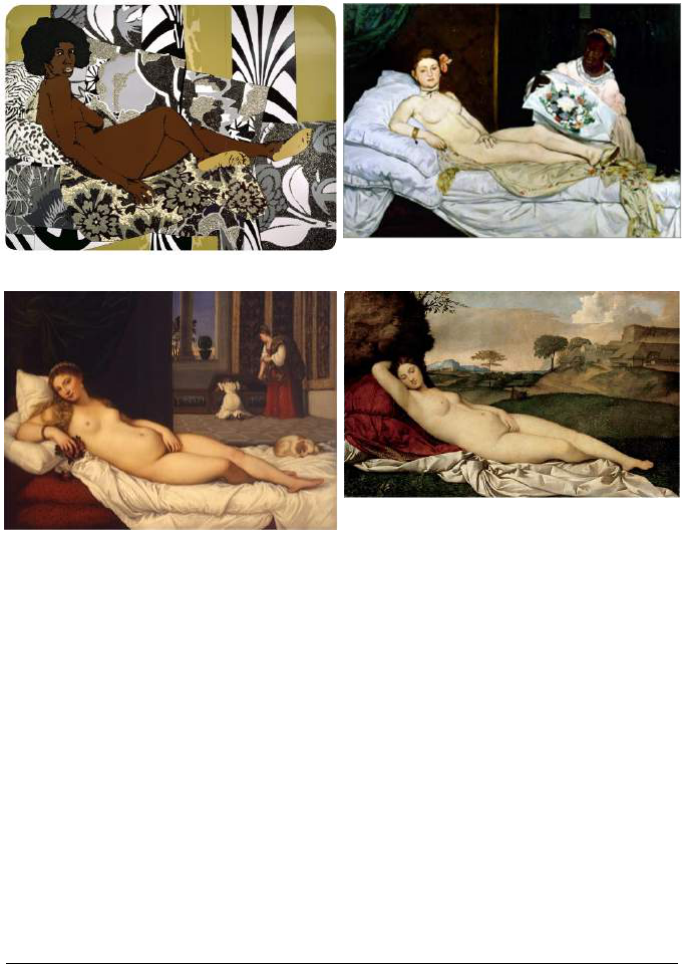
44159-nyu_97-2 Sheet No. 50 Side B 05/17/2022 12:35:30
44159-nyu_97-2 Sheet No. 50 Side B 05/17/2022 12:35:30
\\jciprod01\productn\N\NYU\97-2\NYU201.txt unknown Seq: 96 16-MAY-22 16:37
548 NEW YORK UNIVERSITY LAW REVIEW [Vol. 97:453
Mickalene Thomas, A Little Taste Outside of Love
459
(left);
´
Edouard Manet, Olympia
460
(right)
Titian, Venus of Urbino
461
(left); Giorgione, Sleeping Venus
462
(right)
Similarly, in music, certain phrases of expression that have been
repeatedly alluded to and transformed can be thought of as meme-
like. We could characterize snippets of songs in hip hop as analogous
to memes—copies that conjure up a tradition of previous works while
at the same time altering and advancing that tradition. For example,
record producer and acclaimed DJ Mark Ronson has explored the
extraordinary persistence of one of the most sampled songs of all
time, “La Di Da Di” by Slick Rick & Doug E. Fresh.
463
Ronson shows
how it gave birth to a lineage of songs, including music by Snoop
Dogg, the Notorious B.I.G., and Miley Cyrus.
464
Some traditional works outside of meme culture also depart from
other copyright assumptions in ways that parallel the problems we
have explored with memes. For example, musicians have sometimes
engaged in surgically selective enforcement of copyright, objecting to
459
Id.
460
Manet, supra note 454.
461
Titian, supra note 455.
462
Giorgione, supra note 456.
463
See Mark Ronson, T
ED
T
ALK
, How Sampling Transformed Music (Mar. 2014),
https://www.ted.com/talks/mark_ronson_how_sampling_transformed_music [https://
perma.cc/M76A-B9ZB].
464
Id. at 08:45–12:55.

44159-nyu_97-2 Sheet No. 51 Side A 05/17/2022 12:35:30
44159-nyu_97-2 Sheet No. 51 Side A 05/17/2022 12:35:30
\\jciprod01\productn\N\NYU\97-2\NYU201.txt unknown Seq: 97 16-MAY-22 16:37
May 2022] MEMES ON MEMES AND THE NEW CREATIVITY 549
a song’s use by particular politicians while otherwise permitting broad
licensing.
465
These disputes, several of which arose for songs that
Donald Trump used at political rallies,
466
tended to focus on whether
the use of the musical works occurred pursuant to a blanket license
agreement.
467
Some musicians have sued directly for copyright
infringement in cases that ultimately turned on fair use.
468
For
example, Don Henley sued politician Charles DeVore, a Republican
candidate for the U.S. Senate in California, for using Henley’s songs
“The Boys of Summer” and “All She Wants to Do Is Dance” in two
political advertisements.
469
Another example of a longstanding art form outside of meme cul-
ture that bears some striking similarities to memes is graffiti.
470
Like
memes, street art as a genre is ephemeral, fast-moving, and often col-
laborative; artists frequently expect others to write over their works,
rather than to preserve them exactly as is in perpetuity.
471
For
example, in a recent case involving 5Pointz, the celebrated New York
City graffiti site, the Second Circuit described the ethos of “creative
destruction” that characterizes graffiti.
472
As the court explained,
while some art at 5Pointz “achieved permanence,” most of it “had a
short lifespan and was repeatedly painted over.”
473
Indeed, street art
works sometimes result from frequent modifications (invited or not)
among artists who repeatedly alter and overpaint each other’s
465
See supra Sections III.H, IV.E. For one account of these disputes, see Danwill D.
Schwender, The Copyright Conflict Between Musicians and Political Campaigns Spins
Around Again, 35 A
M
. M
USIC
490, 492 (Winter 2017) (discussing Mike Huckabee’s use of
Eye of the Tiger song by Survivor without a license at a rally as well as Donald Trump’s
licensed but unwelcome use of Neil Young’s song Rockin’ in the Free World).
466
See generally Devon Ivie, The Ongoing History of Musicians Saying ‘Hell No’ to
Donald Trump Using Their Songs, V
ULTURE
, https://www.vulture.com/article/the-history-
of-musicians-rejecting-donald-trump.html [https://perma.cc/NL23-V4LD].
467
See Arlen W. Langvardt, Musicians, Politicians, and the Forgotten Tort, 27
F
ORDHAM
I
NTELL
. P
ROP
., M
EDIA
& E
NT
. L.J. 429, 431, 433 (2017).
468
E.g., Henley v. DeVore, 733 F. Supp. 2d 1144 (C.D. Cal. 2010); Browne v. McCain,
611 F. Supp. 2d 1062 (C.D. Cal. 2009).
469
Henley, 733 F. Supp. 2d at 1147–48 (finding the politician Charles DeVore’s use in
political advertisements of two copyrighted Don Henley songs, “The Boys of Summer” and
“All She Wants to Do Is Dance,” was not fair use).
470
See Russell, supra note 263 (arguing that street art is a metaphor for art in digital
culture).
471
See Al Roundtree, Note, Graffiti Artists “Get Up” in Intellectual Property’s Negative
Space, 31 C
ARDOZO
A
RTS
& E
NT
. L.J. 959, 964, 981 (2013) (discussing the reasons behind
and norms associated with painting over previously existing graffiti).
472
Castillo v. G&M Realty LP, 950 F.3d 155, 162 (2d Cir. 2020).
473
Id.
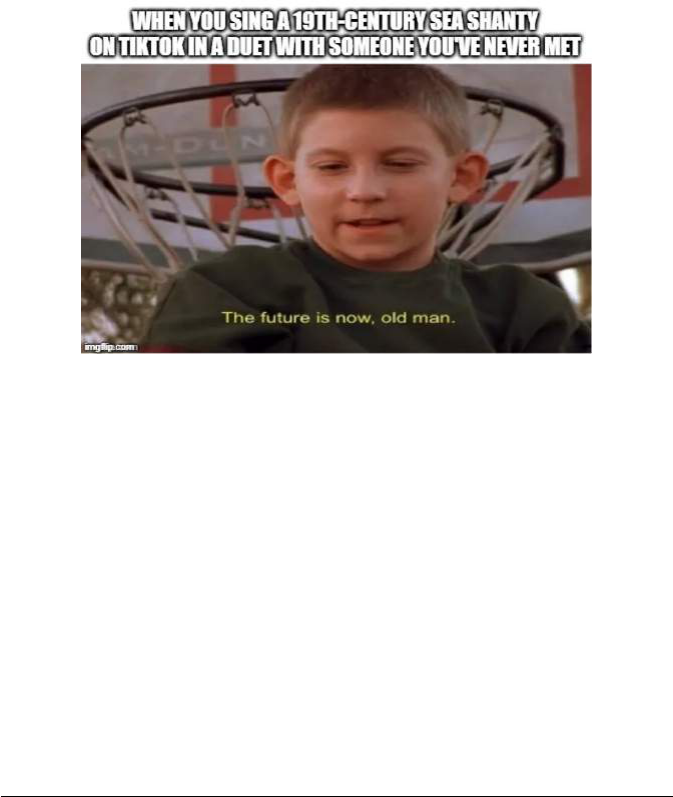
44159-nyu_97-2 Sheet No. 51 Side B 05/17/2022 12:35:30
44159-nyu_97-2 Sheet No. 51 Side B 05/17/2022 12:35:30
\\jciprod01\productn\N\NYU\97-2\NYU201.txt unknown Seq: 98 16-MAY-22 16:37
550 NEW YORK UNIVERSITY LAW REVIEW [Vol. 97:453
work.
474
In its analysis, the 5Pointz court described another street art
site that resulted from a “creative feud between Banksy and rival
artist King Robbo, which involved repeated modification and
overpainting of each other’s work.”
475
B. Memes as a Paradigm of a New Model of Creativity
476
Despite the shared ways memes and traditional works push
against basic copyright law concepts, we also think that memes herald
a larger shift that is underway in contemporary creativity.
477
As such,
the problems that memes present are of increasing and widespread
significance to contemporary creators. New forms of creativity are
emerging that share most of the characteristics of memes that we
established above as having upended copyright’s assumptions—partic-
ularly the norms favoring copying and transformation of works, crea-
tion of value for underlying works through copying, indirect
monetization of works, breakdown of distinction between idea and
expression, widespread and accelerated pace of copying, and decen-
tralization of the author.
478
Here we highlight three particularly
salient qualities that these new forms of creativity share with memes:
visuality, copying technology, and participatory authorship. We then
474
See Adler, Against Moral Rights, supra note 323, at 287 (describing street art as a
dialogue of authorship among different authors in which “destruction and creation
merge”).
475
Castillo, 950 F.3d at 168 n.5. The court held that temporary artwork that is
overpainted may nonetheless achieve recognized stature for purposes of moral rights
protections.
476
The Future Is Now, Old Man, K
NOW
Y
OUR
M
EME
, https://knowyourmeme.com/
memes/the-future-is-now-old-man [https://perma.cc/EZA7-X55K].
477
See supra Part III.
478
See supra Part III.

44159-nyu_97-2 Sheet No. 52 Side A 05/17/2022 12:35:30
44159-nyu_97-2 Sheet No. 52 Side A 05/17/2022 12:35:30
\\jciprod01\productn\N\NYU\97-2\NYU201.txt unknown Seq: 99 16-MAY-22 16:37
May 2022] MEMES ON MEMES AND THE NEW CREATIVITY 551
use these characteristics to sketch the contours of a major and
emerging shift in contemporary creativity.
First, memes exemplify a broader cultural shift in which images
have surpassed words as the primary mode of communication.
479
This
shift toward the visual, fueled by the pervasive use of smartphone
cameras, is evident in the online dominance of primarily visual social
media platforms, such as Instagram, Pinterest, Snapchat, TikTok, and
YouTube. Even social media platforms like Twitter and Facebook,
which did not begin as chiefly visual, have evolved to give greater
prominence to visual content.
480
Digital marketers, well aware of this
shift, emphasize visual content to exploit the power and speed of
visual images.
481
While legal scholars track the explosion of content in
the attention economy and the emergence of “cheap speech,”
482
they
have not considered the qualitative shift toward images and away
from words as the primary mode of communication and creativity in
our culture, or the implications for First Amendment law of reframing
“speech” as increasingly image-based rather than text-based.
483
Second, consider that copying, the foundation of meme cul-
ture,
484
has come to play a new and increasingly central role in con-
temporary creativity across the board. Of course, as we have
previously argued, copying has always been a significant building
block of creativity.
485
But now in digital culture, the role of copying in
479
See supra Sections II.A–B.
480
See Gerald C. Kane & Alexandra Pear, The Rise of Visual Content Online, MIT
S
LOAN
M
GMT
. R
EV
. (Jan. 4, 2016), https://sloanreview.mit.edu/article/the-rise-of-visual-
content-online [https://perma.cc/5KYPST2U].
481
E.g., Linette Fonseca, Visual Content vs Text: Visual Content Is Worth a Thousand
Words, M
ARKITORS
(Aug. 23, 2018), https://markitors.com/visual-content-vs-text-
communication [https://perma.cc/X4H2-BKX4]; Kai Tomboc, Text vs. Images: Which
Content Format Is Effective?, E
ASEL
.
LY
(May 30, 2019), https://www.easel.ly/blog/text-vs-
images-which-content-format-effective [https://perma.cc/9Z76-BXB3] (citing Anne
Trafton, In the Blink of an Eye, MIT N
EWS
(Jan. 16, 2014), https://news.mit.edu/2014/in-
the-blink-of-an-eye-0116 [https://perma.cc/55WQ-2QNL] (describing an MIT study finding
that the brain can identify images seen for as little as thirteen milliseconds)).
482
See generally Eugene Volokh, Cheap Speech and What It Will Do, 104 Y
ALE
L.J.
1805, 1807 (1995). For a few examples of the burgeoning literature around the topic of
cheap speech, see, for example, Alan K. Chen, Cheap Speech Creation, 54 U.C. D
AVIS
L.
R
EV
. 2405, 2454 (2021); Richard L. Hasen, Cheap Speech and What It Has Done (to
American Democracy), 16 F
IRST
A
MENDMENT
L. R
EV
. 200 (2018); Toni M. Massaro &
Helen Norton, Free Speech and Democracy: A Primer for Twenty-First Century Reformers,
54 U.C. D
AVIS
L. R
EV
. 1631 (2021). See also supra Section II.B.4 (discussing attention
scarcity and cheap speech).
483
See Adler, First Amendment, supra note 121, at 42 (arguing that the First
Amendment assumes an implicit hierarchy favoring text over image).
484
See supra Sections II.A, III.A.
485
See Adler & Fromer, supra note 47, at 1529; see also supra Section V.A and sources
cited therein.

44159-nyu_97-2 Sheet No. 52 Side B 05/17/2022 12:35:30
44159-nyu_97-2 Sheet No. 52 Side B 05/17/2022 12:35:30
\\jciprod01\productn\N\NYU\97-2\NYU201.txt unknown Seq: 100 16-MAY-22 16:37
552 NEW YORK UNIVERSITY LAW REVIEW [Vol. 97:453
creativity has taken on a new urgency.
486
As one of us has previously
explored, this newfound centrality of copying stems from two inter-
locking reasons: In a culture of endless repetition, copying has now
become the subject of work as well as a basic tool of how people
create.
487
As such, it is not just in memes, but throughout digital cul-
ture, that we see authors choosing to create by rummaging through
the shards of existing works rather than beginning with a blank
slate.
488
Memes in this sense are just the tip of the iceberg.
We are now overwhelmed by images and information.
489
In that
regard, it is no wonder that many creative endeavors now rely on
existing work as a pool for creativity. This development is abundantly
clear in visual art. As one of us has previously argued:
Technology has unleashed both a torrent of images and the capacity
to copy them with a click . . . . We used to think of an artist as
someone who sat in nature or in his garret, working alone to create
something new from whole cloth. . . . [Yet in] a world with a surfeit
of images, perhaps the greatest artist is not the one who makes an
image but the one who knows which image to take: to sort through
the endless sea of images in which we are now drowning and choose
the one that will float.
490
In his 2013 book After Art, critic David Joselit explains that “contem-
porary art marginalizes the production of content in favor of pro-
ducing new formats for existing images.”
491
Moreover, artists have
always tried to depict our world, and our world now looks like Google
Images.
492
The digital screen and its endless play of disconnected
images is our new daily landscape, as Giverny once was for Monet.
Furthermore, in the digital era, copying has become a funda-
mental tool of how people create.
493
Let’s return to hip hop.
494
Mark
Ronson, who explores the history of sampling, describes the pivotal
role copying technology played in the birth of this art form, explaining
486
See Adler, Fair Use, supra note 46, at 568.
487
See id.
488
See id. at 572.
489
See id.
490
Adler, Fair Use, supra note 46, at 571–72.
491
D
AVID
J
OSELIT
, A
FTER
A
RT
58 (2013); see also Adler, Fair Use, supra note 46, at
571.
492
See L
AURA
H
OPTMAN
, T
HE
F
OREVER
N
OW
: C
ONTEMPORARY
P
AINTING IN AN
A
TEMPORAL
W
ORLD
14 (2014) (“Artists have always looked to art history for inspiration,
but the immediate and hugely expanded catalogue of visual information offered by the
Internet has radically altered visual artists’ relationship to the history of art.”); cf. J
OSELIT
,
supra note 491, at 58 (drawing parallels between the historic role of art and architecture
and the current role of Google’s algorithm in “reformat[ting] existing streams of images
and information”).
493
See Adler, Fair Use, supra note 46, at 568.
494
See supra Part IV.A.

44159-nyu_97-2 Sheet No. 53 Side A 05/17/2022 12:35:30
44159-nyu_97-2 Sheet No. 53 Side A 05/17/2022 12:35:30
\\jciprod01\productn\N\NYU\97-2\NYU201.txt unknown Seq: 101 16-MAY-22 16:37
May 2022] MEMES ON MEMES AND THE NEW CREATIVITY 553
that “all of a sudden [artists] found themselves in possession of the
technology” to create music from past recordings.
495
Ronson
expounds on this, saying:
[T]hat’s what the past 30 years of music has been. That’s the major
thread. See, 30 years ago, you had the first digital samplers, and
they changed everything overnight. All of a sudden, artists could
sample from anything and everything that came before them, from a
snare drum from the Funky Meters, to a Ron Carter bassline, the
theme to “The Price Is Right.”
496
In short, technology unleashed a new means for creativity. It is
now a basic tool, as musical instruments are to music or as paint-
brushes are to art.
497
And it has leveled the playing field for crea-
tivity.
498
Meme culture is a prime example of a genre in which
technology makes it so easy to create. If you don’t believe us, go to an
online meme generator like imgflip and try making your own.
499
A third hallmark of contemporary creativity is its reliance on dif-
fuse, participatory authorship. In an older model of creativity, we pic-
tured an identifiable author who unleashed a discrete and final work.
But in the new meme-like participatory model of creativity, existing
works are always in flux, subject to reuse and transformation by
others. Rather than a finished product, the work is now a template
that multiple authors use, copy, and transform in an ongoing conver-
sation that produces new and collective works in dialogue with one
another.
With these insights on visuality, copying technology, the par-
ticipatory creativity of works, and the additional characteristics pos-
sessed by memes that upend copyright’s assumptions, we now turn to
a range of examples of this new model of meme-like creativity.
One category of creative works that shares several meme attrib-
utes is dance as created, copied, and shared on the TikTok platform.
Examples range from the fast-paced Renegade dance (created by an
Atlanta teenager, set to K Camp’s song “Lottery” and copied and
transformed over 29.7 million times) to the Number One Baby dance
495
Ronson, supra note 463, at 06:00.
496
Id. at 05:15.
497
Cf. Arthur Danto, The Artworld, 61 J. P
HIL
. 571, 581 (1964) (calling the readymade
“a contribution to artists’ materials, as oil paint was”).
498
For example, see the proliferation of music software now available for free. See, e.g.,
Daryl Baxter, The Best Free Music-Making Software 2022, T
ECH
R
ADAR
(Dec. 13, 2021),
https://www.techradar.com/best/free-music-making-software [https://perma.cc/VDE6-
B2JP] (discussing free music software competing with expensive professional alternatives).
499
Meme Generator,
IMGFLIP
, https://imgflip.com/memegenerator [https://perma.cc/
JK53-ACES]; see also Nield, supra note 150 (discussing various platforms used to create
memes).

44159-nyu_97-2 Sheet No. 53 Side B 05/17/2022 12:35:30
44159-nyu_97-2 Sheet No. 53 Side B 05/17/2022 12:35:30
\\jciprod01\productn\N\NYU\97-2\NYU201.txt unknown Seq: 102 16-MAY-22 16:37
554 NEW YORK UNIVERSITY LAW REVIEW [Vol. 97:453
(set to a hip hop song by Young Thug and Future and copied over 27
million times) to the Cannibal dance (set to a ten-year old pop song by
Kesha and copied over 9 million times).
500
Some popular dances
(often called “dance challenges,”
501
a term that itself provokes
memetic spreading on TikTok) are based on children’s songs, K-pop,
and even Vietnamese music about the countryside.
502
Choreographers
analyze how TikTok has created a new dance genre because the
moves—given the video frame—tend to focus on the body above the
legs (often featuring finger guns, hip wiggles, chest bangs, and dice
rolls), are fairly energetic, and must be easy to learn if they want a
chance at viral success.
503
As one dancer explains, despite sometimes
appearing like a homogeneous style, these dances in fact “have roots
in hip-hop but also pull from so many other styles like belly dancing,
dancehall dance moves, [and] jazz funk.”
504
That is, these dance
videos are frequently in dialogue with one another. Moreover, as one
analyst explains, “TikTok dances are often recorded by creators alone,
with the only social aspect being the imagin[ed] connection between
the dancer and their future phone-scrolling viewers.”
505
As these
dance videos are copied and transformed, often at a brisk pace, they
also frequently are stripped of their context and creator, making attri-
500
See Andria Moore & Palmer Haasch, 20 of the Most Viral Dances on TikTok, from
‘Corvette Corvette’ to the ‘Renegade,’ I
NSIDER
(Feb. 5, 2021), https://www.insider.com/
tiktok-dances-renegade-say-so-and-more-19-top-2020-3 [https://perma.cc/LFY4CVU5].
These numbers can spill over into the real world, increasing rates of song streaming and
downloads, see infra notes 552–57 and accompanying text, to the extent that some artists
and record companies pay popular TikTok personalities to dance to their music. See
Amelia Tait, Meet the Choreographers Behind Some of TikTok’s Most Viral Dances,
W
IRED
UK (Aug. 18, 2020), https://www.wired.co.uk/article/tik-tok-dances [https://
perma.cc/BKJ5-9RY6]; accord Christopher Buccafusco & Kristelia Garc´ıa, Pay-to-Playlist:
The Commerce of Music Streaming, 12 U.C. I
RVINE
L. R
EV
. (forthcoming 2022).
501
Moore & Haasch, supra note 500.
502
Id.; Cat Zhang, The Latest TikTok Trend Is . . . Vietnamese Music About the
Countryside?, P
ITCHFORK
(Aug. 5, 2021), https://pitchfork.com/thepitch/the-latest-tiktok-
trend-is-vietnamese-music-about-the-countryside [https://perma.cc/C8BQ-3F9C].
503
See Charlotte Barnett, How the Obsession with TikTok Dances Spilled out of the
App and into the World, O
BSERVER
(Jan. 29, 2020), https://observer.com/2020/01/tiktok-
dance-moves-choreography-history [https://perma.cc/8FAW-CQXB] (discussing TikTok
dance choreography that focuses on the upper body and simplistic, easy-to-learn
movements); Siobhan Burke, What Makes a TikTok Dance Go Viral?, D
ANCE
M
AG
. (Dec.
27, 2020), https://www.dancemagazine.com/popular-tiktok-dances-2649519038.html
[https://perma.cc/HTV6-Q7ST] (noting that simplistic dances and exaggerated facial
expressions contribute to a TikTok dance’s popularity); Koh Ewe, Yes, TikTok Dances All
Look the Same. Here’s Why., V
ICE
(Apr. 14, 2021), https://www.vice.com/en/article/
4avgmm/why-tiktok-dances-look-same [https://perma.cc/3ERJ-H5GF] (observing the
simplicity, energy, and personality common to trendy TikTok dances).
504
Ewe, supra note 503 (quoting dancer Rhiam Bichri).
505
Id. (quoting dance instructor Nika Kermani).

44159-nyu_97-2 Sheet No. 54 Side A 05/17/2022 12:35:30
44159-nyu_97-2 Sheet No. 54 Side A 05/17/2022 12:35:30
\\jciprod01\productn\N\NYU\97-2\NYU201.txt unknown Seq: 103 16-MAY-22 16:37
May 2022] MEMES ON MEMES AND THE NEW CREATIVITY 555
bution harder than in traditional spaces.
506
Even so, popular
TikTokers can make substantial money not directly from their creative
content but from being paid to post sponsored content.
507
As another illustration of the range of meme-like creativity cur-
rently flourishing, consider the Broadway-like musicals being created
online in a fashion that is collaborative, iterative, and viral.
508
Perhaps
the most successful has been Ratatouille the Musical, based on the
2007 Disney-Pixar animated film Ratatouille about Remy, a Parisian
rat who dreams of becoming a chef. The crowdsourced musical ver-
sion began on TikTok with Le Festin, a song from the Ratatouille
movie soundtrack, frequently used as background in users’ cooking
videos.
509
A parody version of the song—featuring nonsensical
506
See Tait, supra note 500 (noting that the format of TikTok makes it often hard to
trace the original creator of a viral dance). This has led to controversy, as dances of Black
creators are often copied and popularized by white TikTok figures and credit is lost along
the way. See J. Clara Chan, Black TikTok Creators Grapple with How Far to Take Strike:
“Why Should We Have to Leave?,” H
OLLYWOOD
R
EP
. (July 28, 2021), https://
www.hollywoodreporter.com/business/digital/tiktok-strike-1234988427 [https://perma.cc/
HDT3-5NQJ]; Tait, supra note 500; Hannah Yasharoff, Jimmy Fallon Addresses His
TikTok Dance Segment with Addison Rae. Here’s Why It Sparked Backlash, USA T
ODAY
(Mar. 30, 2021), https://www.usatoday.com/story/entertainment/tv/2021/03/30/tiktok-
dances-why-addison-rae-jimmy-fallon-clip-sparked-backlash/7058920002 [https://perma.cc/
PK8D-CUUA]. In response, a movement to register copyright in the choreography is
underway. Paige Skinner, The TikToker Who Created the Viral “Savage” Dance Is
Copyrighting the Moves, B
UZZFEED
N
EWS
(Aug. 2, 2021), https://www.buzzfeednews.com/
article/paigeskinner/savage-dance-copyrighted [https://perma.cc/BL7T-578Y]. Whether
these actions are merely a way to claim official credit or a desire to formally enforce
exclusive rights is unclear.
507
Tait, supra note 500. One difference between memes, which proliferate without
underlying payment to or permission from their creators, and TikTok content is that
TikTok pays licensing fees for the songs underlying users’ dance videos. Amy Johnson,
TikTok Music & Royalties: How Does It Work?, A
UDIOSOCKET
, https://
www.audiosocket.com/social-media-guides/tiktok-music-royalties-how-does-it-work
[https://perma.cc/SX9U-P3MF]. Not all social media platforms pay for licenses. That
TikTok finds it worthwhile to do so provides another model of how meme culture could
work. This model also suggests the need for further analysis, especially because TikTok
might be paying for licenses to avoid copyright claims—even ones that should fail—to
keep the platform successful. It is possible that the new creativity could be inhibited were
TikTok to stop its licensing practice.
508
See Laura Wheatman Hill, What’s The Deal With All These TikTok Musicals?,
B
ETCHES
(Feb. 1, 2021), https://betches.com/whats-the-deal-with-all-these-tiktok-musicals
[https://perma.cc/S4A6-T3B6] (identifying TikTok musicals, such as Grocery Store: The
Musical and Ratatouille the TikTok musical, and asking whether this phenomenon is “the
future of content creation”); see, e.g., Jeff Lunden, Now Playing on TikTok: ‘Bridgerton’
The Musical, A
LL
T
HINGS
C
ONSIDERED
(Feb. 13, 2021, 5:08 PM), https://www.npr.org/
2021/02/13/967175912/now-playing-on-tiktok-bridgerton-the-musical [https://perma.cc/
GPG9-ZW2A] (explaining how two singer-songwriters wrote and posted songs about the
Netflix show Bridgerton that went viral on TikTok).
509
Rebecca Alter, Broadway Is Closed, but Ratatouille the Musical Is Cooking on
TikTok, V
ULTURE
(Nov. 19, 2020), https://www.vulture.com/2020/11/ratatouille-musical-
tiktok.html [https://perma.cc/EMC5-7GXZ].

44159-nyu_97-2 Sheet No. 54 Side B 05/17/2022 12:35:30
44159-nyu_97-2 Sheet No. 54 Side B 05/17/2022 12:35:30
\\jciprod01\productn\N\NYU\97-2\NYU201.txt unknown Seq: 104 16-MAY-22 16:37
556 NEW YORK UNIVERSITY LAW REVIEW [Vol. 97:453
French-sounding lyrics set to Le Festin’s tune—followed and was
debuted as background music to a TikTok video that depicted what
one news story described as “self-consciously gross or bad cooking, or
really any sort of weird lifestyle-hack fails.”
510
Subsequently (and fol-
lowing up on her homages to other cartoon characters, including Jar
Jar Binks and Winnie the Pooh), TikTok user Em Jaccs shared an ode
to Remy that she had written and performed, in which she had modi-
fied her voice to sound like a mouse.
511
TikTok user Daniel Mertzlufft
then adapted the song into an all-out Broadway number with arrange-
ment and orchestration.
512
This song was viewed over one million
times and used in thousands of others’ TikTok videos, including videos
that made a set design for this “musical,” created choreography, made
a musical playbill, designed makeup for the characters, and performed
a cast party.
513
Others built further on the song, some using TikTok’s
duet feature to voice lyrics they wrote for other characters in the
movie to sing along with Remy.
514
TikTok users then added new songs
corresponding to scenes throughout the movie, often with numerous
songs per scene, in many styles including a Lin-Manuel Miranda
parody song.
515
Other TikTok users created songs that went beyond
510
Id.; see, e.g., JoKo entertainment, CEO of Speaking French ( Ratatouille ) TikTok
TREND COMPILATON — FAILS, Y
OU
T
UBE
(May 17, 2020), https://www.youtube.com/
watch?v=3WlC2ybFjkY [https://perma.cc/V32S-KARE] (YouTube compilation of these
TikTok videos).
511
Alter, supra note 509; Emily Jacobsen (@e_jaccs), T
IK
T
OK
(Aug. 8, 2020), https://
www.tiktok.com/foryou?referer_url=https%3A%2F%2Fcdn.embedly.com%2F&
referer_video_id=6859521038418447622&refer=embed&is_copy_url=1&is_from_webapp=
v1&item_id=6859521038418447622#/@e_jaccs/video/6859521038418447622 [https://
perma.cc/U89K-W6JM].
512
Alter, supra note 509; Daniel Mertzlufft (@danieljmertzlufft), T
IK
T
OK
(Oct. 19,
2020), https://www.tiktok.com/@danieljmertzlufft/video/688547519341062067
8?refer=embed [https://perma.cc/Y96G-F9DK].
513
Alter, supra note 509; see, e.g., Shoebox Musicals (@shoeboxmusicals), T
IK
T
OK
(Oct.
21, 2020), https://www.tiktok.com/@shoeboxmusicals/video/6886267112373947653?
refer=embed [https://perma.cc/GP5D-XZR5] (set design); Nic (@still_nic), T
IK
T
OK
(Nov.
15, 2020), https://www.tiktok.com/@still_nic/video/6895476547000585477?refer=embed
[https://perma.cc/HY5X-8J45] (cast party); Tristan McIntyre (@tristanmichaelmcintyre),
T
IK
T
OK
(Nov. 13, 2020), https://www.tiktok.com/@tristanmichaelmcintyre/video/
6894839741158608134?refer=embed [https://perma.cc/6K2T-SELW] (choreography); Jess
Siswick (@siswij), T
IK
T
OK
(Nov. 14, 2020), https://www.tiktok.com/@siswij/video/
6894854586293669126?refer=embed [https://perma.cc/L96A-9994] (playbill); Morgaine
(@morgainemade), T
IK
T
OK
(Nov. 16, 2020), https://www.tiktok.com/@morgainemade/
video/6895753331688426753?lang=EN [https://perma.cc/S3JG-T7VJ] (makeup).
514
Alter, supra note 509; Acacia (@acaciapressley), T
IK
T
OK
(Oct. 29, 2020), https://
www.tiktok.com/@acaciapressley/video/6889238341120789766?refer=embed [https://
perma.cc/Z2CP-W5WT].
515
Alter, supra note 509; Emily Maskell, A Complete Guide to the ‘Ratatouille’ TikTok
Musical, P
APER
(Nov. 26, 2020), https://www.papermag.com/a-complete-guide-to-the-
ratatouille-tiktok-musical-2649046202.html [https://perma.cc/35P5-5KHX] (publishing an
act-by-act guide to the musical’s songs); see, e.g., Rocky Paterra (@rockysroad), T
IK
T
OK

44159-nyu_97-2 Sheet No. 55 Side A 05/17/2022 12:35:30
44159-nyu_97-2 Sheet No. 55 Side A 05/17/2022 12:35:30
\\jciprod01\productn\N\NYU\97-2\NYU201.txt unknown Seq: 105 16-MAY-22 16:37
May 2022] MEMES ON MEMES AND THE NEW CREATIVITY 557
the film, such as a song adopting the view of Remy’s mother, a char-
acter that does not appear in the movie.
516
Then Broadway actors
began performing these songs online.
517
Eventually, this led to a vir-
tual performance of a musical culled from the TikTok songs and other
videos by Broadway performers such as Tituss Burgess, Wayne Brady,
and Adam Lambert, which raised over $2 million for charity
518
and
was reviewed in traditional media outlets like the Chicago Tribune.
519
Not only did Disney not use copyright to challenge these works, but it
supported the charity performance.
520
In these new forms of online creativity, users also have revived
and transformed centuries-old forms of work. At the end of 2020,
Scottish postman Nathan Evans posted on TikTok his rendition of
Wellerman, a nineteenth-century sea shanty sung by merchant seamen
as they worked to distract themselves from labor.
521
Sea shanties are
folk songs that typically have lyrics about whaling, winds, and
harpoons.
522
In a few weeks, Evans’s video was viewed over nine mil-
lion times and provoked an outpouring of creativity: TikTok duets
using his and others’ performances of sea shanties, remixes of these
sea shanties, newly composed sea shanties, reactions to the revival of
such an old form of music, memes about sea shanties, Kermit the Frog
(Oct. 28, 2020), https://www.tiktok.com/@rockysroad/video/6888784128276286725?
refer=embed [https://perma.cc/G2VZ-YUQE] (Lin-Manuel Miranda parody).
516
Maskell, supra note 515.
517
See Alter, supra note 509 (noting a TikTok performance by Andrew Barth Feldman,
who performed a personalized song made by TikTok user Nathan Fosbinder); Nathan
Fosbinder (@fozzyforman108), T
IK
T
OK
(Nov. 10, 2020), https://www.tiktok.com/
@fozzyforman108/video/6893577050712476934?refer=embed [https://perma.cc/R28D-
ARXP] (TikTok video of Feldman performing the song).
518
Ratatoutille: The TikTok Musical, https://ratatousical.com [https://perma.cc/4QE4-
GKUM]; see also TikTok’s Ratatouille: The Musical Makes It to Broadway and Streams on
TikTok, T
IK
T
OK
(Jan. 8, 2021), https://newsroom.tiktok.com/en-us/tiktok-ratatouille-the-
musical-makes-it-to-broadway-and-streams-on-tiktok [https://perma.cc/6DA2-3MEH].
519
E.g., Michael Phillips, Even with One Composer Missing, Here’s Why ‘Ratatouille:
The TikTok Musical’ Points Straight to Broadway, C
HI
. T
RIB
. (Jan. 2, 2021), https://
www.chicagotribune.com/entertainment/movies/michael-phillips/ct-mov-ratatouille-tiktok-
0104-20210102-4rkqjwllffewbln6ocpyrow4ki-story.html [https://perma.cc/B2ET-7A8A].
520
Greg Evans, ‘Ratatouille: The TikTok Musical’: How Broadway Cooked up the
Perfect Appetizer for a New Year That Can’t Start Soon Enough, D
EADLINE
(Jan. 1, 2021),
https://deadline.com/2021/01/ratatouille-tiktok-musical-benefit-disney-seaview-emily-
jacobsen-tituss-burgess-actors-fund-1234663746 [https://perma.cc/WDE8-5HJK].
521
Sea Shanty TikTok—@nathanevanss, T
IK
T
OK
(Jan. 25, 2021), https://
newsroom.tiktok.com/en-gb/sea-shanty-tiktok-nathanevanss [https://perma.cc/YS9C-
TFXE]; see also Rebecca Renner, Everyone’s Singing Sea Shanties (or Are They Whaling
Songs?), N.Y. T
IMES
(Jan. 13, 2021), https://www.nytimes.com/2021/01/13/style/sea-shanty-
tiktok-wellerman.html [https://perma.cc/845L-7VAB].
522
See Kathryn VanArendonk, Um, It Makes Total Sense We’re All into Sea Shanties
Now, V
ULTURE
(Jan. 12, 2021), https://www.vulture.com/2021/01/tiktok-sea-shanties-
explained.html [https://perma.cc/UY2N-WB7H].

44159-nyu_97-2 Sheet No. 55 Side B 05/17/2022 12:35:30
44159-nyu_97-2 Sheet No. 55 Side B 05/17/2022 12:35:30
\\jciprod01\productn\N\NYU\97-2\NYU201.txt unknown Seq: 106 16-MAY-22 16:37
558 NEW YORK UNIVERSITY LAW REVIEW [Vol. 97:453
performing a sea shanty, and even an electronic dance music version
of this new shanty genre.
523
Famous musicians got involved, with Sir
Andrew Lloyd Webber layering his piano playing atop, and boy bands
harmonizing with, Evans’s performance.
524
Like TikTok dances, these songs are suited to the platform. As
one news report explains, “[t]hey’re songs with simple, blunt rhythms,
meant to be easy to learn and easy to sing along with . . . . [T]he
engine of the song is in the repeating chorus that everyone sings
together . . . . They are unifying, survivalist songs, designed to trans-
form a huge group of people into one collective body.”
525
Another
analysis elaborated, “[o]n a technical level, shanties seem perfectly
primed for TikTok. They’re a call-and-response genre on a call-and-
response app. . . . And, like memes, the shanty is an art form that
seemingly belongs to no one, comes from nowhere, exists to be repli-
cated.”
526
TikTok participants commented how much they felt it
brought them together during a pandemic and gave a sense of adven-
ture, as if they were on a collective seafaring voyage rather than stuck
at home alone.
527
Evans, himself, got so much positive attention from
launching this trend that he was signed to the Polydor record label and
quit his job as a postman.
528
523
E.g., Jason Heffler, Here’s an EDM Remix of the Viral “Wellerman” TikTok Sea
Shanty—and It’s Actually a Banger, EDM (Jan. 15, 2021), https://edm.com/music-releases/
viral-wellerman-tiktok-sea-shanty-electronic-dance-music-remix [https://perma.cc/CN24-
MKYD]; @artmonkeyworld, T
IK
T
OK
(Jan. 11, 2021), https://www.tiktok.com/
@artmonkeyworld/video/6916564331928866054?lang=EN [https://perma.cc/A67Q-N5FY]
(Kermit sea shanty); Argules, ARGULES – Wellerman (sea shanty) TikTok BUMP
HOUSE Remix, Y
OU
T
UBE
(Jan. 7, 2021), https://www.youtube.com/watch?v=
ZDTaeqUEWNQ [https://perma.cc/5TMX-5VVW] (sea shanty remix); see also Renner,
supra note 521 (contextualizing the TikTok sea shanty phenomenon within history and
modern-day life); VanArendonk, supra note 522.
524
Shanty TikTok—@nathanevanss, supra note 521; Andrew Lloyd Webber
(@officialalw), T
IK
T
OK
(Jan. 18, 2021), https://www.tiktok.com/@officialalw/video/6919061
058825063682?referer_url=https%3A%2F%2Fnewsroom.tiktok.com%2Fen-gb%2Fsea-
shanty-tiktok-nathanevanss&referer_video_id=6919061058825063682&refer=embed
[https://perma.cc/WCD3-EKLL] (Sir Andrew Lloyd Webber TikTok); Gary Barlow
(@officialgarybarlow), T
IK
T
OK
(Jan. 18, 2021), https://www.tiktok.com/@
officialgarybarlow/video/6919146558533422338?referer_url=https%3A%2F%
2Fnewsroom.tiktok.com%2Fen-gb%2Fsea-shanty-tiktok-nathanevanss&referer_video_id=
6919146558533422338&refer=embed [https://perma.cc/3XUD-4G7V] (boy band TikTok).
525
VanArendonk, supra note 522.
526
Kyle Piscioniere, Sea Shanty TikTok Is on Fire, S
LATE
(Jan. 23, 2021), https://
slate.com/culture/2021/01/sea-shanty-tiktok-wellerman-trend-explained.html [https://
perma.cc/2JAN-Z5Z5].
527
See Kerry Breen, Why Is TikTok Obsessed with Sea Shanties? An Investigation,
T
ODAY
(Jan. 14, 2021), https://www.today.com/tmrw/here-why-tiktok-obsessed-sea-
shanties-today-t205848 [https://perma.cc/D344-F2SU]; VanArendonk, supra note 522.
528
Adela Suliman, Kelly Cobiella & Kiko Itasaka, TikTok Star Behind ‘Wellerman’ Sea
Shanty Craze Quits Job as Mailman, NBC N
EWS
(Jan. 24, 2021), https://www.nbcnews.com/

44159-nyu_97-2 Sheet No. 56 Side A 05/17/2022 12:35:30
44159-nyu_97-2 Sheet No. 56 Side A 05/17/2022 12:35:30
\\jciprod01\productn\N\NYU\97-2\NYU201.txt unknown Seq: 107 16-MAY-22 16:37
May 2022] MEMES ON MEMES AND THE NEW CREATIVITY 559
While much of this creativity is taking place on TikTok—a cur-
rent dominant social media platform—it is all over just about every
form of social media. On Instagram, users participate in challenges in
which, according to one guide explanation, “someone on Instagram
sets a theme and asks people to share photos [or videos] on that
theme using a particular hashtag.”
529
Examples include #floralfriday
competition (a weekly challenge to share photos of flowers or gar-
dens), #INKtober (a challenge to draw and post an ink drawing each
of the thirty-one days of October), and #pillowchallenge (a challenge
where, as explained by one news article, “participants fashion dresses
out of their bedding by belting a pillow at the waist”).
530
Pinterest has
users curating and sharing theme boards of everything from their
favorite pink dresses to interior design to architecture details and
wedding photos.
531
Tumblr and Medium provide ways for users to
create blogs or stories filled with text, audio, photos, videos, and more
and for others to follow, copy, and engage with those who share their
interests.
532
Twitch has users streaming aspects of their lives, including
video game play, to others watching and interacting in real time.
533
DeviantArt is a social network set up to share user artwork.
534
Wattpad is a platform where users can publish their writing to be read
by its ninety million readers and can create social communities around
stories; it also provides a spot for fan fiction and is a launchpad for
news/world/tiktok-star-behind-wellerman-sea-shanty-craze-quits-job-mailman-n1255426
[https://perma.cc/W5MX-K2K9]. Other musicians, including Justin Bieber, Shawn Mendes,
and The Weeknd, launched their professional careers by sharing their music performances
online. Morgan Greenwald, 5 Artists Who Got Their Start on YouTube, I
N
T
HE
K
NOW
,
https://www.intheknow.com/post/5-artists-who-got-their-start-on-youtube [https://
perma.cc/5JM2-Z7GH].
529
Camilla Westergaard, The Best Instagram Challenges for Makers & Why You Should
Be Taking Part, F
OLKSY
, https://blog.folksy.com/2017/06/07/best-instagram-challenges
[https://perma.cc/WM4U-7FL7].
530
Alexandra Pauly, What Exactly Is the Pillow Challenge Taking Over Instagram?,
H
YPEBAE
(Apr. 16, 2020), https://hypebae.com/2020/4/pillow-challenge-instagram-social-
media-trend-quarantine-home-fashion-pillowcase-explained [https://perma.cc/GFD8-
BXP6]; Westergaard, supra note 529.
531
E.g., Top 11 Pinterest Boards, N
EOREACH
(June 14, 2019), https://neoreach.com/top-
pinterest-boards [https://perma.cc/LH79-39RT]; Pink Dresses, P
INTEREST
, https://
www.pinterest.com/dressforwedding/pink-dresses [https://perma.cc/VU2X-2XS7]; see also
Amanda Fortini, How Pinterest Became a Booming Factory for Creativity, W
IRED
(July 22,
2014), https://www.wired.com/2014/07/pinterest-creativity [https://perma.cc/K7BG-FCED]
(describing Pinterest, which allows users to curate their user experience to support their
creative hobbies).
532
See M
EDIUM
, https://medium.com [https://perma.cc/6VJM-TTPE] (“Medium is a
place to write, read, and connect.”); T
UMBLR
, https://www.tumblr.com [https://perma.cc/
63ZR-44LB] (“Make stuff, look at stuff, talk about stuff, find your people.”).
533
See T
WITCH
, https://www.twitch.tv [https://perma.cc/DJD6-VARY].
534
D
EVIANT
A
RT
, https://www.deviantart.com [https://perma.cc/Z9Q2-SRRQ].

44159-nyu_97-2 Sheet No. 56 Side B 05/17/2022 12:35:30
44159-nyu_97-2 Sheet No. 56 Side B 05/17/2022 12:35:30
\\jciprod01\productn\N\NYU\97-2\NYU201.txt unknown Seq: 108 16-MAY-22 16:37
560 NEW YORK UNIVERSITY LAW REVIEW [Vol. 97:453
publication or movie adaptation.
535
Each of these social media plat-
forms has built-in mechanisms to copy and share others’ work and to
engage with it, underscoring the recognized value of copying and dia-
logue among works.
These examples demonstrate the pervasiveness of the new mode
of creativity—much as with memes—particularly among visual works,
which have become a dominant form of expression. Copying and
transformation of works is no longer condemned but celebrated. Cop-
ying happens easily with a click of a button or two. And it creates
value for the underlying works being copied. The subsequent creators
can profit, but usually only do so by indirect monetization. Reuse of
expression can turn what was once only expression into idea. Copying
proceeds at a frenetic scale and pace and can lead works to become
stale at previously unforeseen rates. These works, as they are passed
around, become decentered from their authors. And the works—by
building on, communicating with, and drawing from one another—are
interwoven into a grand conversation and communal cultural experi-
ence. As with memes, copyright law is a misfit for this new
creativity.
536
535
See W
ATTPAD
, https://www.wattpad.com [https://perma.cc/S32B-8327] (homepage of
Wattpad, describing itself as “[t]he world’s most-loved social storytelling platform”); see
also Julia Alexander, From Fanfiction to Netflix Hits, V
ERGE
, https://www.theverge.com/
2021/1/14/22215052/wattpad-authors-fanfiction-netflix-hulu-streaming-movies-romcom-
teen-drama [https://perma.cc/32UW-GZXE] (describing how Wattpad has been the
launchpad for movie adaptations).
536
See supra Part III.

44159-nyu_97-2 Sheet No. 57 Side A 05/17/2022 12:35:30
44159-nyu_97-2 Sheet No. 57 Side A 05/17/2022 12:35:30
\\jciprod01\productn\N\NYU\97-2\NYU201.txt unknown Seq: 109 16-MAY-22 16:37
May 2022] MEMES ON MEMES AND THE NEW CREATIVITY 561
C. Trying to Make Memes More Like Traditional Works
537
The extraordinary spread of meme-like creativity helps shed light
on another emerging cultural phenomenon. Consider the recent
market craze for NFTs that has captured public attention due to the
astonishingly high prices NFTs command.
538
As a New York magazine
article exploring the NFT hype defined it, an NFT is “a digital asset
whose uniqueness, and therefore its value, is stored cryptographically
on the digital ledger known as the blockchain.”
539
Though NFTs, as
unique digital identifiers, can be used to sell anything, they are com-
monly used to sell tokens for digital images or clips, even though these
images or clips are themselves freely available and copyable.
540
Here
we offer a novel interpretation: We see the craze for NFTs as a direct
reaction to meme culture and what it represents.
541
As we have argued, memes encapsulate a distinctly modern con-
dition of creativity in a world of unbounded copying. Memes prolif-
537
Spiderman Pointing at Spiderman Meme Generator,
IMGFLIP
, https://imgflip.com/
memegenerator/110133729/spiderman-pointing-at-spiderman [https://perma.cc/FLP7-
8U95].
538
See, e.g., Scott Reyburn, JPG File Sells for $69 Million, as ‘NFT Mania’ Gathers
Pace, N.Y. T
IMES
(Mar. 11, 2021), https://www.nytimes.com/2021/03/11/arts/design/nft-
auction-christies-beeple.html [https://perma.cc/4UF2-PHV4] (documenting the record-
breaking sale of an NFT of a digital work of art for $69 million, making it the third-highest
price for a work of art sold at auction for a living artist).
539
Max Read, There’s Nothing to Do Except Gamble, N.Y. M
AG
. I
NTELLIGENCER
(Apr.
12, 2021), https://nymag.com/intelligencer/2021/04/nft-future-of-money.html [https://
perma.cc/T926-B4S6].
540
Mitchell Clark, NFTs, Explained, V
ERGE
(Aug. 18, 2021), https://www.theverge.com/
22310188/nft-explainer-what-is-blockchain-crypto-art-faq [https://perma.cc/36HR-RAKR].
541
Cf. Joshua Fairfield, Tokenized: The Law of Non-Fungible Tokens and Unique
Digital Property, 97 I
ND
. L.J. (forthcoming) (manuscript at 1) (proposing a legal
framework to analyze NFTs); Kal Raustiala & Christopher Jon Sprigman, The One
Redeeming Quality of NFTs Might Not Even Exist, S
LATE
(Apr. 14, 2021), https://
slate.com/technology/2021/04/nfts-digital-art-authenticity-problem.html [https://perma.cc/
86EU-FAN4] (analyzing NFTs through the lens of status as “virtual Veblen goods”).

44159-nyu_97-2 Sheet No. 57 Side B 05/17/2022 12:35:30
44159-nyu_97-2 Sheet No. 57 Side B 05/17/2022 12:35:30
\\jciprod01\productn\N\NYU\97-2\NYU201.txt unknown Seq: 110 16-MAY-22 16:37
562 NEW YORK UNIVERSITY LAW REVIEW [Vol. 97:453
erate and mutate without limit and without anyone in control.
Everyone is an author; every image is up for grabs. There is no orig-
inal, no owner, no beginning, no end, and no moment of stasis. But in
contrast to the limitless copies of meme culture, the NFT now manu-
factures a “unique” original. Instead of the endless flux of memes, the
NFT artificially stops time. Unlike authorless and ownerless memes,
the NFT privatizes the image. Whereas memes are free and only indi-
rectly monetizable (if at all), the NFT creates a product to sell. No
wonder some of the most famous and recognizable meme creators or
subjects have cashed in. The subject of the famous Disaster Girl
meme
542
just sold an NFT of her meme for $500,000.
543
In short, we
see the market for NFTs as a reaction against the modern conditions
of endless copying that memes emblematize.
544
NFTs represent an
attempt to cling to the concepts of uniqueness, originality, and authen-
ticity in a world where those concepts no longer make sense.
545
Whereas philosopher Walter Benjamin once hoped that the tech-
nology of reproduction would destroy the aura of the unique work of
art, the NFT does the opposite: It manufactures ersatz uniqueness to
counteract a world of limitless reproduction.
546
Well before the advent of NFTs, Professor Barton Beebe
described how intellectual property law created artificial scarcity in
our post-rarity world.
547
Although he did not address meme culture,
Beebe discussed the proliferation of copying technology and the
responsive use of intellectual property law “to re-enchant copies, to
render them as somehow unique or authentic” in a culture of cop-
ying.
548
But unlike Beebe’s vision in which intellectual property law
plays a role in creating false rarity, what we see with NFTs is a false
rarity created and monetized strictly through the market, without any
operation of law. As is increasingly the case with digital culture, social
542
Disaster Girl, supra note 443.
543
Marie Fazio, The World Knows Her as ‘Disaster Girl.’ She Just Made $500,000 off the
Meme, N.Y. T
IMES
(May 1, 2021), https://www.nytimes.com/2021/04/29/arts/disaster-girl-
meme-nft.html [https://perma.cc/7Q55-MY4N].
544
Amy Adler, The Artifice of Authenticity (Jan. 24, 2022) (unpublished manuscript)
(on file with authors).
545
See Walter Benjamin, The Work of Art in the Age of Mechanical Reproduction
(“From a photographic negative, for example, one can make any number of prints; to ask
for the ‘authentic’ print makes no sense.”), in I
LLUMINATIONS
174 (Hannah Arendt ed.,
Harry Zohn trans., Schocken Books 1968) (1955); cf. Adler, The Artifice of Authenticity,
supra note 544 (discussing these concepts in regard to the art market).
546
Benjamin, supra note 545 (discussing the “aura” of authenticity present in certain
unique, original works and how that aura “withers” in response to mass-produced work
like film).
547
Barton Beebe, Intellectual Property Law and the Sumptuary Code, 123 H
ARV
. L.
R
EV
. 809, 817 (2010).
548
Id. at 844.
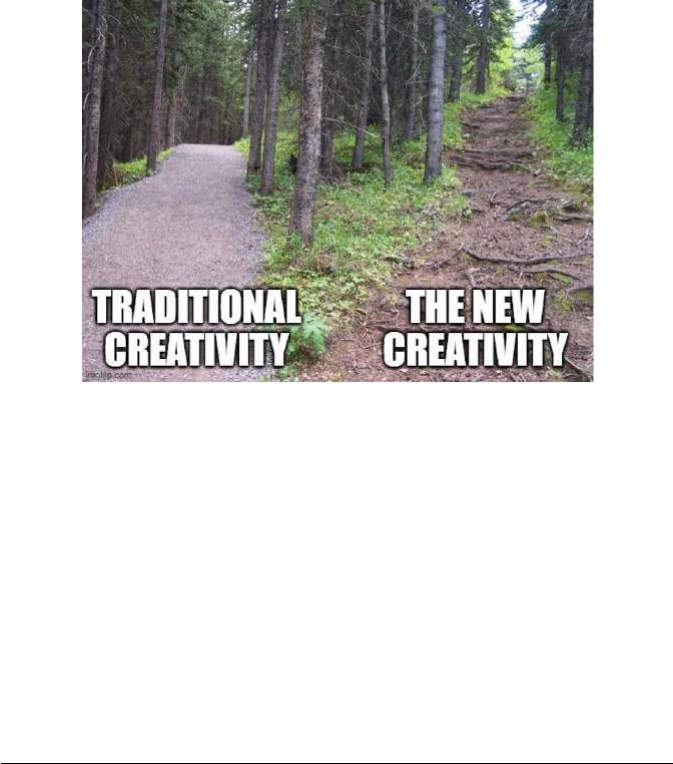
44159-nyu_97-2 Sheet No. 58 Side A 05/17/2022 12:35:30
44159-nyu_97-2 Sheet No. 58 Side A 05/17/2022 12:35:30
\\jciprod01\productn\N\NYU\97-2\NYU201.txt unknown Seq: 111 16-MAY-22 16:37
May 2022] MEMES ON MEMES AND THE NEW CREATIVITY 563
norms and the market itself have superseded the role previously
played by law, at least for the moment.
549
As we have seen, the misfit between memes and central tenets of
copyright law signals a much larger problem for copyright law and
theory. While traditional works already share certain features of
memes, ultimately memes encapsulate a widespread emergence of a
new mode of creativity in digital culture. Even contrary trends in dig-
ital culture, such as the NFT, demonstrate how pervasive meme cul-
ture has become.
C
ONCLUSION
550
This Article sets out how memes upend so many of copyright
law’s fundamental assumptions on creativity, commercialization, and
distribution: that creativity should typically happen without copying,
that copying is harmful, that creators directly profit from exercising
copyright’s exclusive rights, that idea and expression are distinct cate-
gories, that copyright duration ought to be long to correspond to the
longtime viability of works, that copyright holders should be able to
select an exclusive few to exploit their works, and that the author is
central. Copyright law is therefore a poor fit for this form of creativity,
exemplified by memes but now characterizing a vibrant range of crea-
tivity, particularly online.
549
See Adler & Fromer, supra note 47, at 1457 (noting the recent trend of those holding
copyrights to seek relief outside of traditional legal systems); see also supra Sections II.C,
IV.A.
550
Path Split in Forest Meme Generator,
IMGFLIP
, https://imgflip.com/memegenerator/
35673474/Path-split-in-forest [https://perma.cc/4Q9A-6NLT].

44159-nyu_97-2 Sheet No. 58 Side B 05/17/2022 12:35:30
44159-nyu_97-2 Sheet No. 58 Side B 05/17/2022 12:35:30
\\jciprod01\productn\N\NYU\97-2\NYU201.txt unknown Seq: 112 16-MAY-22 16:37
564 NEW YORK UNIVERSITY LAW REVIEW [Vol. 97:453
Though this new mode of creativity is surging, the more tradi-
tional creativity that copyright has long sought to protect is not
dead—far from it. There are still and probably will long be block-
buster superhero movies, beach reads by authors like Stephen King,
pop songs by the likes of Beyonc ´e, Adele, and Maroon 5, and so forth.
What we are now seeing is a second important path of creativity, with
memes being a paradigm case. Both paths can be understood to be
important and in need of nurturing. While the traditional path might
be cultivated best with copyright law, the new path should not be, at
least with copyright law in its current form.
551
Although these two paths are distinct, they can nevertheless
intertwine and affect one another. Individual creators might engage in
both traditional and new creativity. New creators might also copy
from traditional creators, as with underlying images used in memes or
the plot and characters from the Ratatouille movie used in a musical
version. And sometimes, traditional creators will get a windfall from
new creators’ activity.
Consider the recent success of nineteen-year-old actress and
singer Olivia Rodrigo. Her song “Drivers License”—a heartbreak
ballad—led to a myriad of TikTok copying and transformation.
552
In
the first few weeks of its release, it was used as the soundtrack to
300,000 TikTok videos
553
(which have collectively been viewed over
one billion times, with one video viewed over fifty million times
554
). It
was also an unprecedented hit according to more traditional measure-
ments
555
: It debuted at number one on the Billboard Hot 100 chart,
where it remained for many weeks, and was streamed 76.1 million
times and sold 38,000 downloads in the United States in its first week
of release.
556
The flutter of TikTok creativity that resulted from cop-
551
See supra Part IV.
552
See Rachel E. Greenspan, Palmer Haasch, Kat Tenbarge & Moises Mendez II,
‘Drivers License’ by Olivia Rodrigo Is TikTok’s Latest Obsession. A Speculated Love
Triangle Is Fueling Its Popularity.,I
NSIDER
(Jan. 25, 2021), https://www.insider.com/
drivers-license-olivia-rodrigo-lyrics-joshua-bassett-taylor-swift-tiktok-2021-1 [https://
perma.cc/TF9T-5M43].
553
Id.
554
Myles Tanzer, Olivia Rodrigo’s ‘Drivers License’ Became the World’s Biggest Song
via TikTok, WSJ M
AG
. (Jan. 21, 2021), https://www.wsj.com/articles/olivia-rodrigo-drivers-
license-tiktok-spotify-11611235409 [https://perma.cc/8QUR-6A4G].
555
See Craig Jenkins, Nothing Is Flattening Music Like TikTok, V
ULTURE
(Feb. 12,
2021), https://www.vulture.com/2021/02/essay-drivers-license-tiktok-radio.html [https://
perma.cc/R27V-ZG6Z] (“The last time [metrics like these] occurred with any regularity
was in the early aughts, when the first post-show singles by American Idol winners . . .
arrived to nationwide attention after weeks of exposure to the prime-time audiences of one
of the most-watched shows on television.”).
556
Tanzer, supra note 554.

44159-nyu_97-2 Sheet No. 59 Side A 05/17/2022 12:35:30
44159-nyu_97-2 Sheet No. 59 Side A 05/17/2022 12:35:30
\\jciprod01\productn\N\NYU\97-2\NYU201.txt unknown Seq: 113 16-MAY-22 16:37
May 2022] MEMES ON MEMES AND THE NEW CREATIVITY 565
ying from or transforming “Drivers License” itself has been credited
as the linchpin of the song’s success on these traditional metrics.
557
What this example demonstrates—as do those set out throughout
the Article—is that both paths of creativity, traditional and new, can
be vibrant and will need each other. Traditional creativity will engage
with contemporary culture in part by intermixing with the new crea-
tivity, and the new creativity will draw on traditional creativity. Yet we
must be sensitive to the misfit between the new creativity and existing
copyright law if we want the new creativity to continue to thrive.
557
Greenspan et al., supra note 552; Jenkins, supra note 555; Tanzer, supra note 554.
